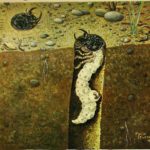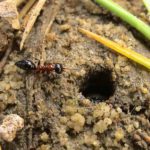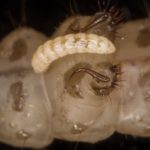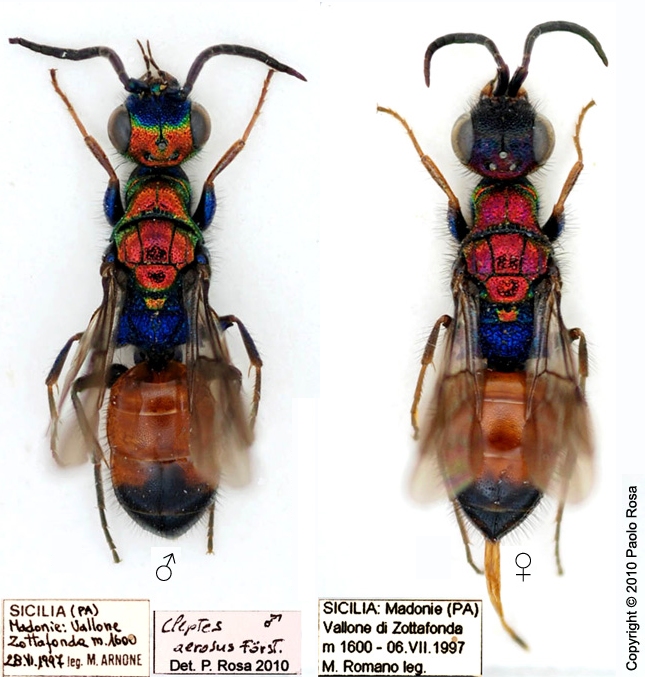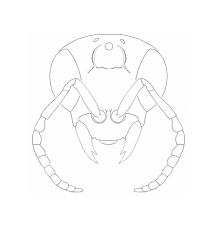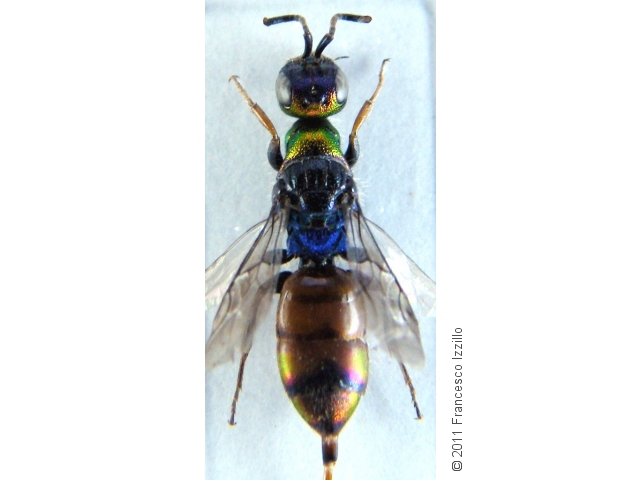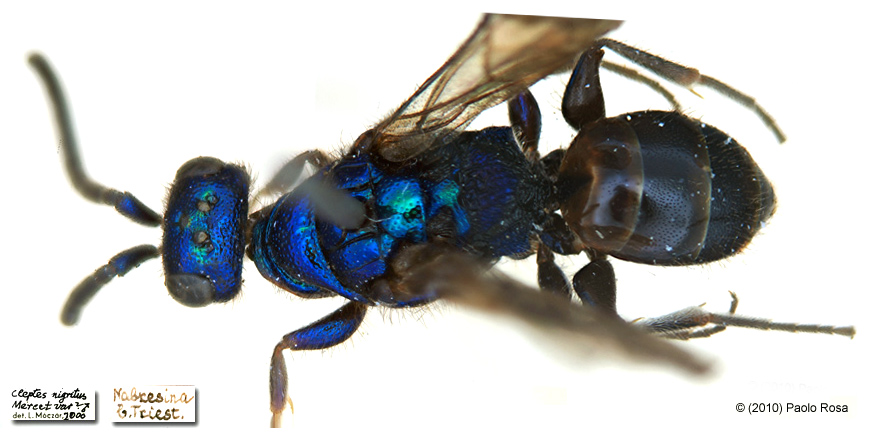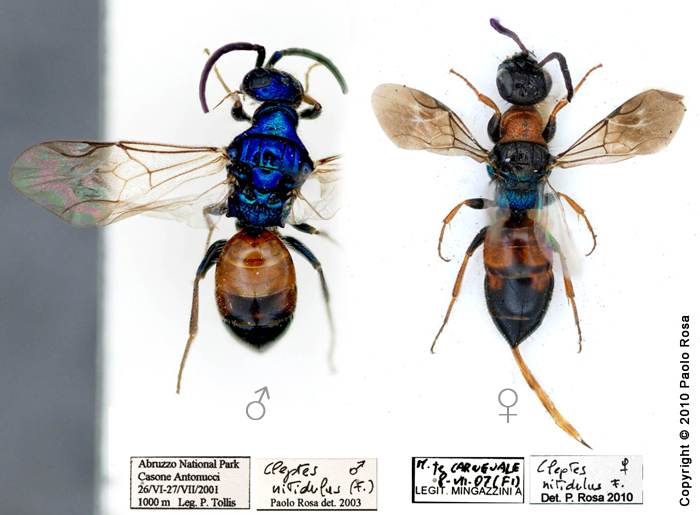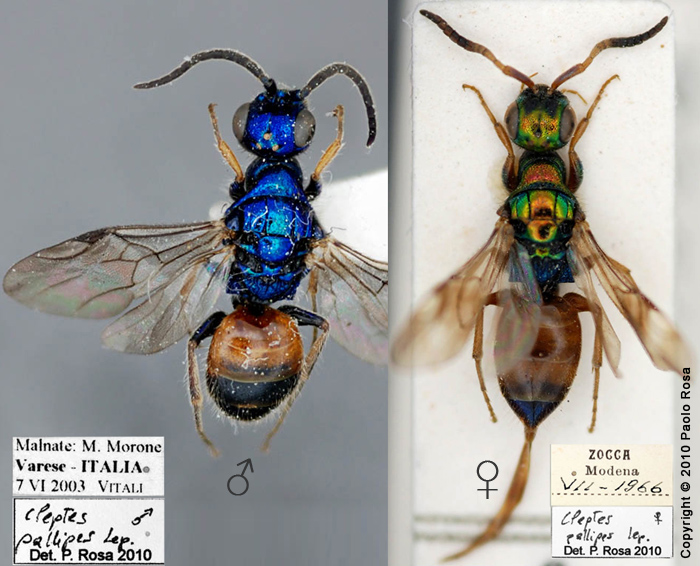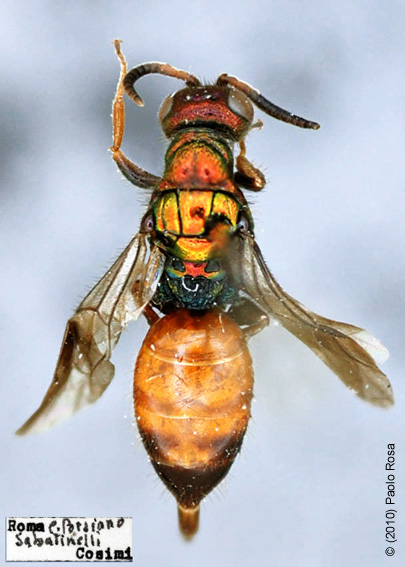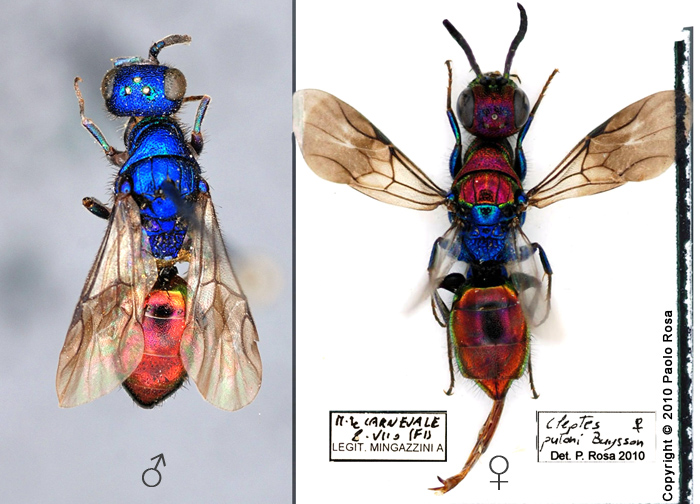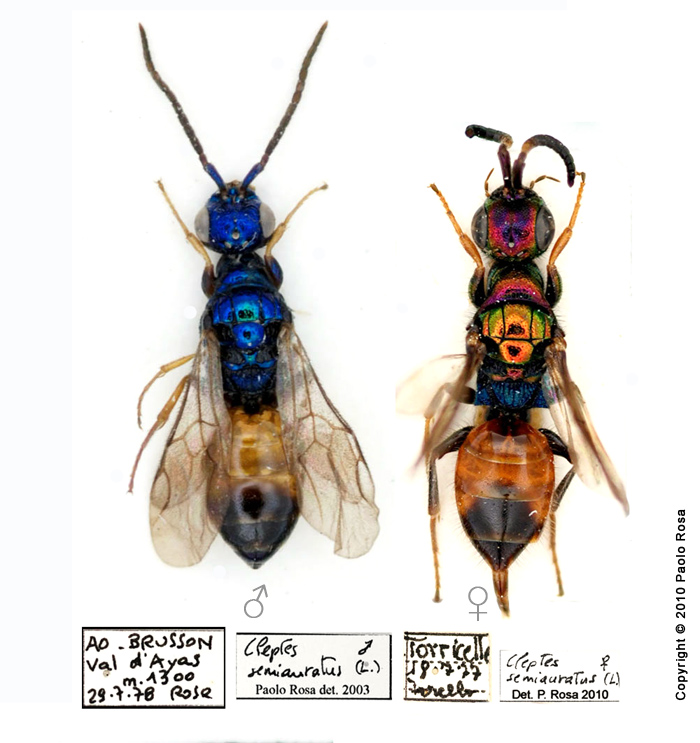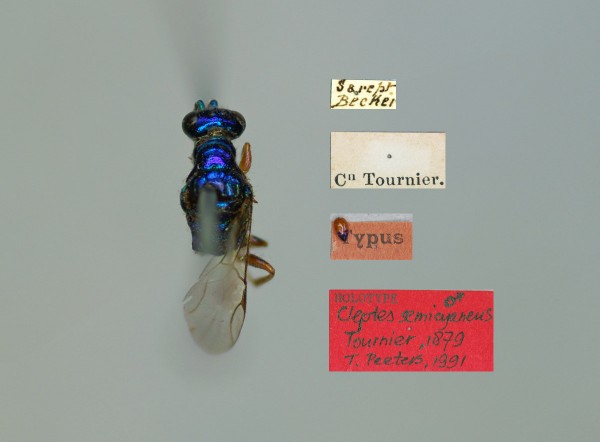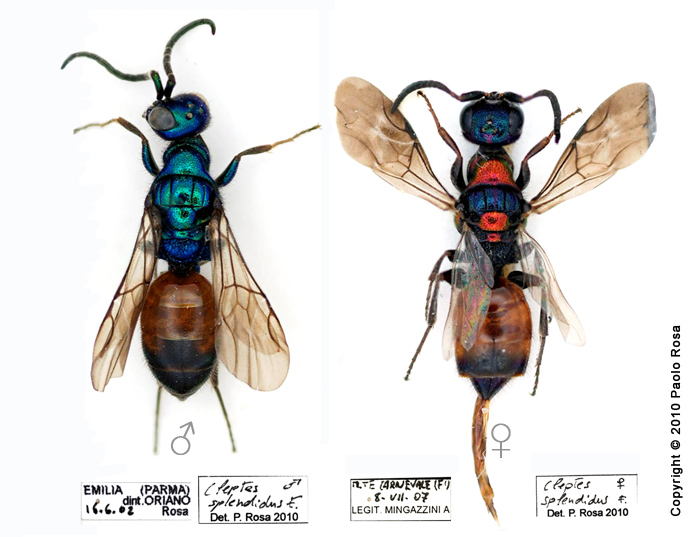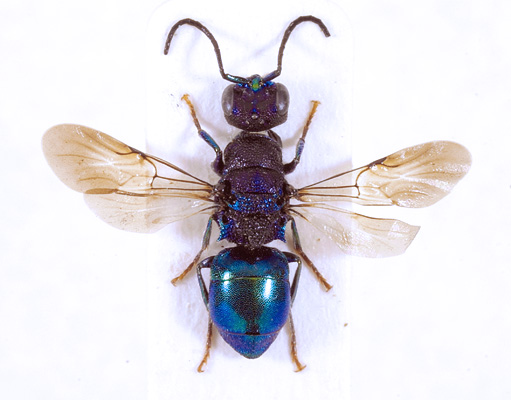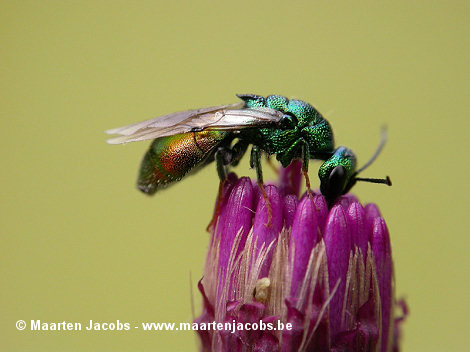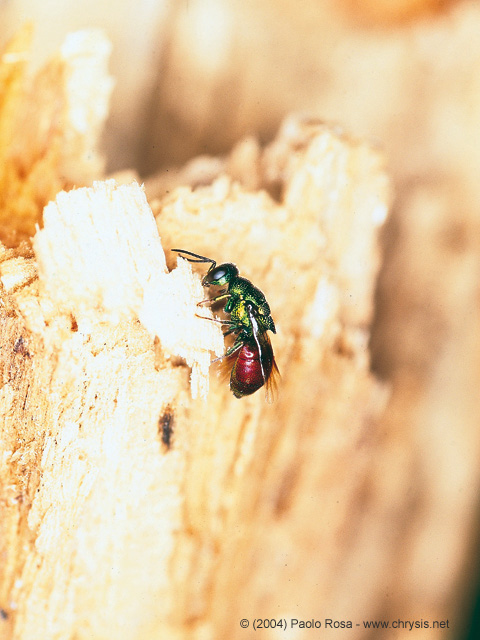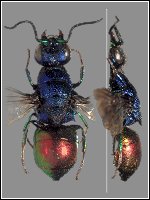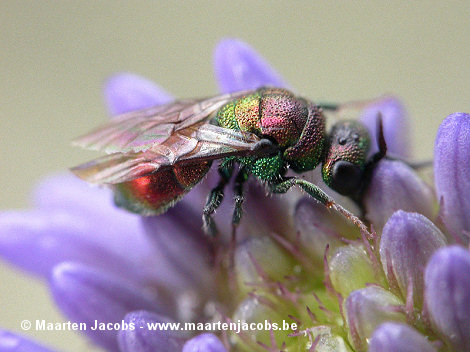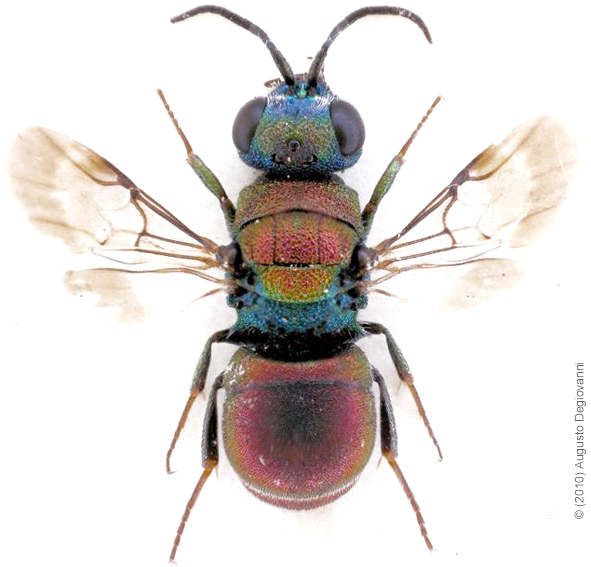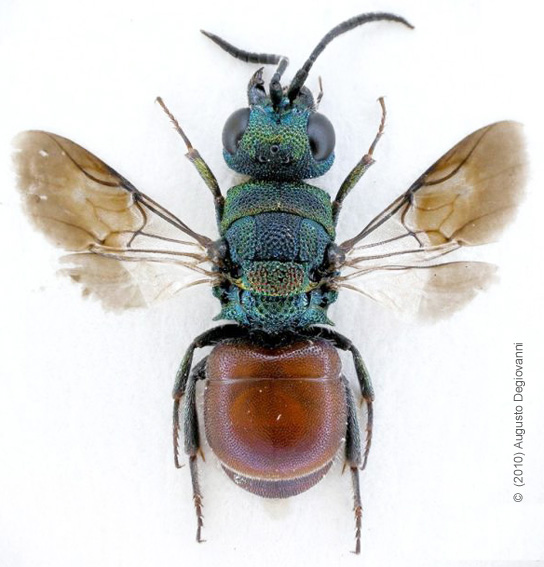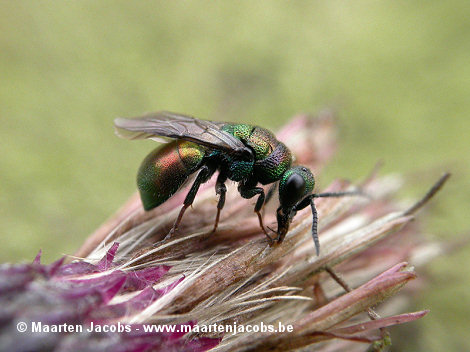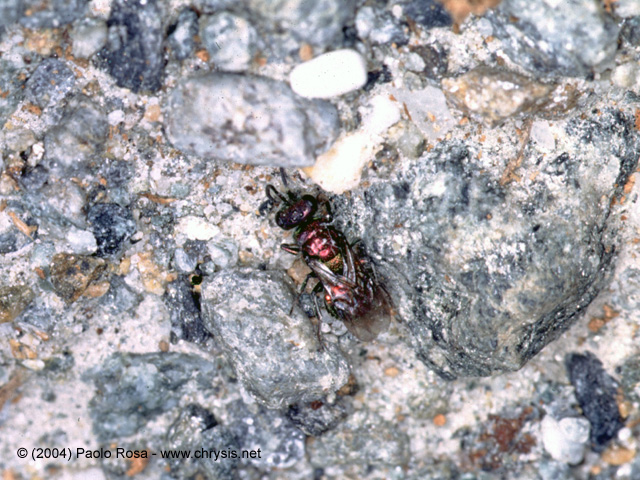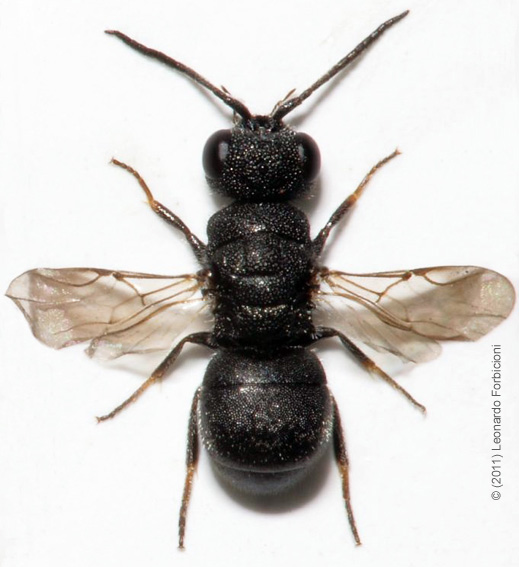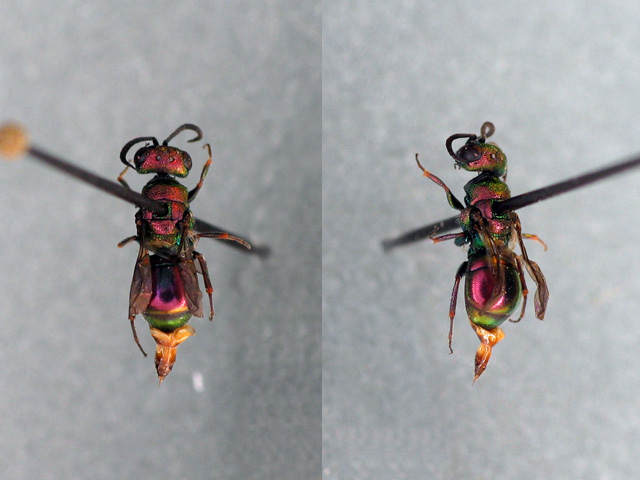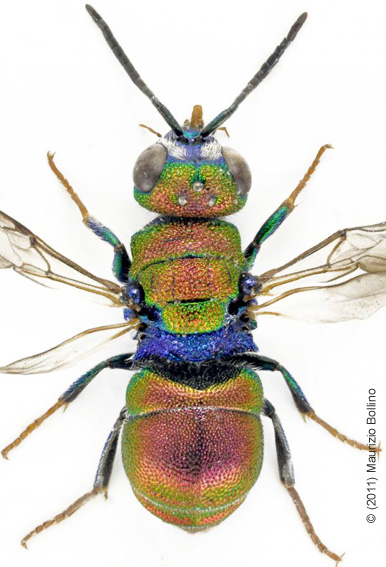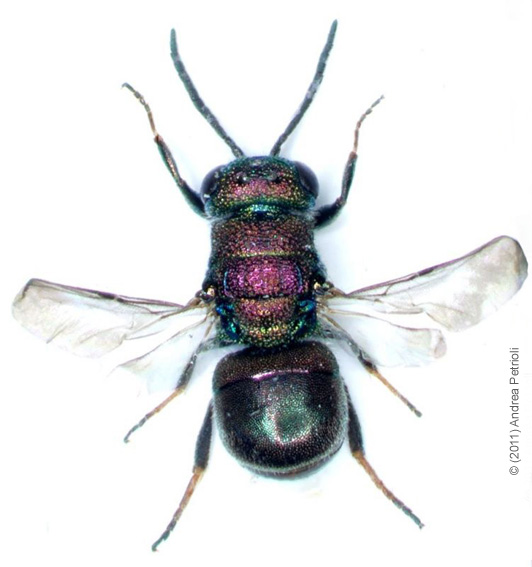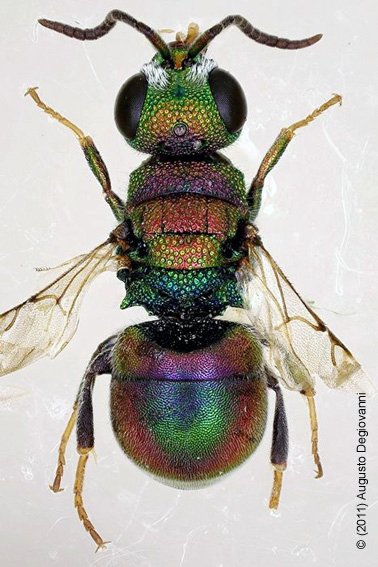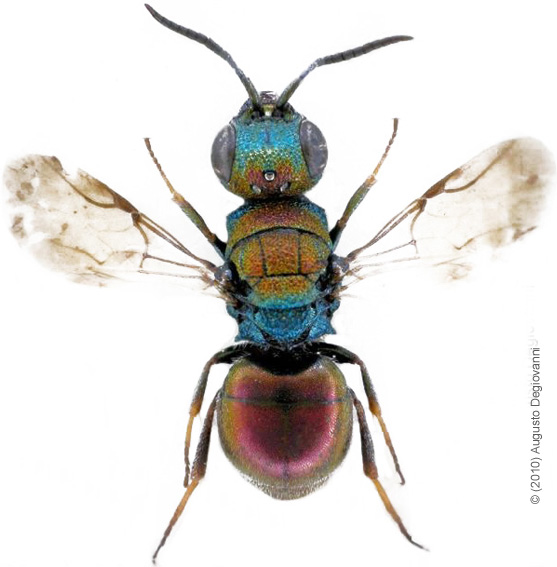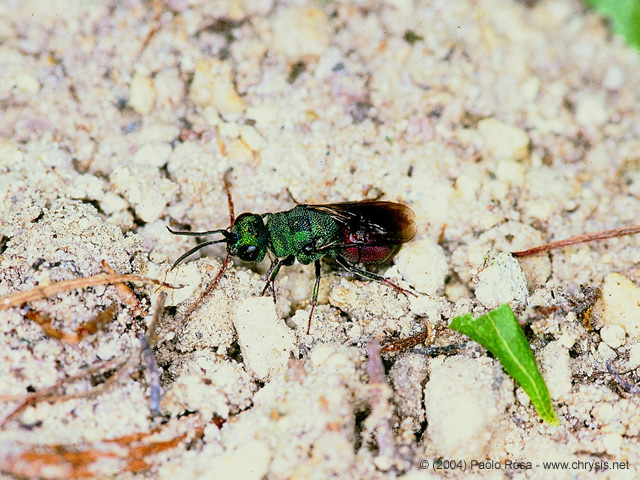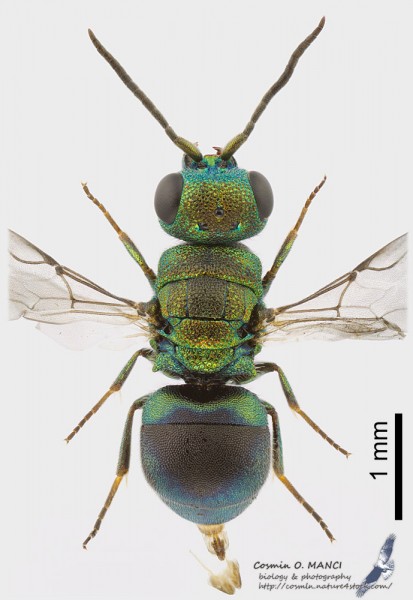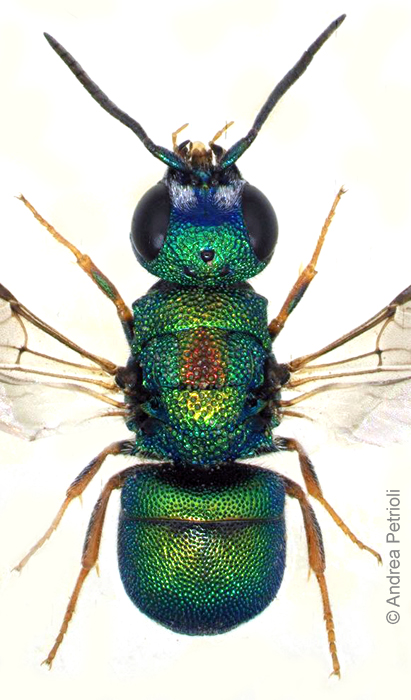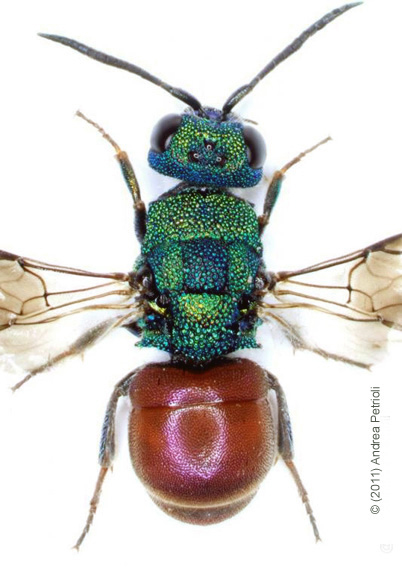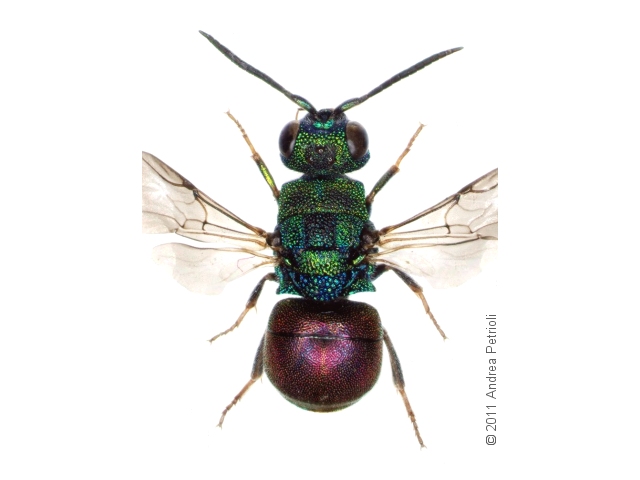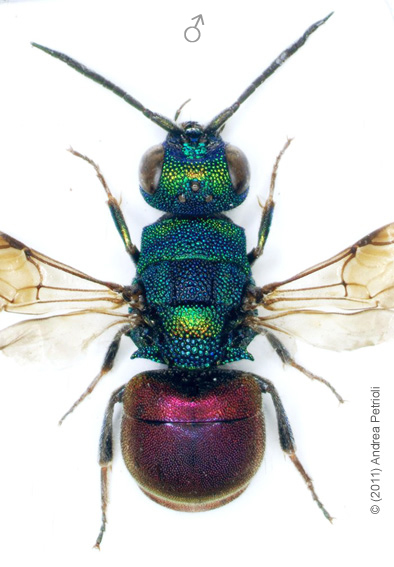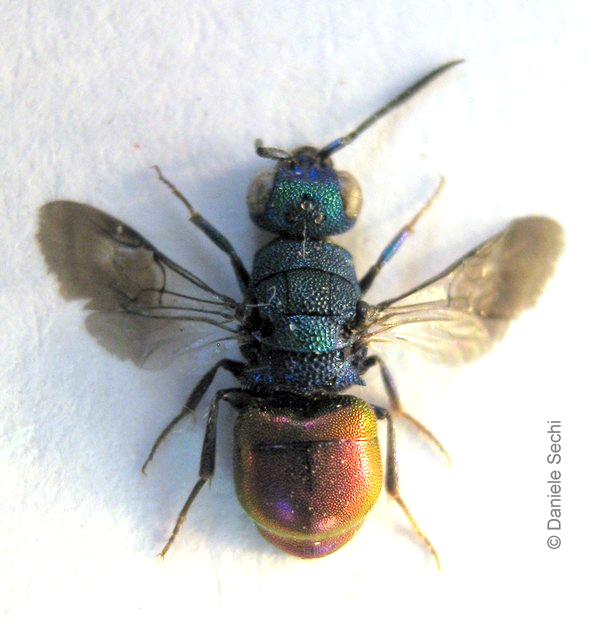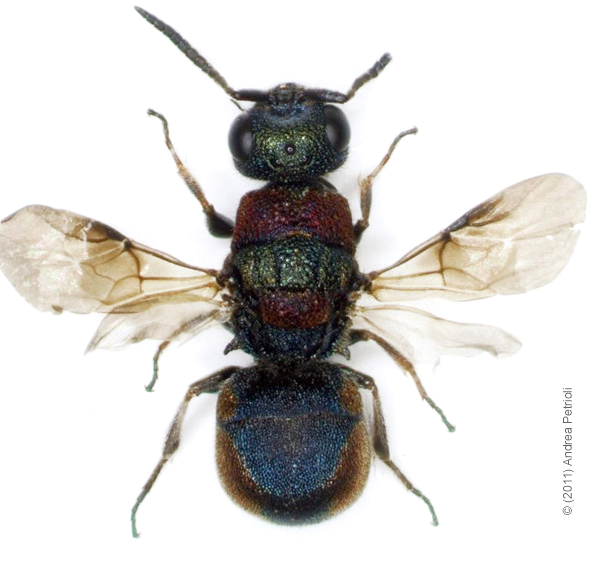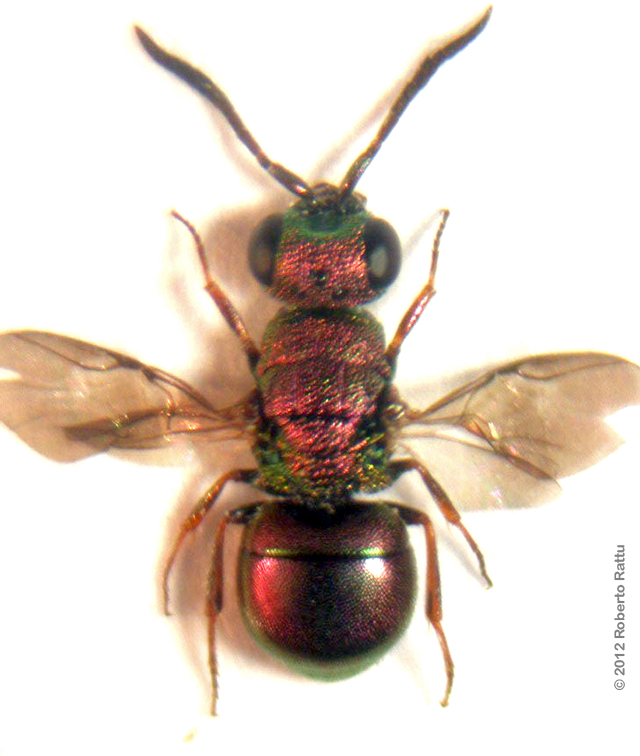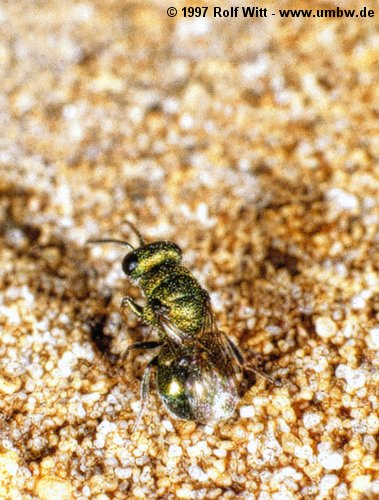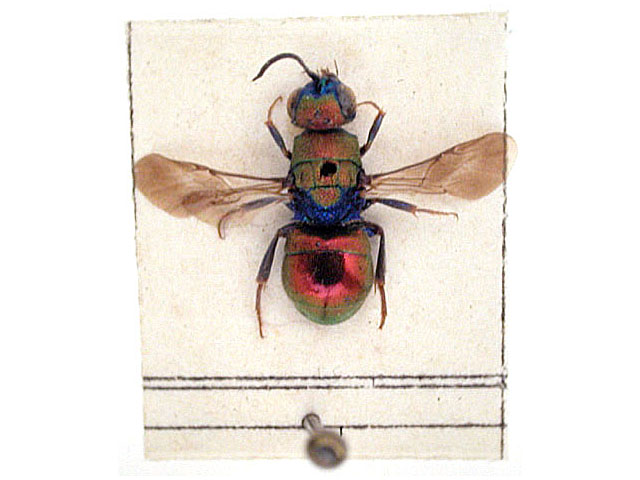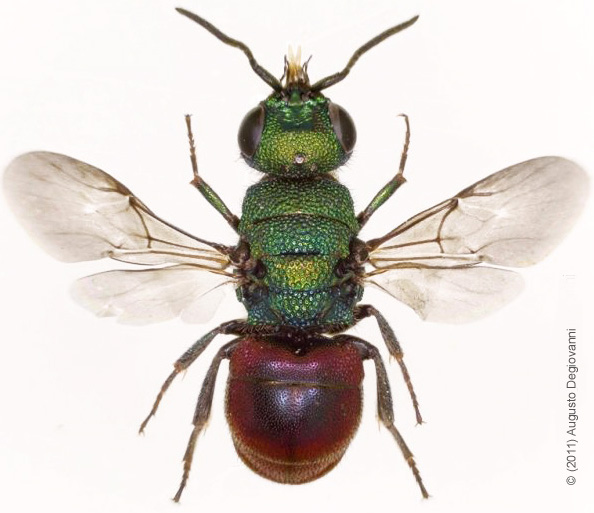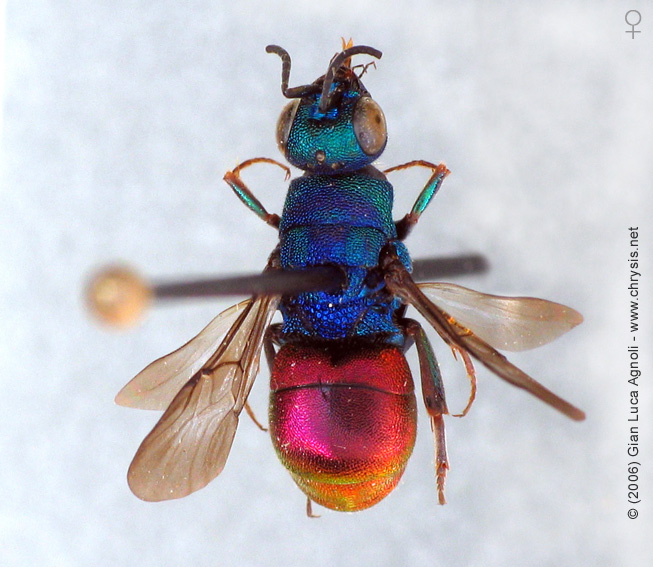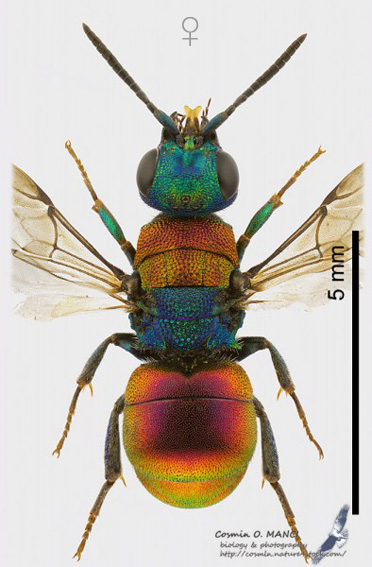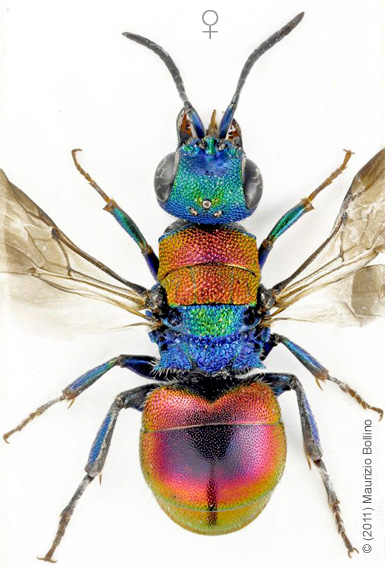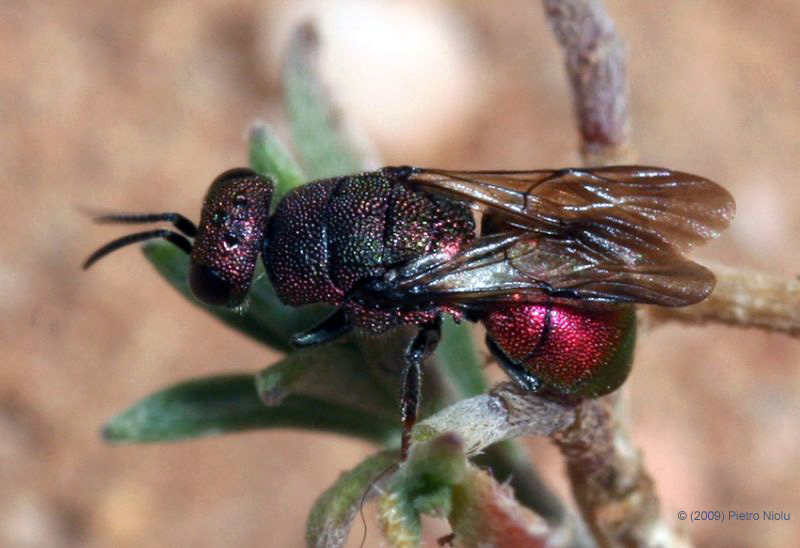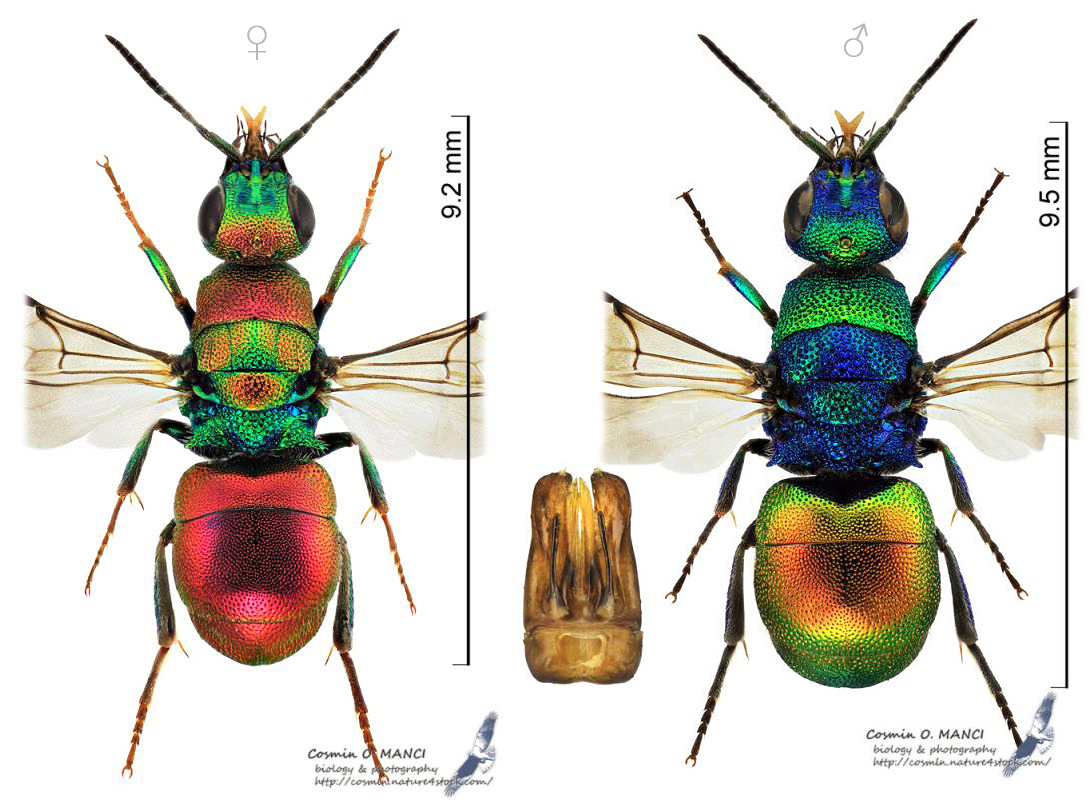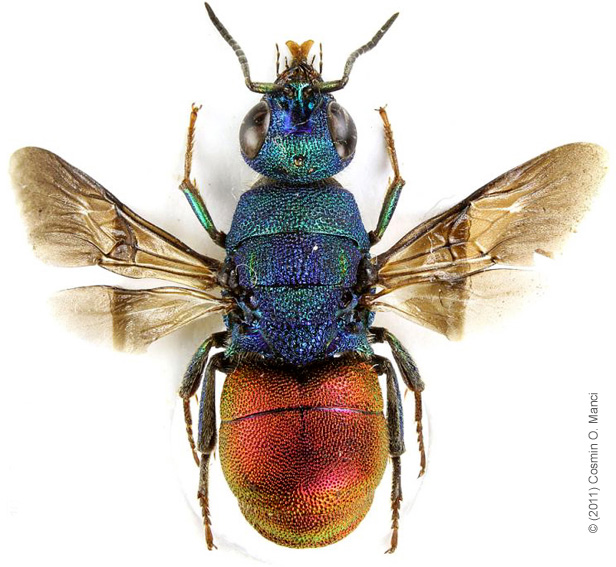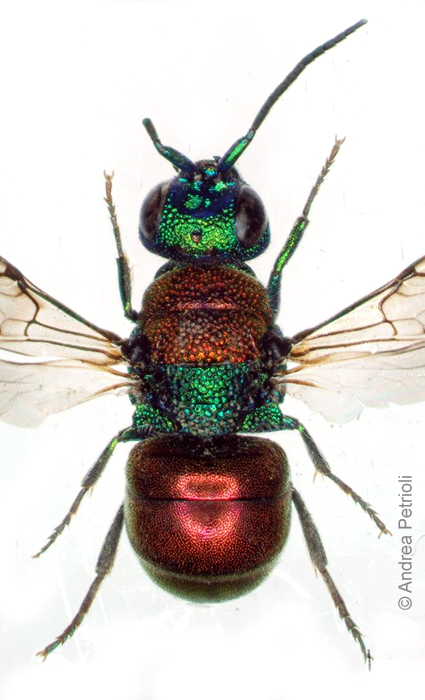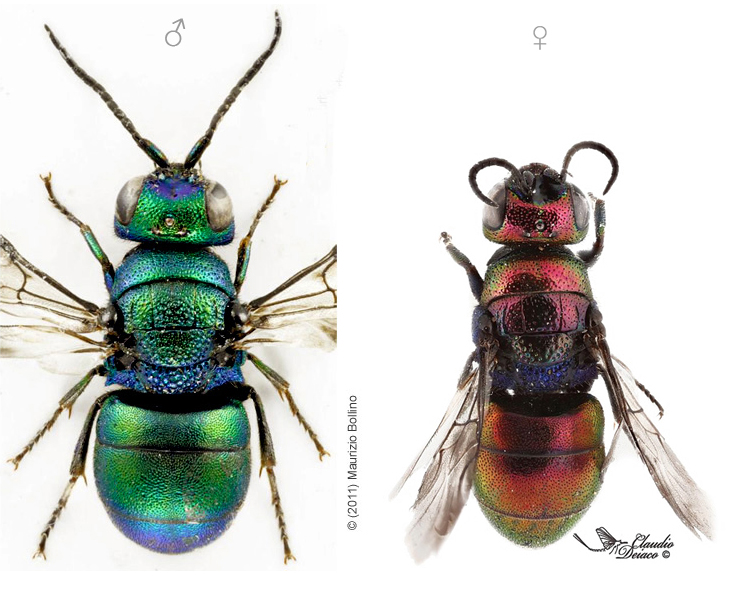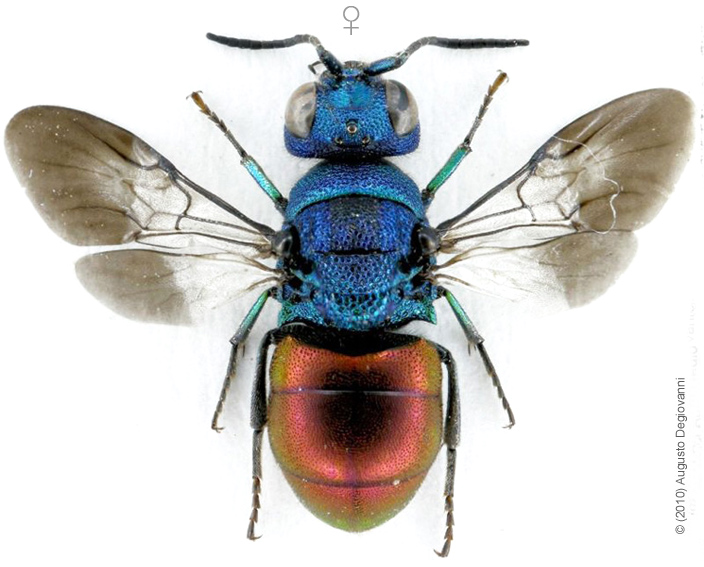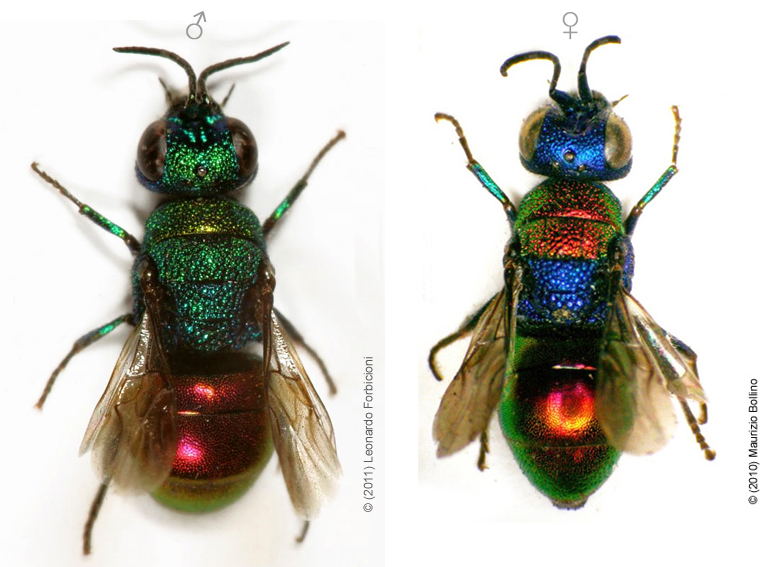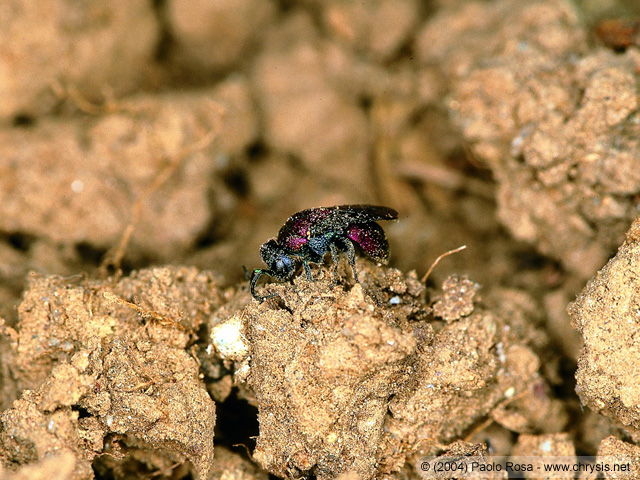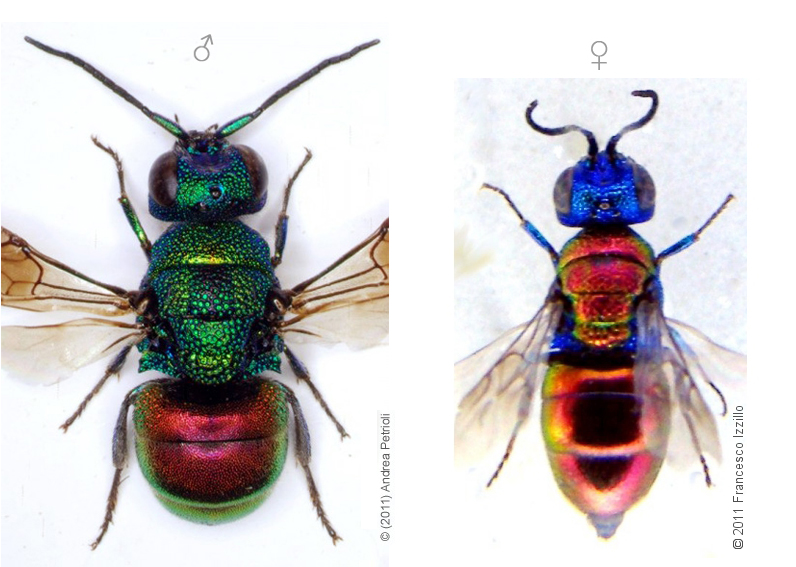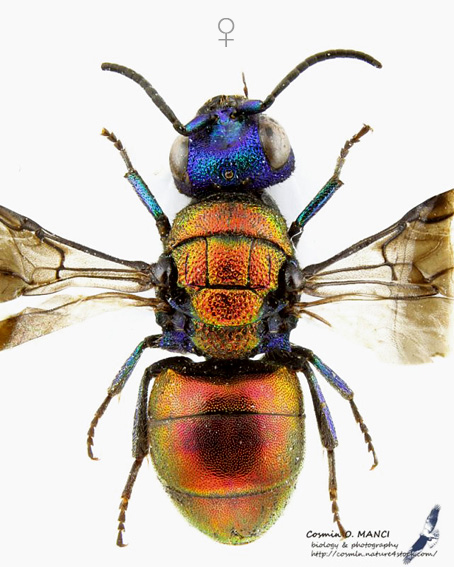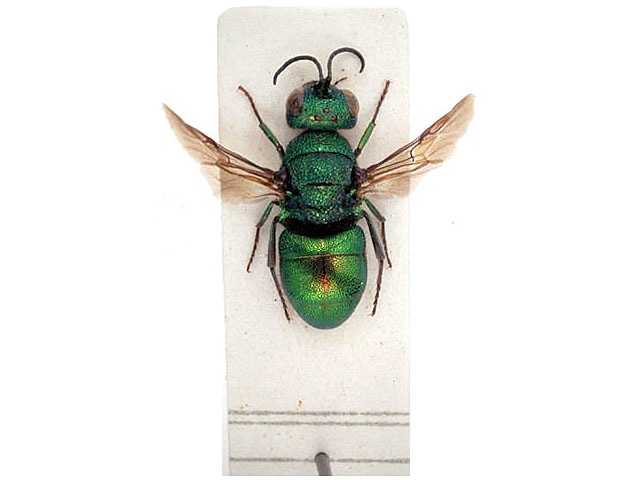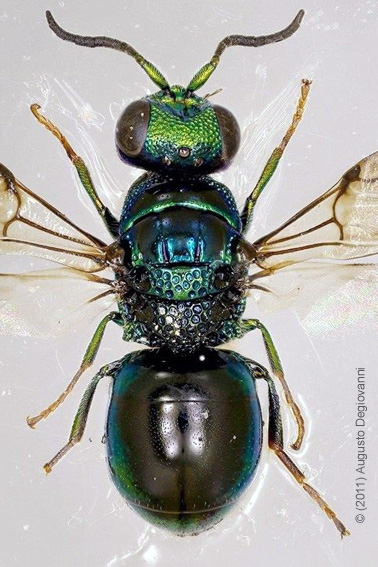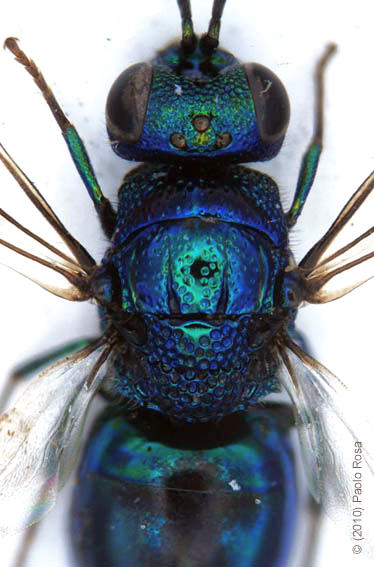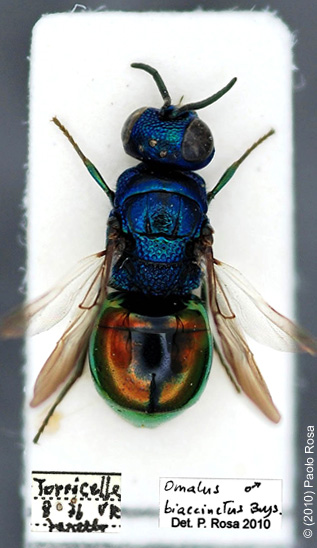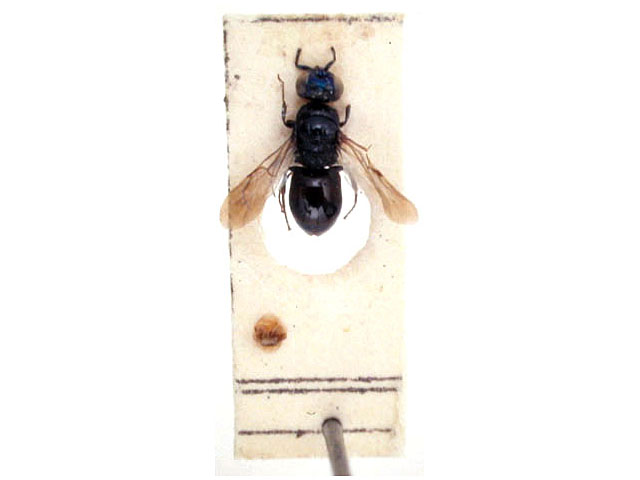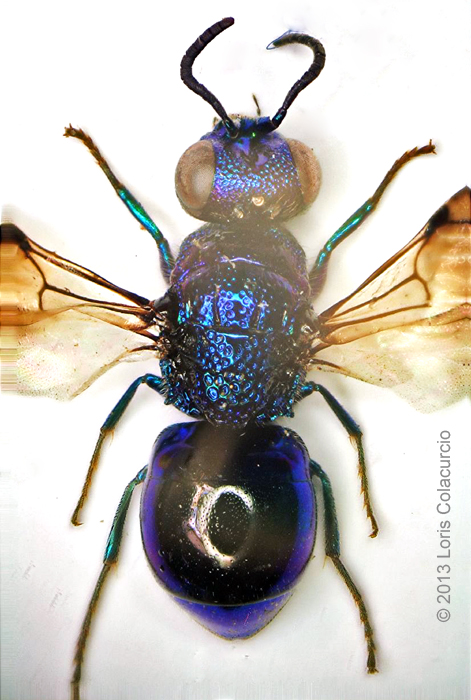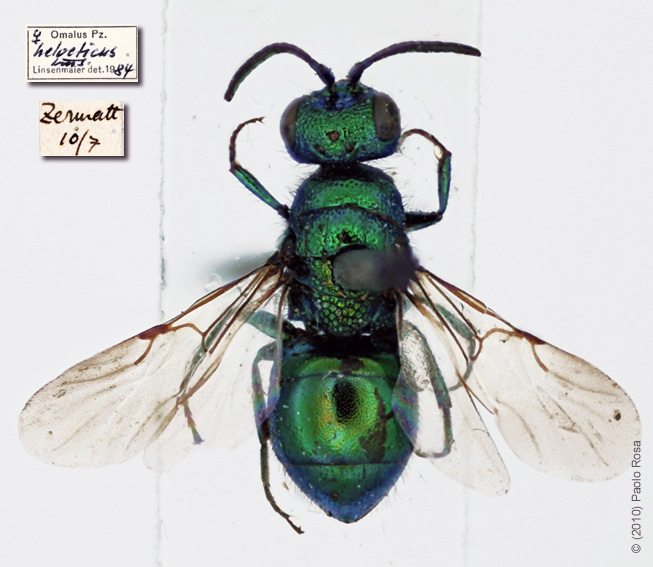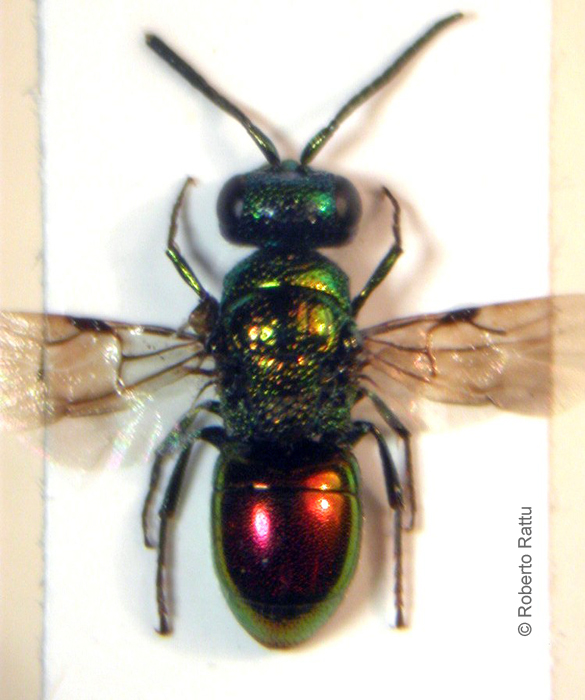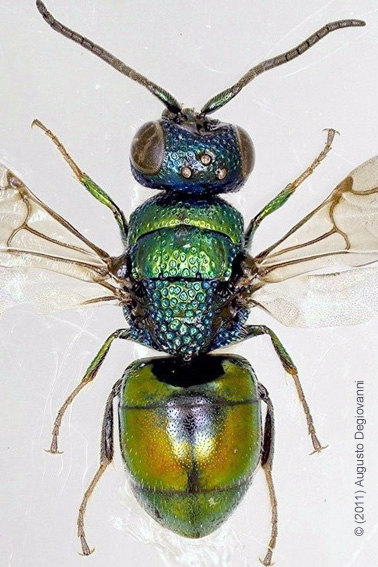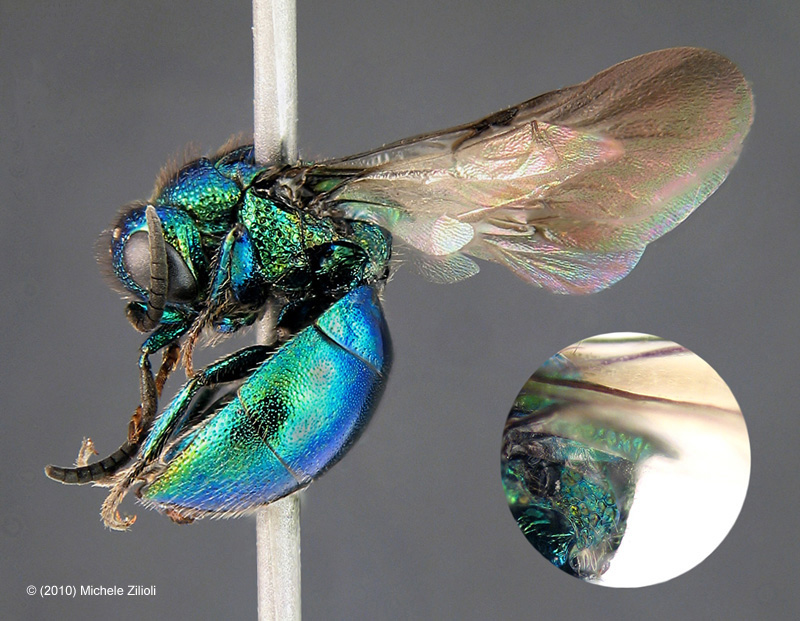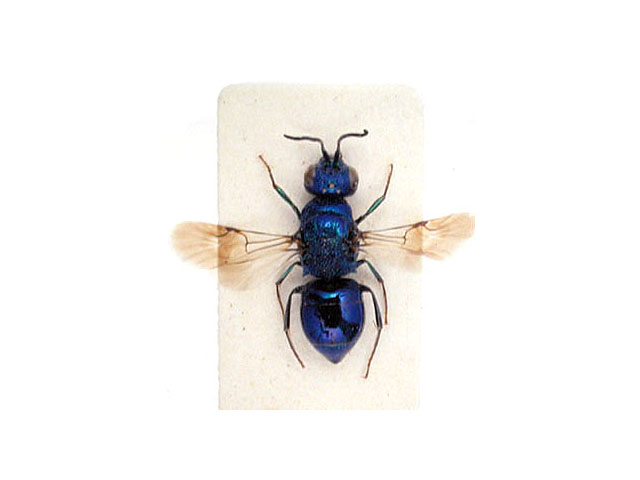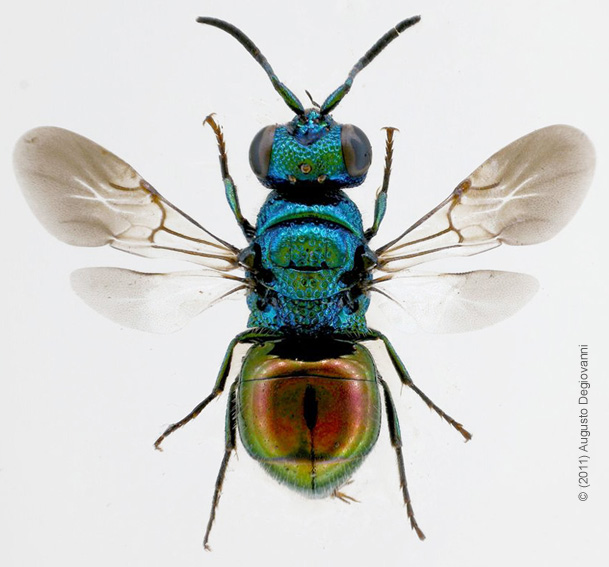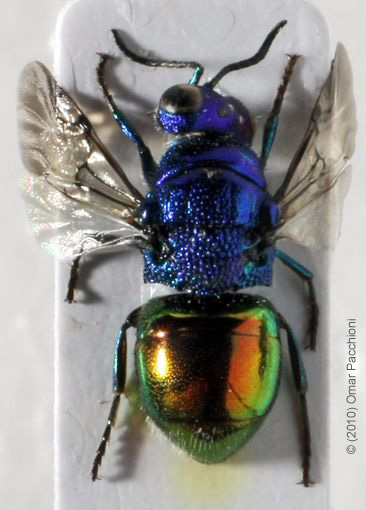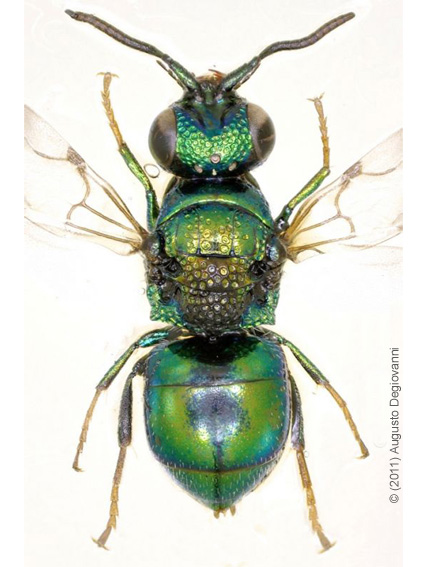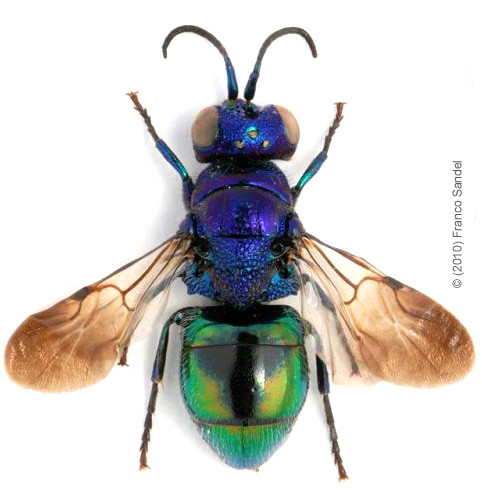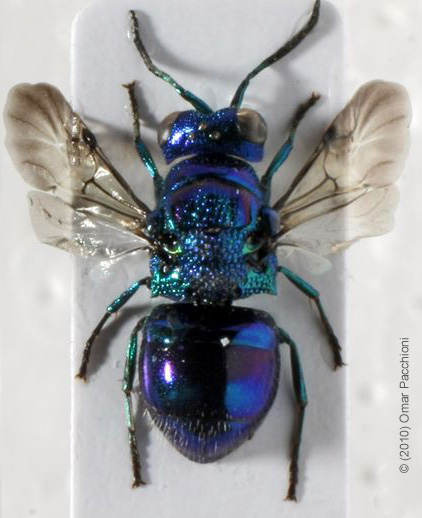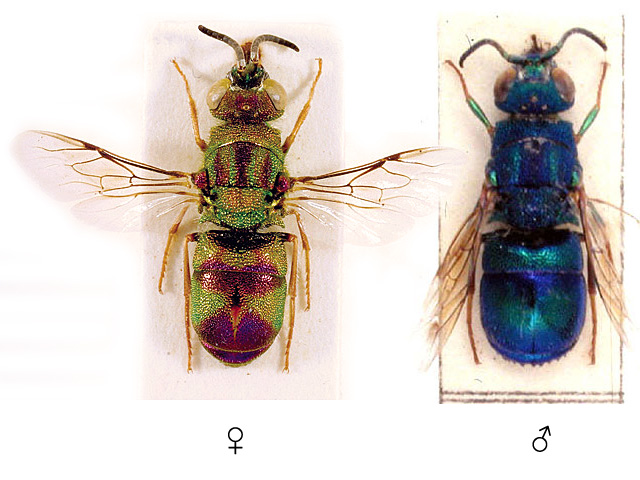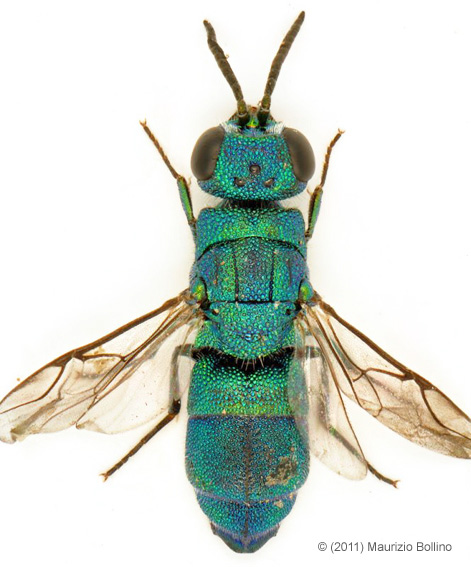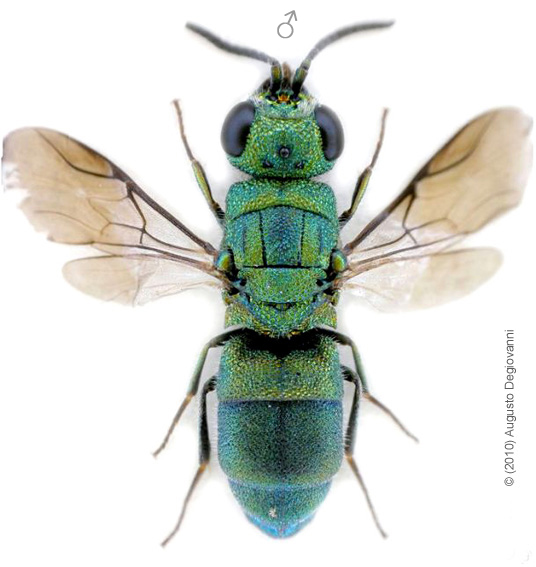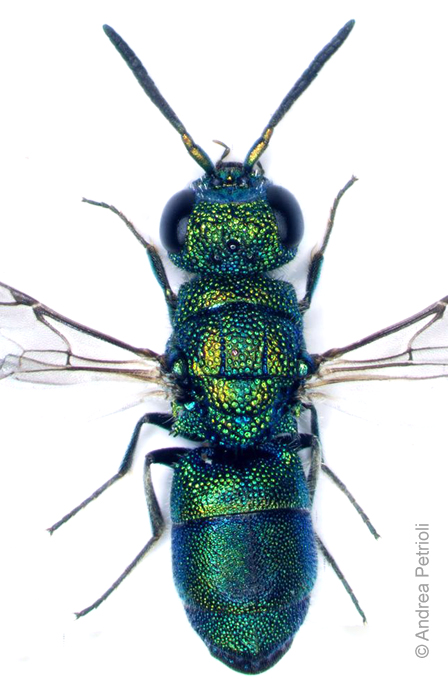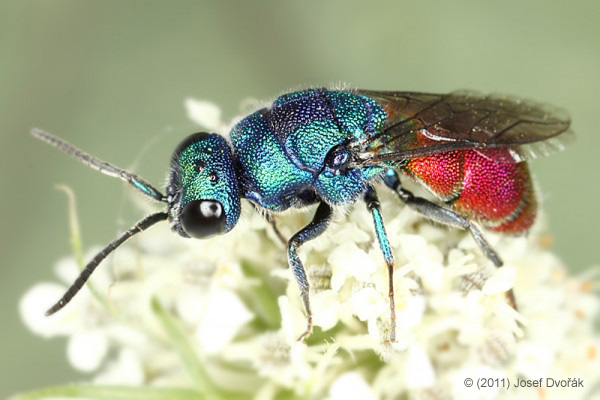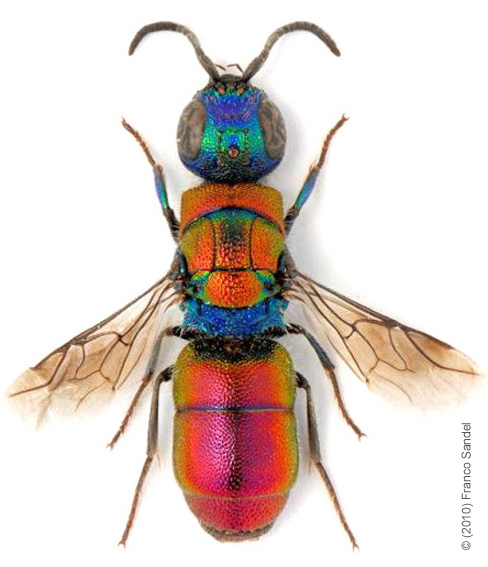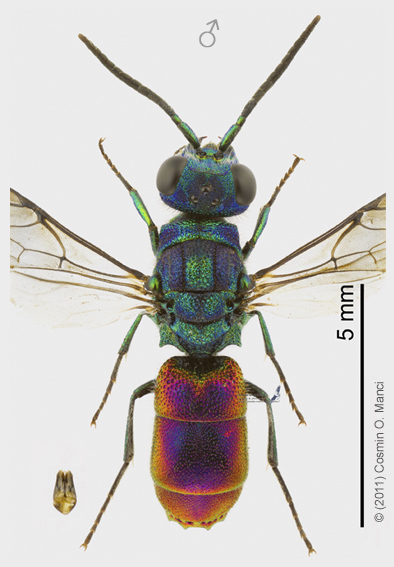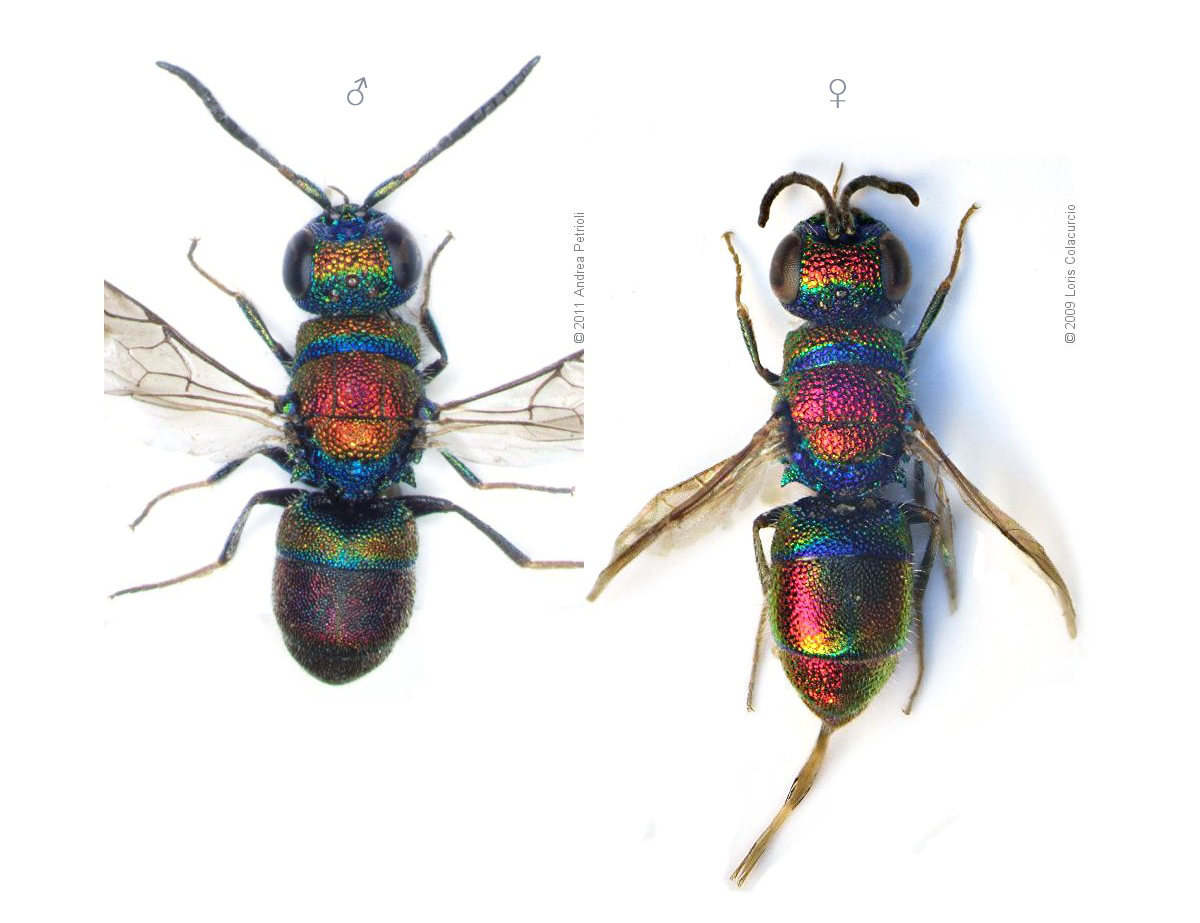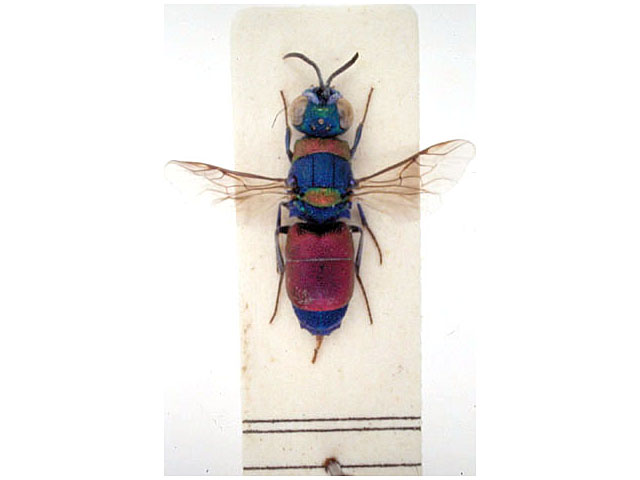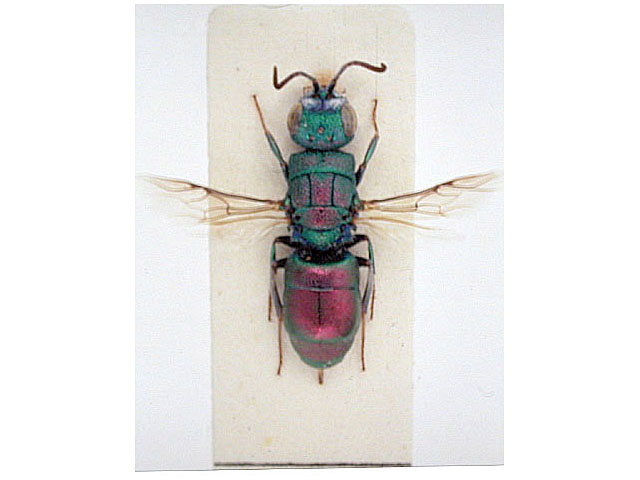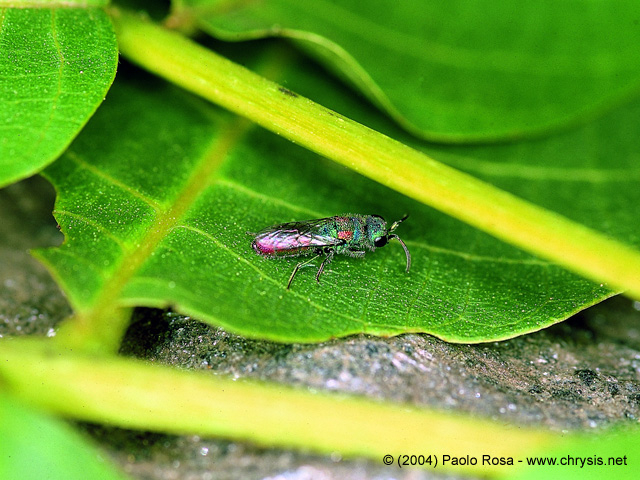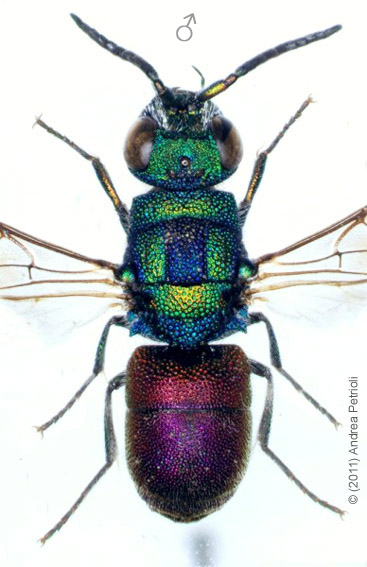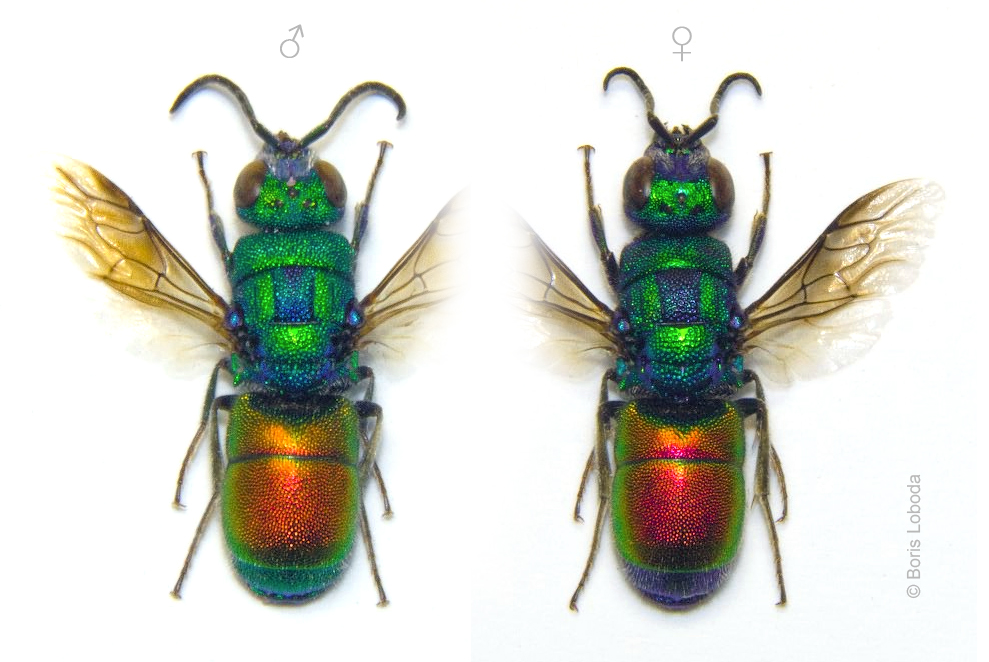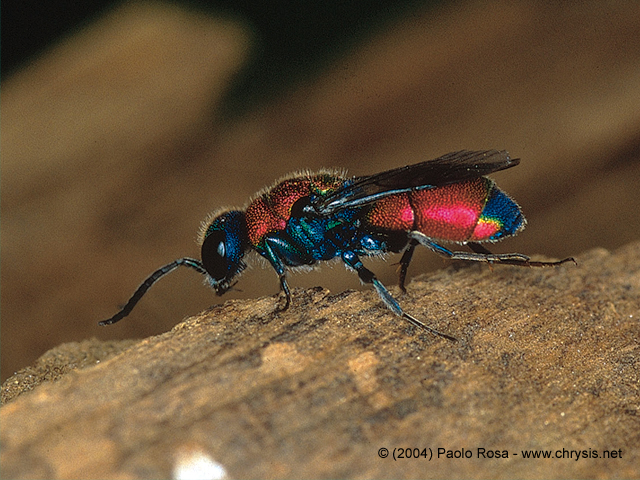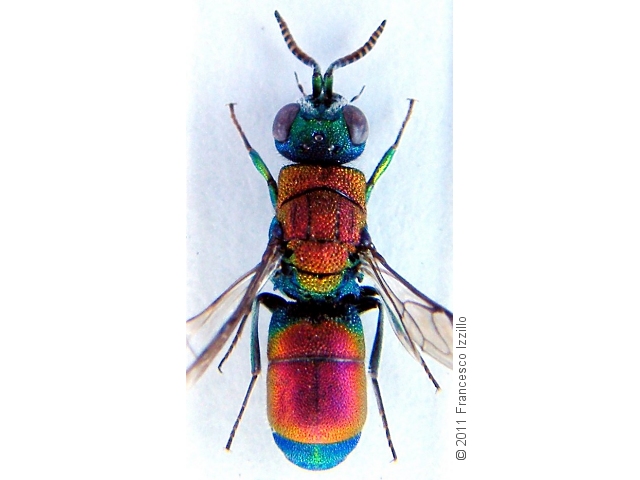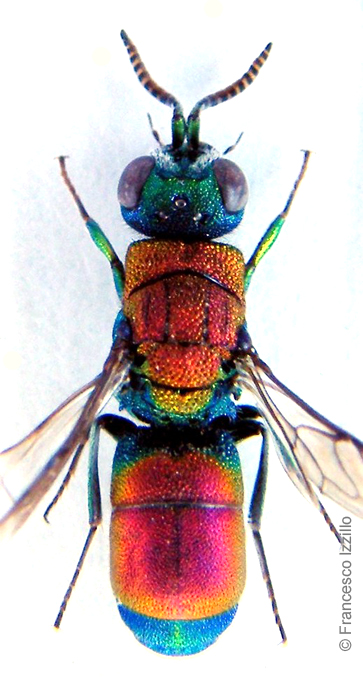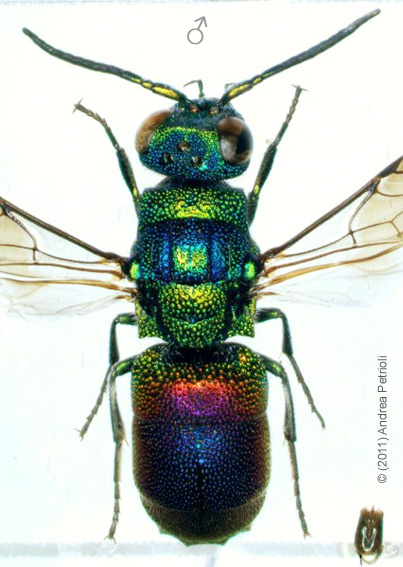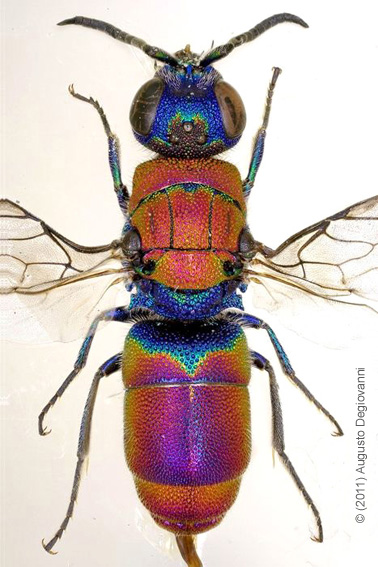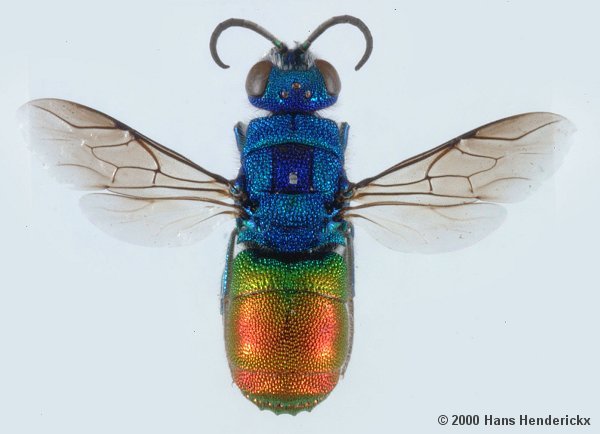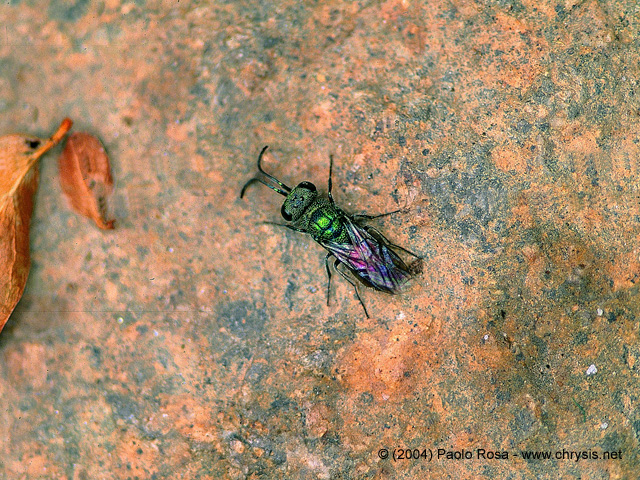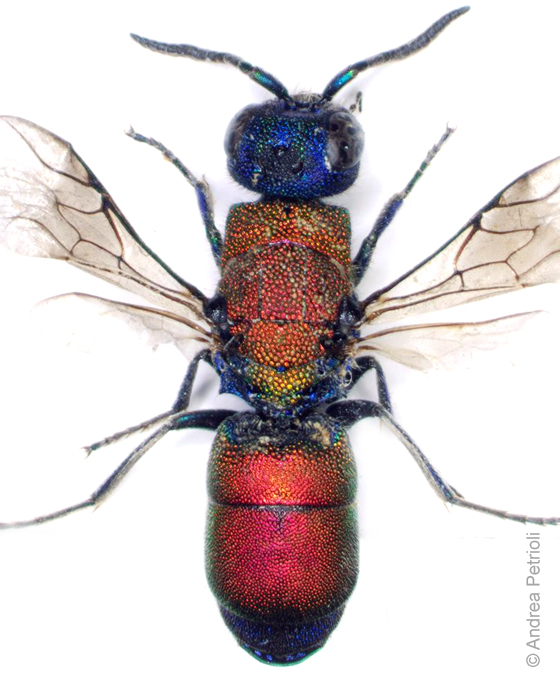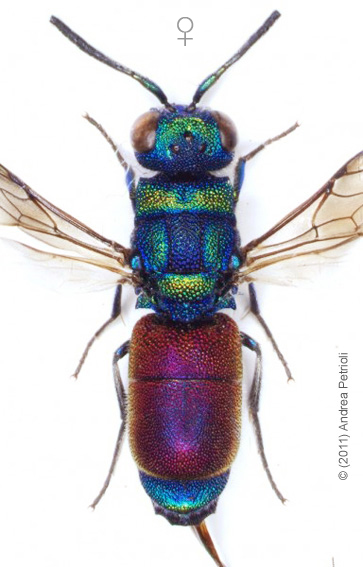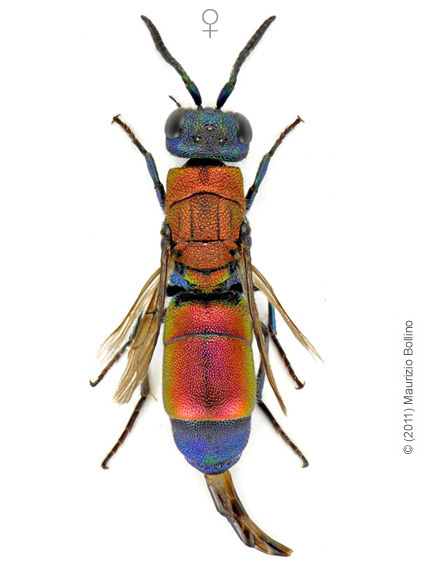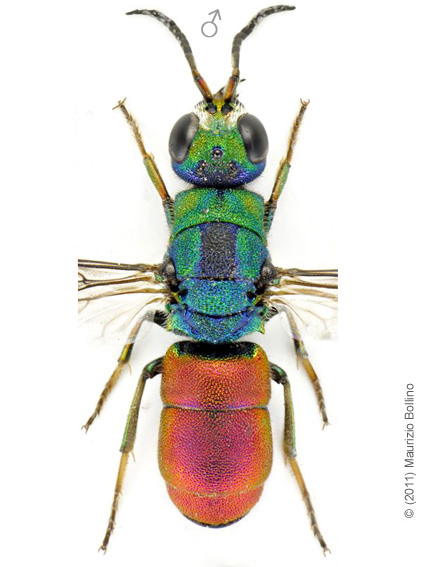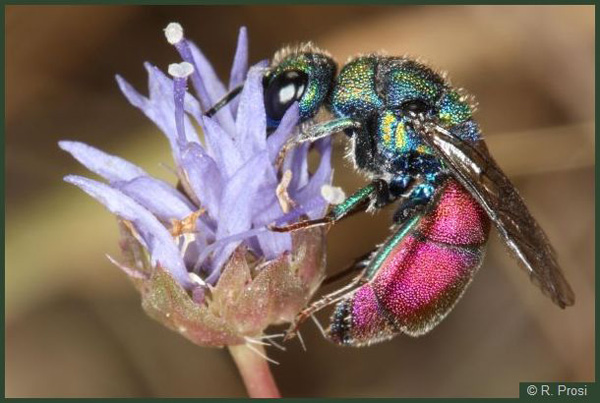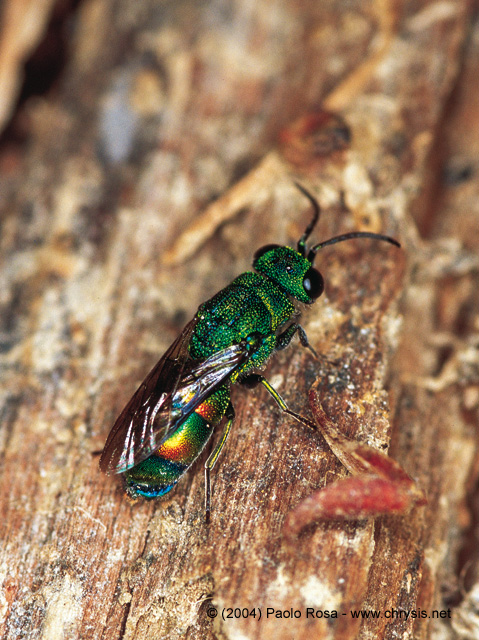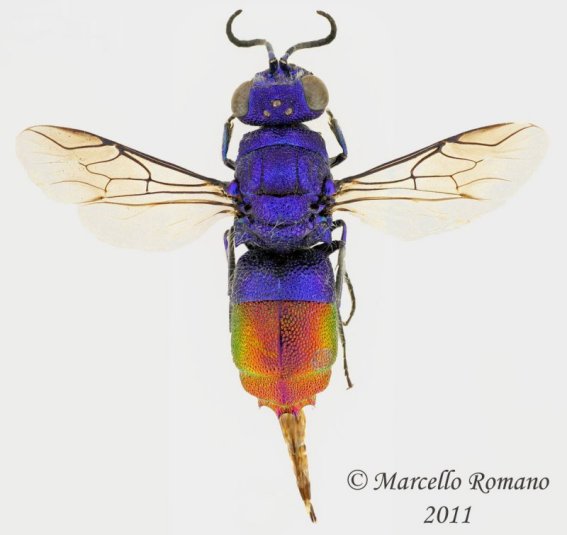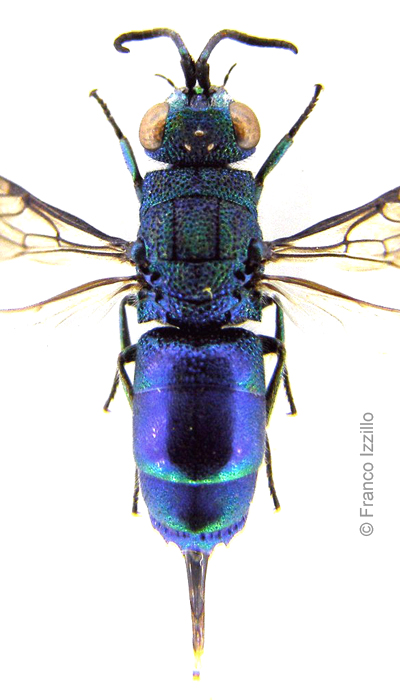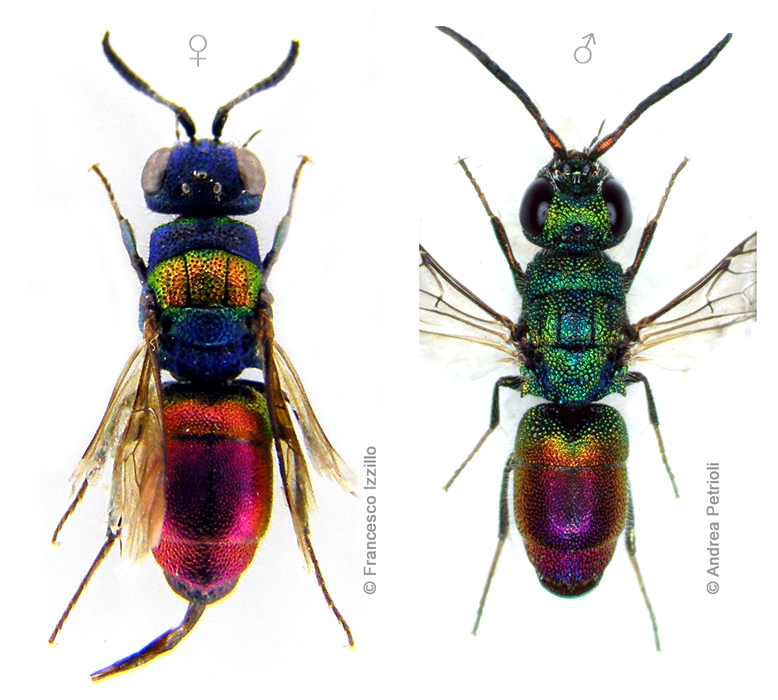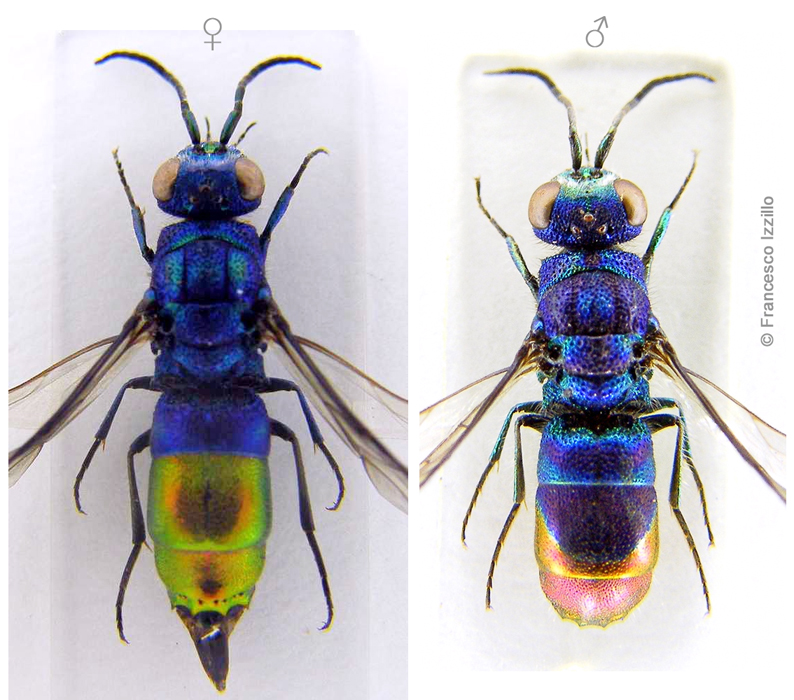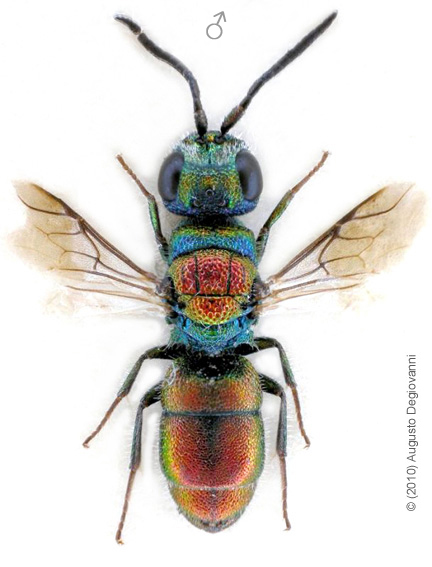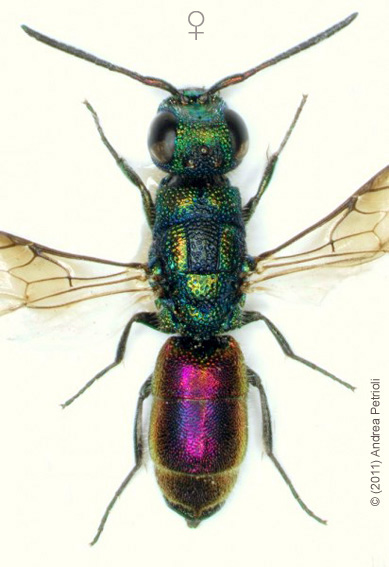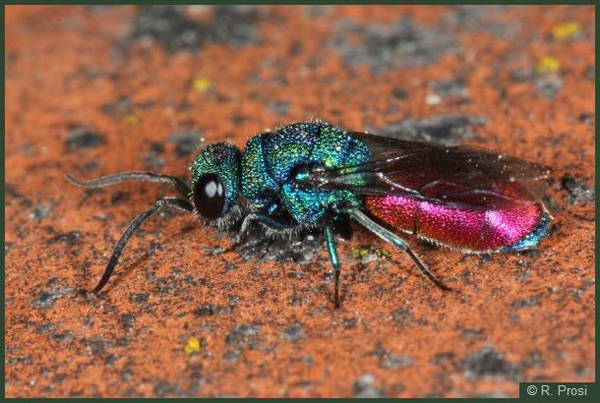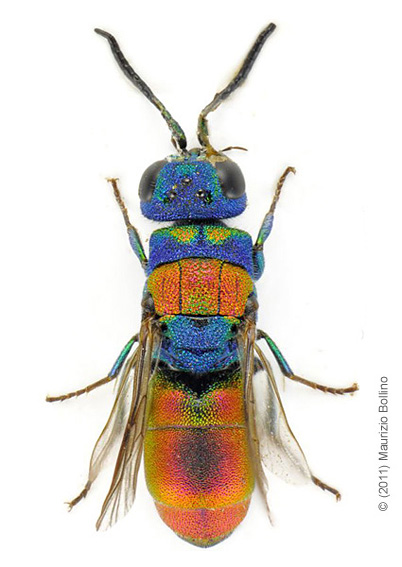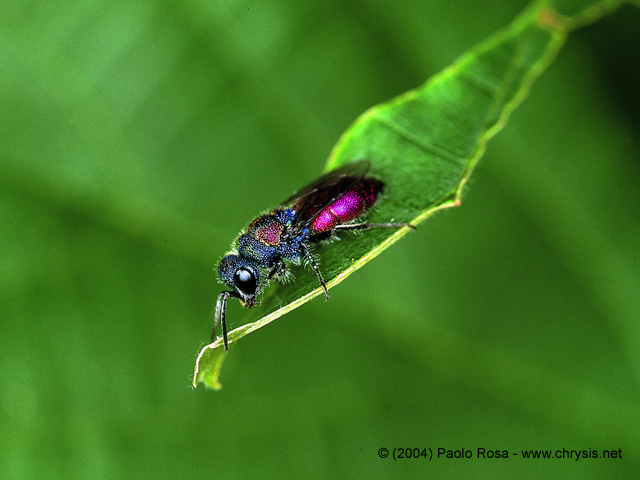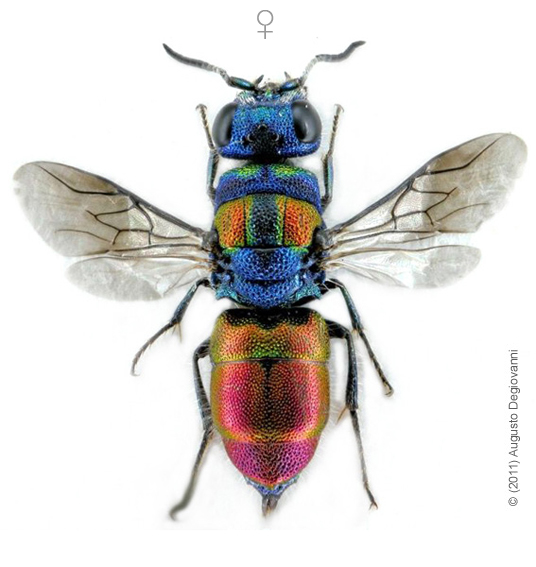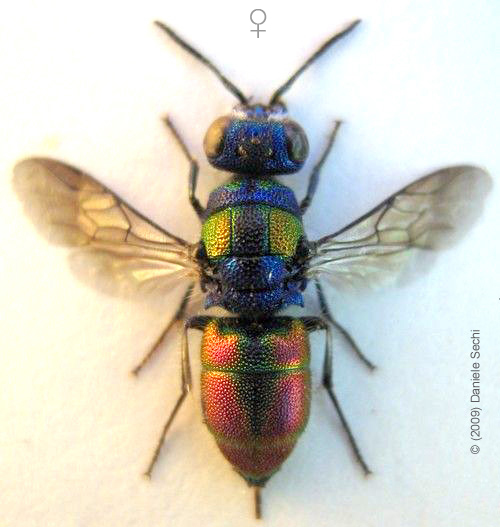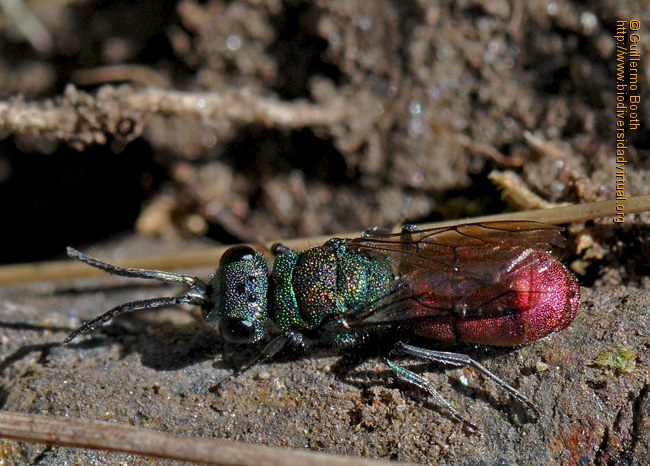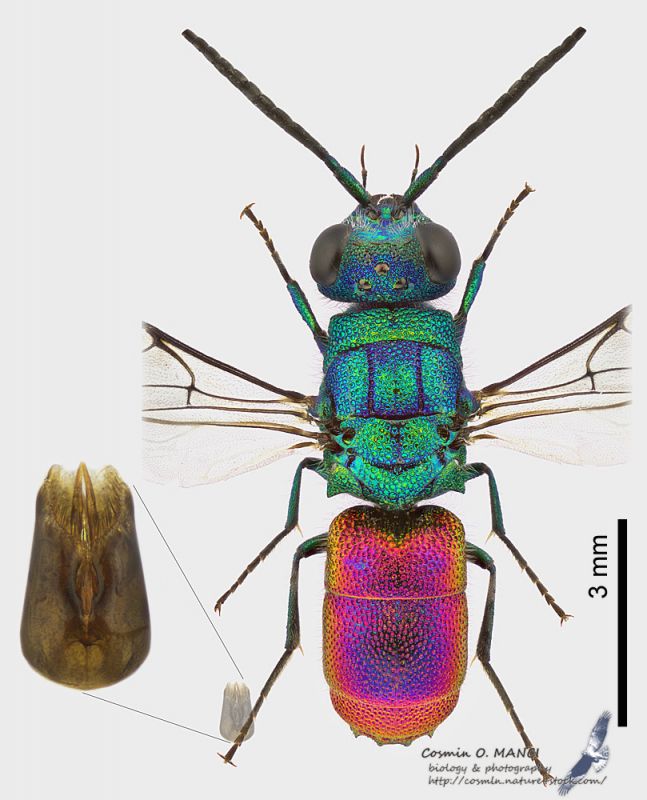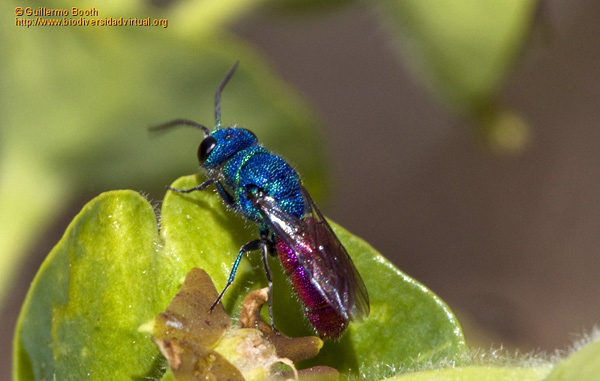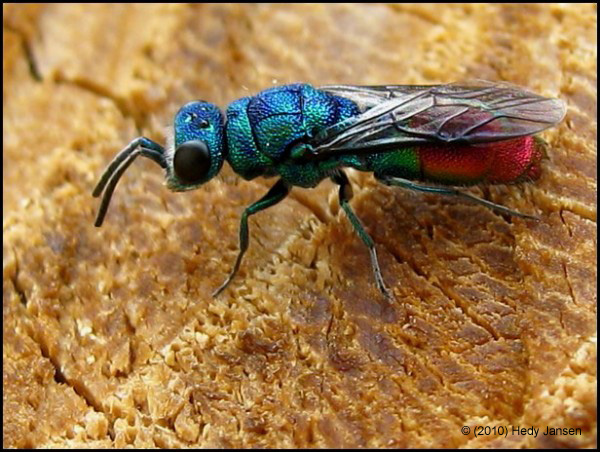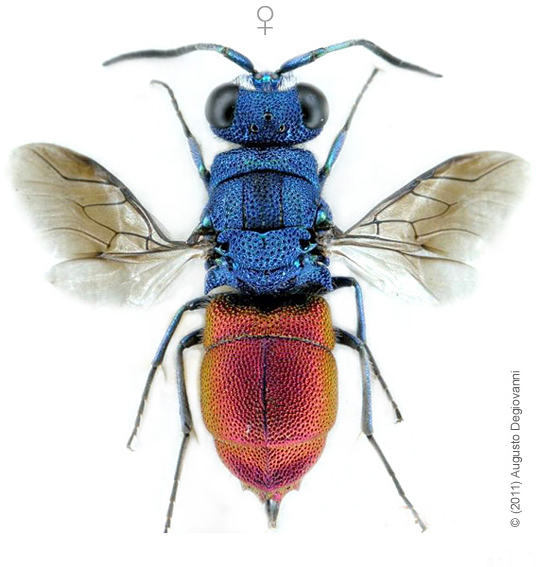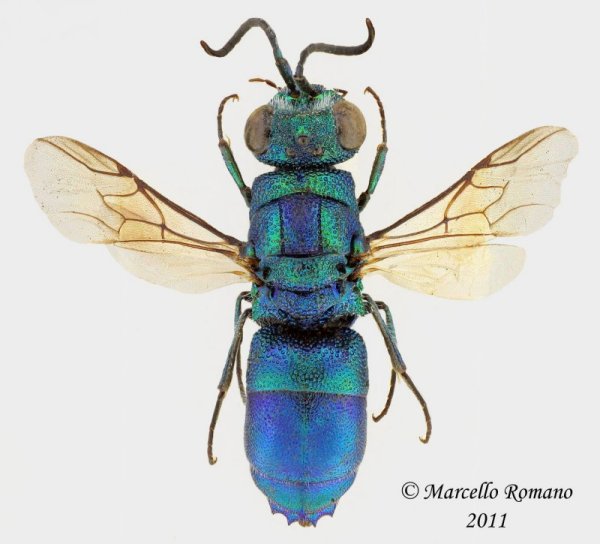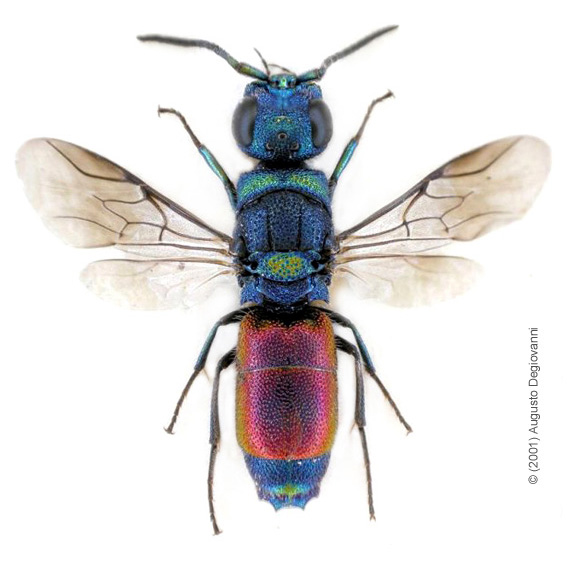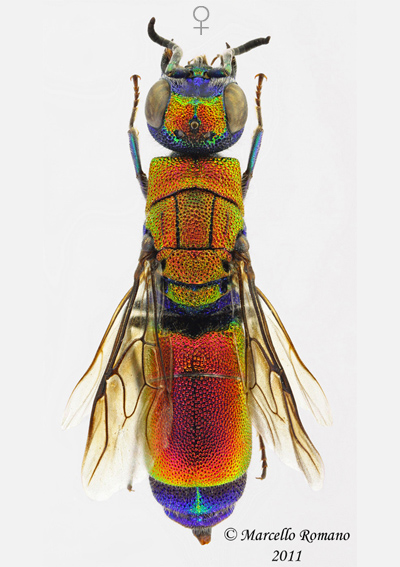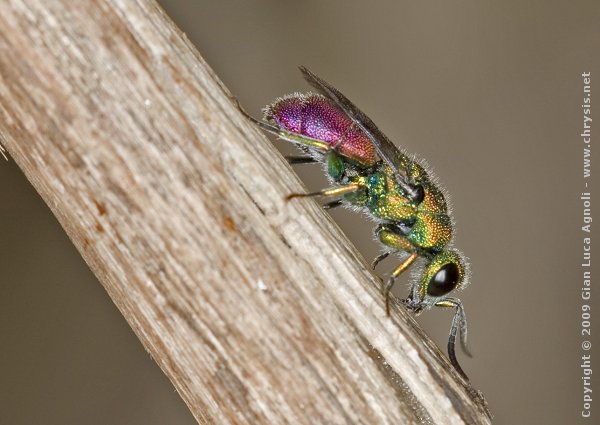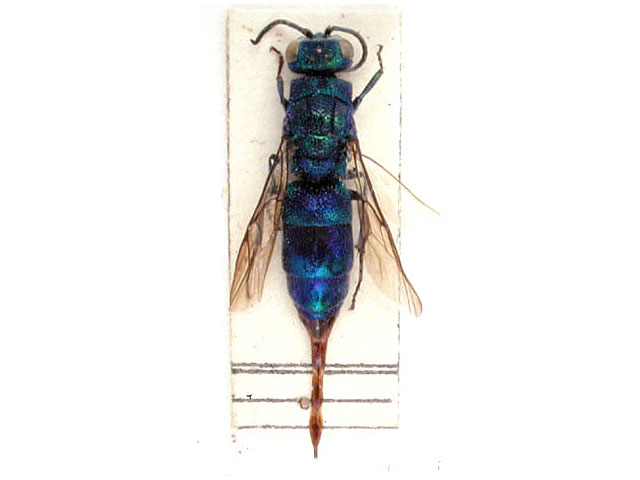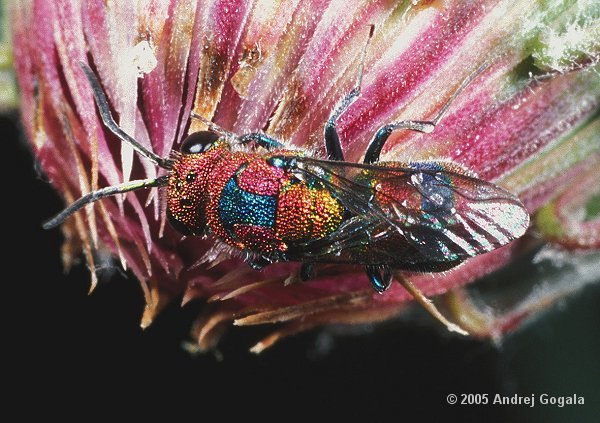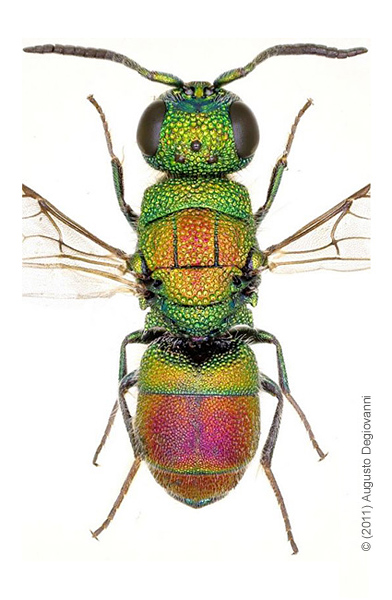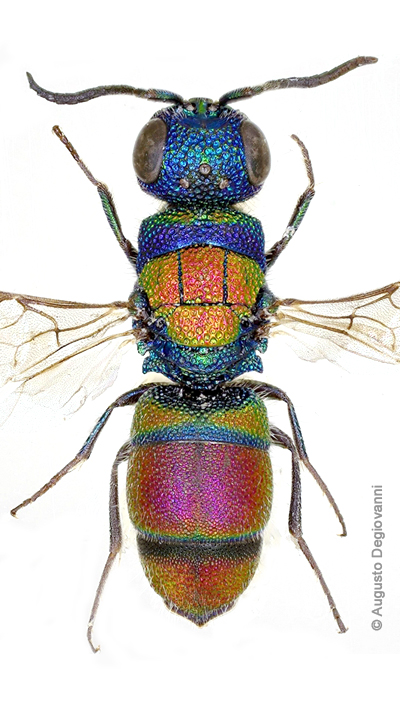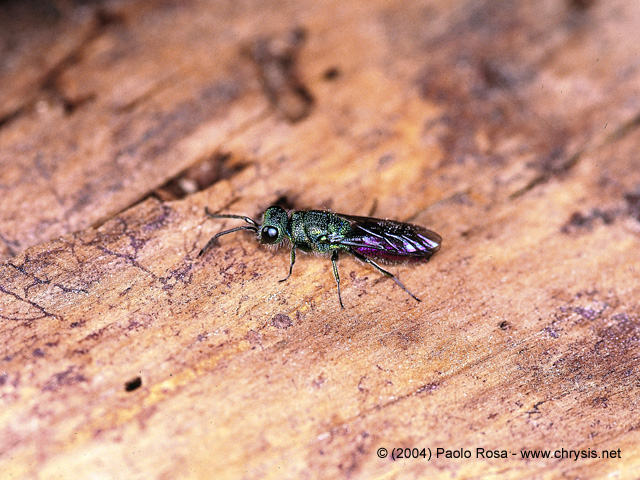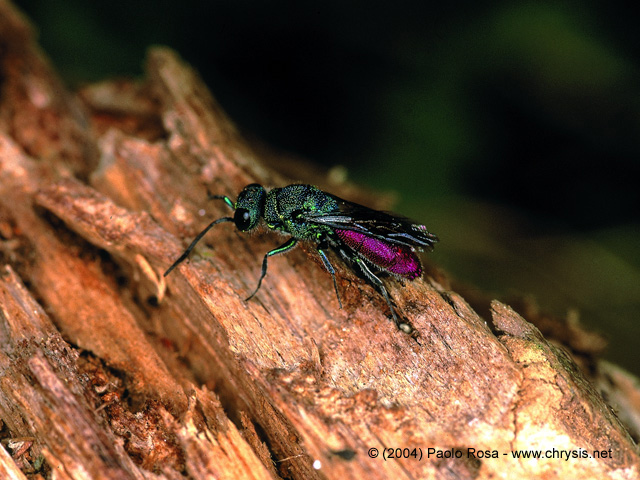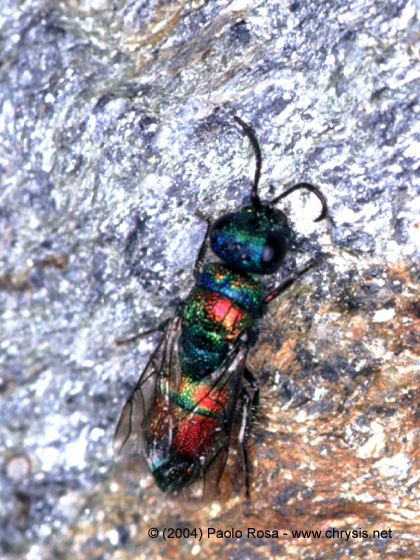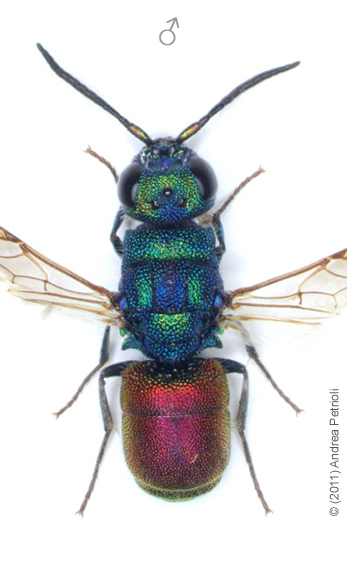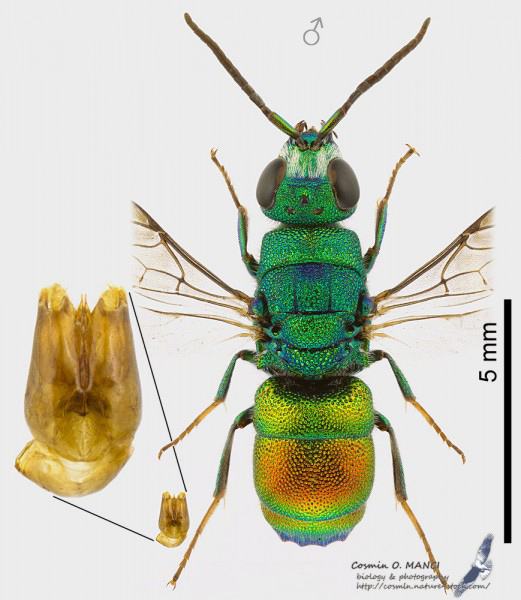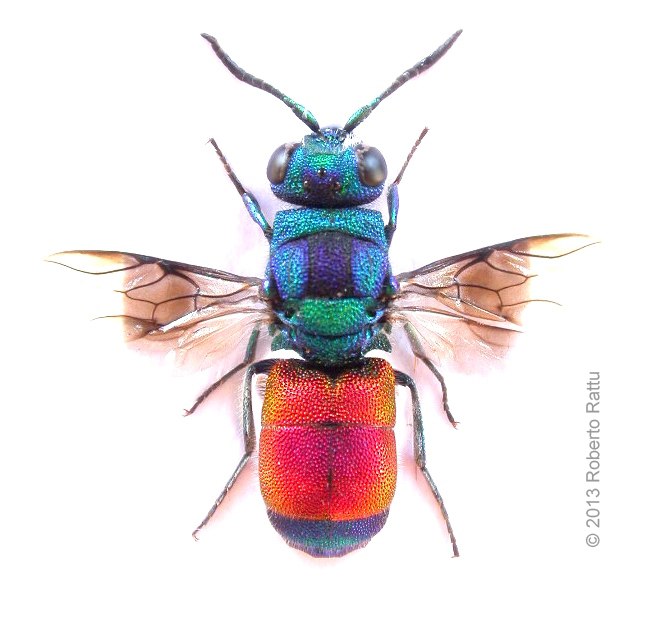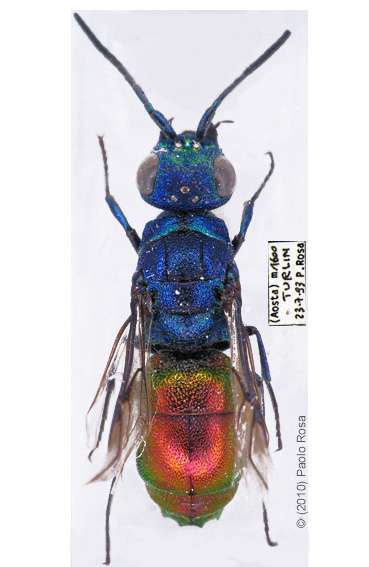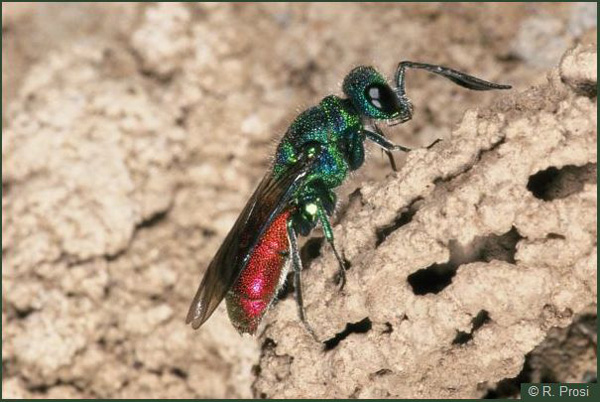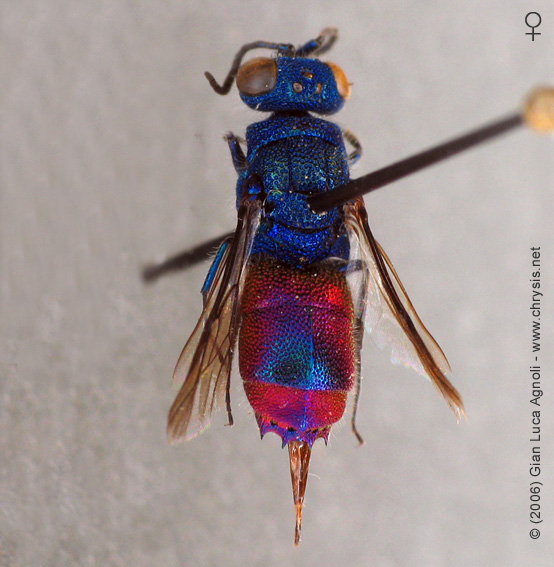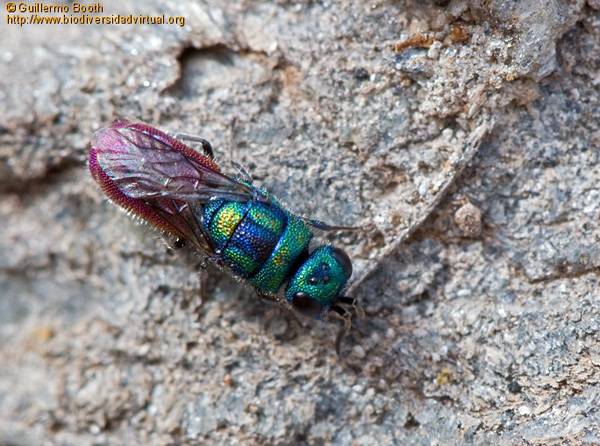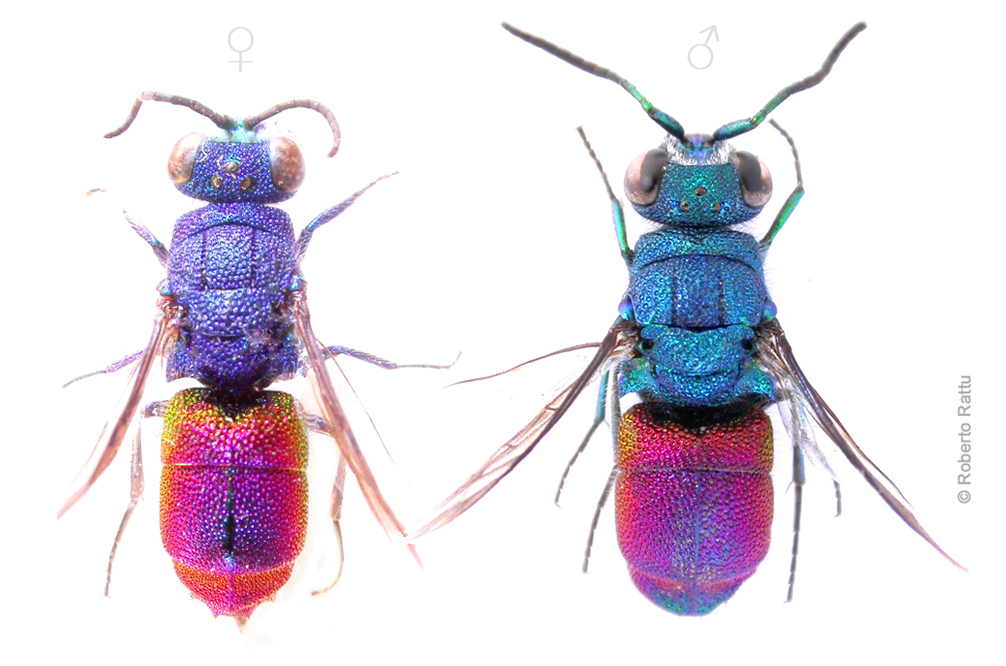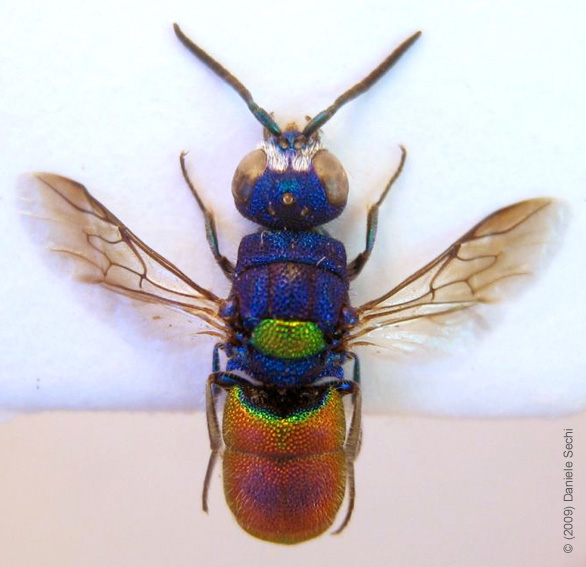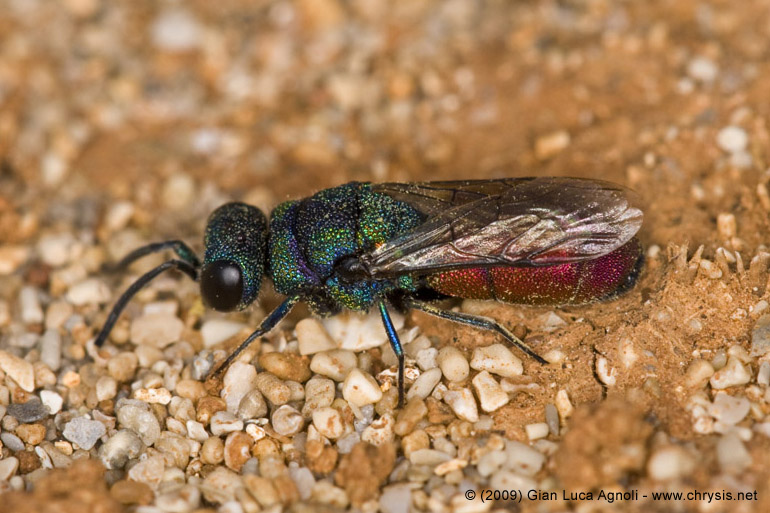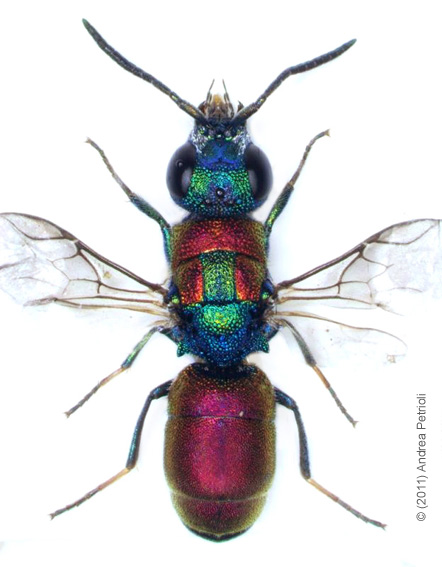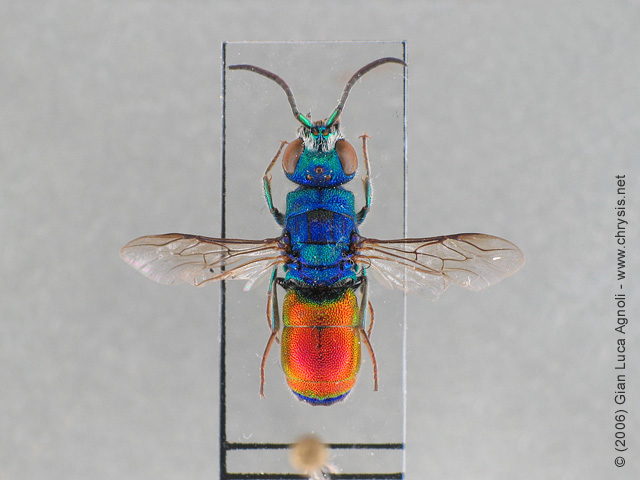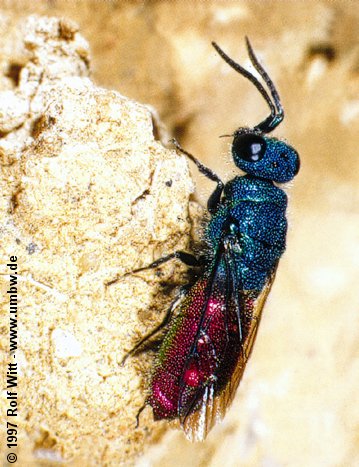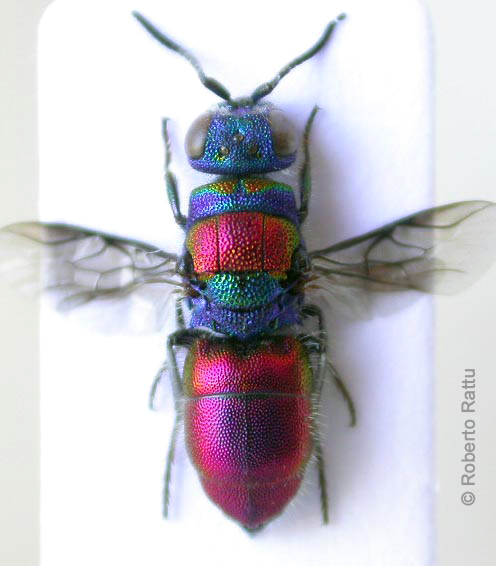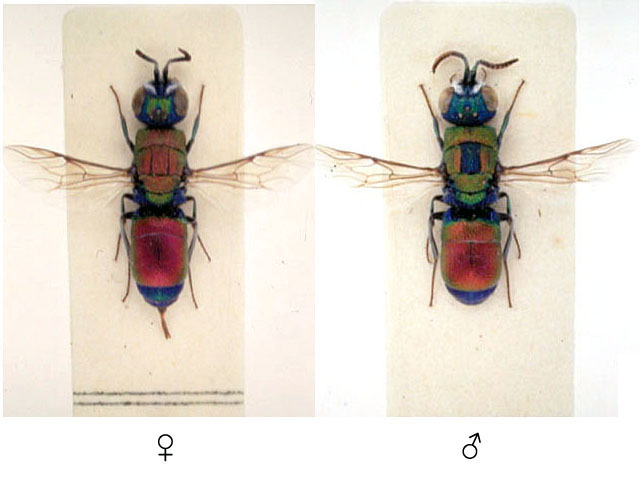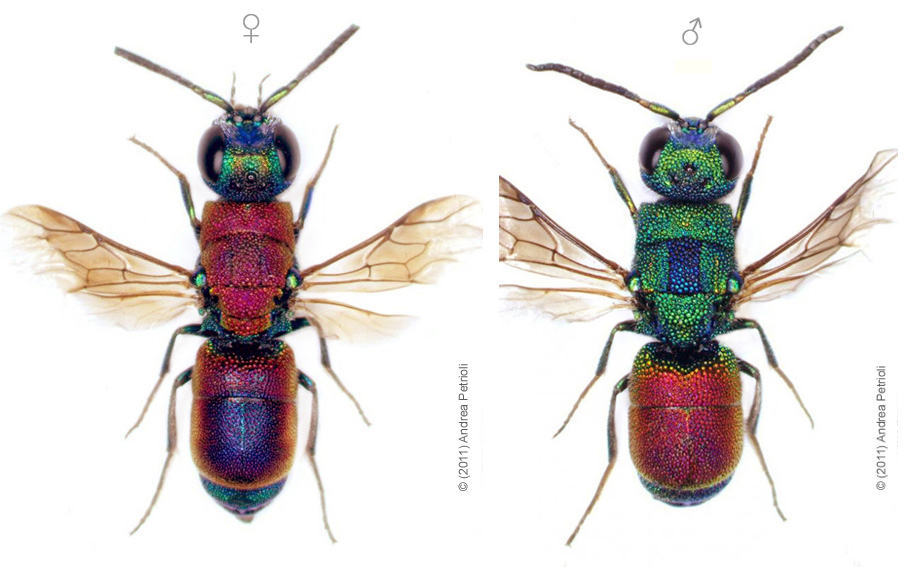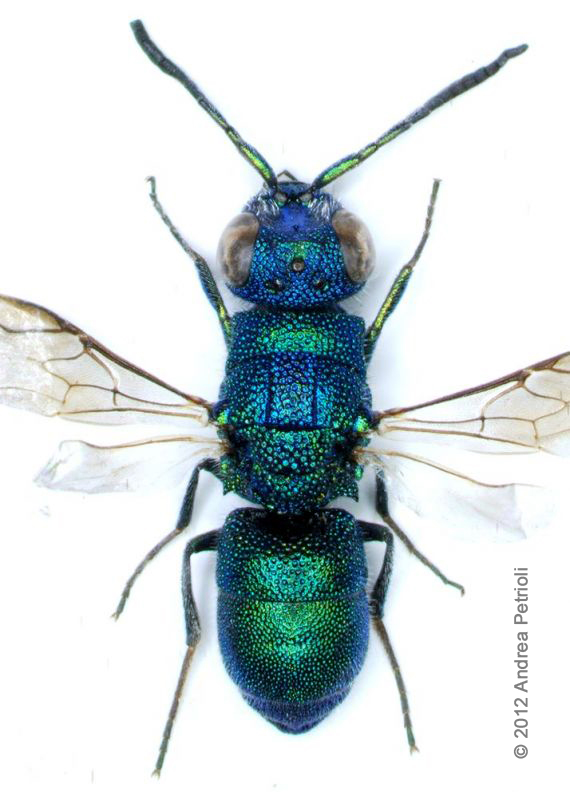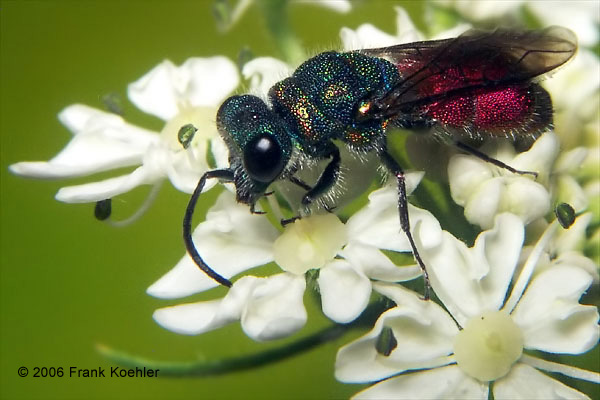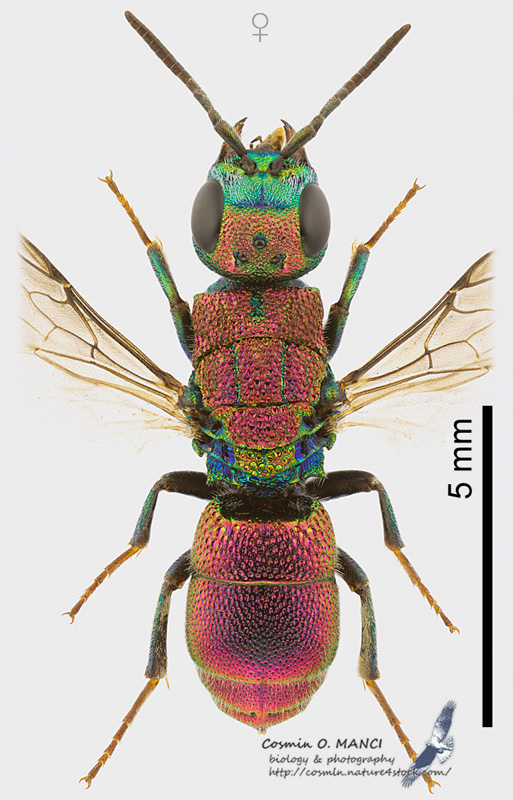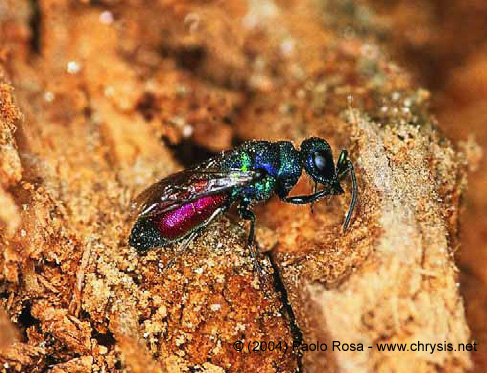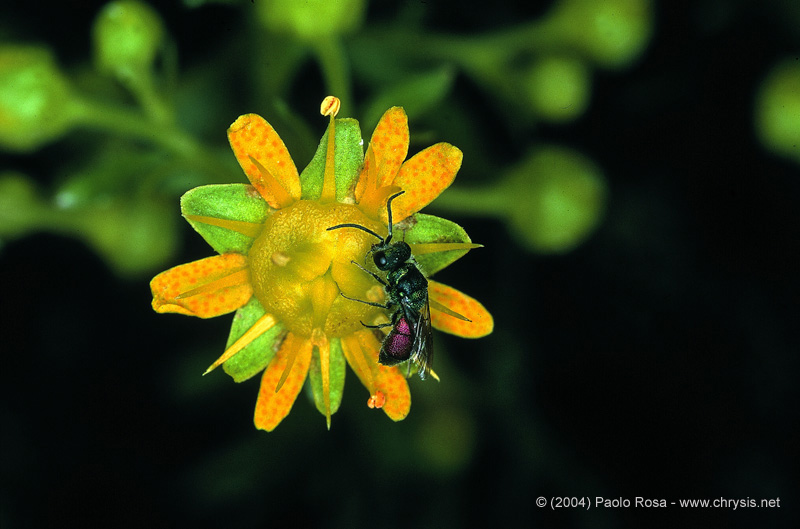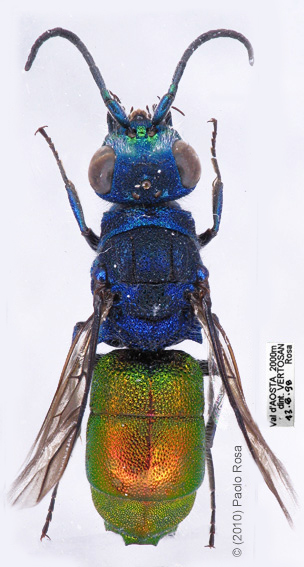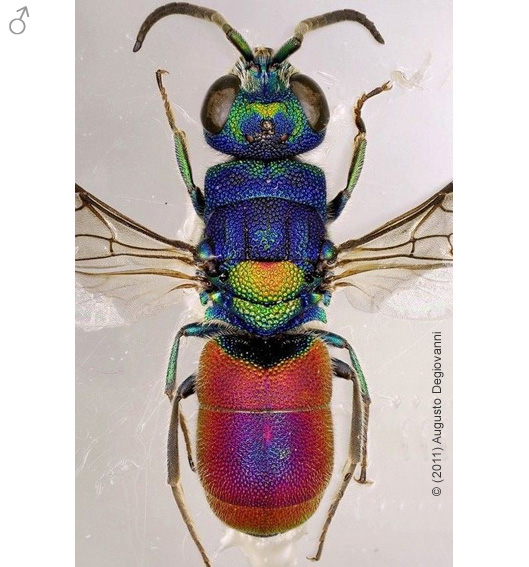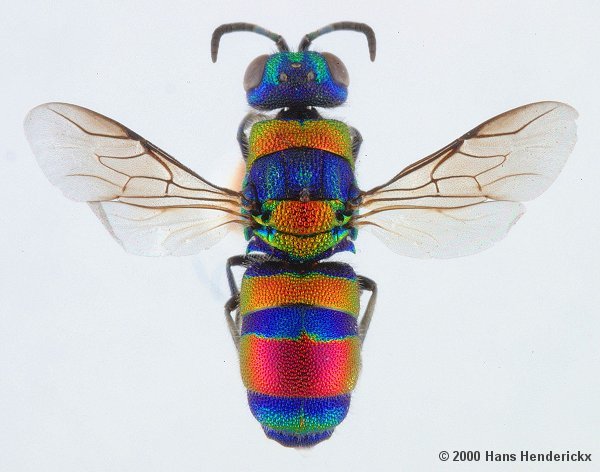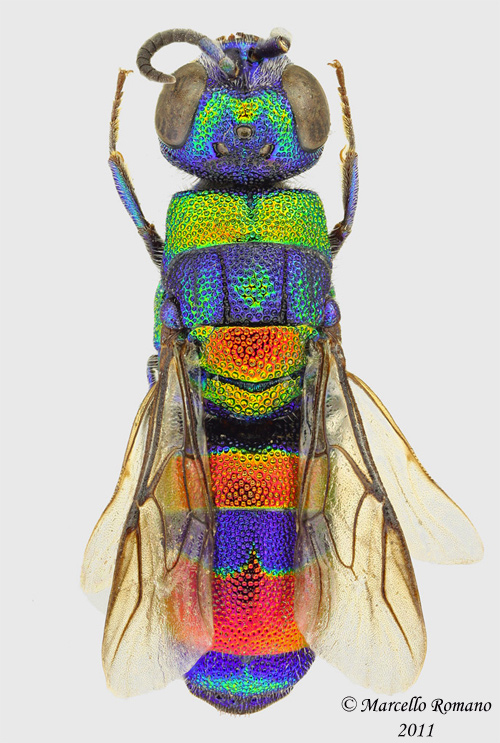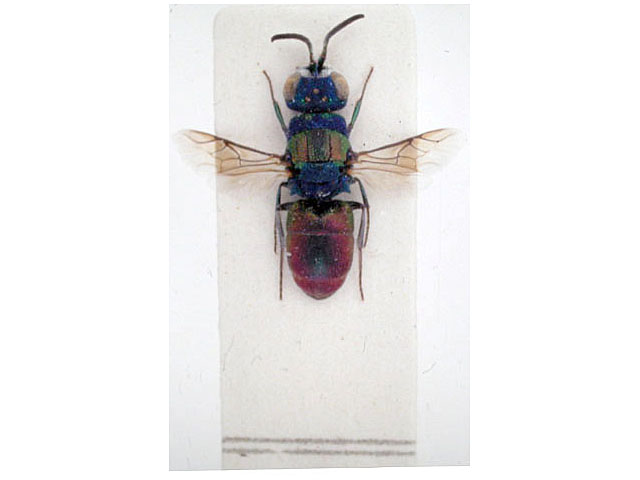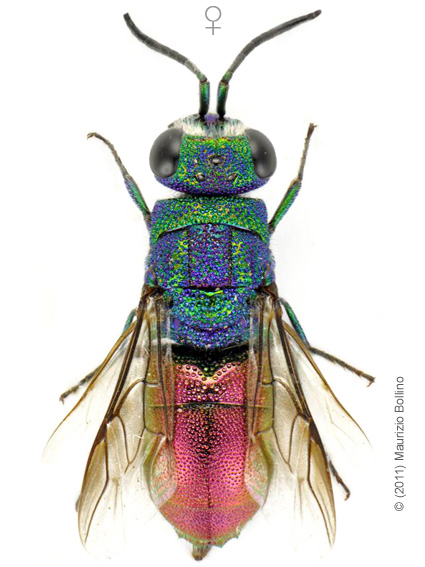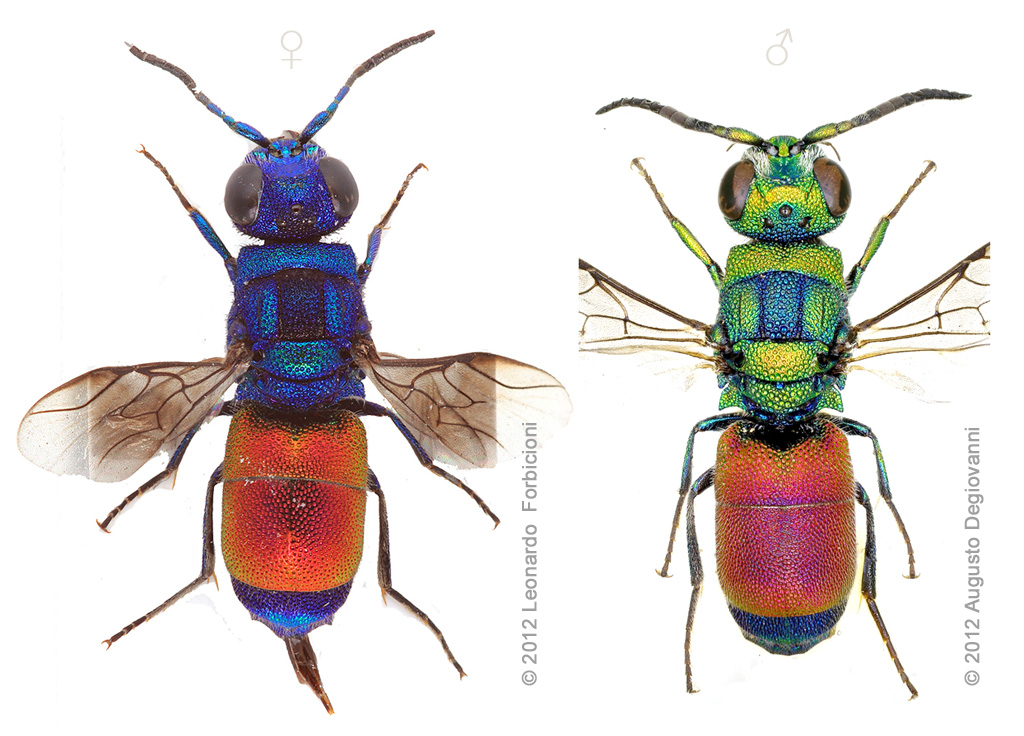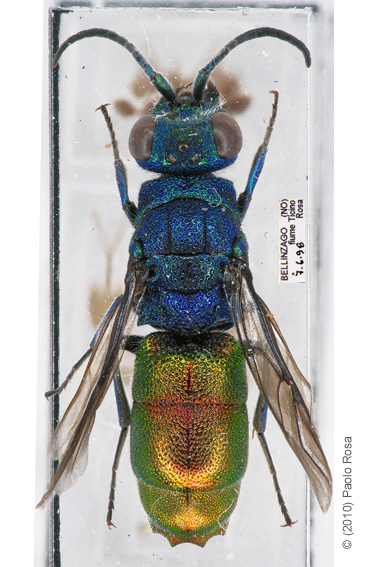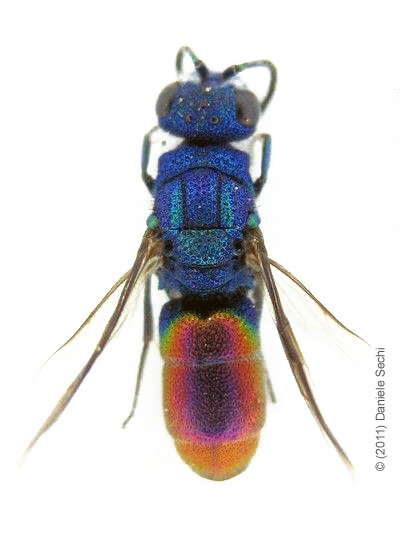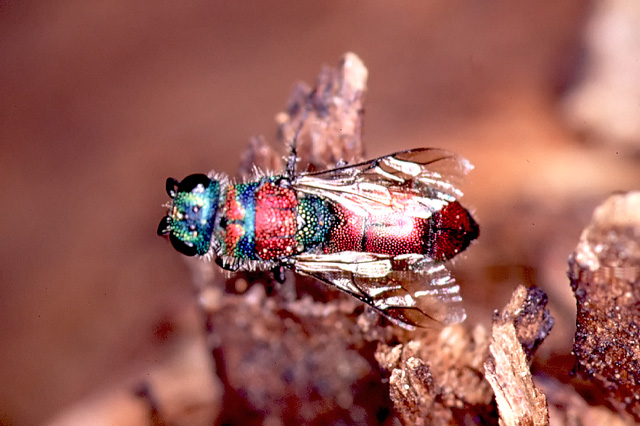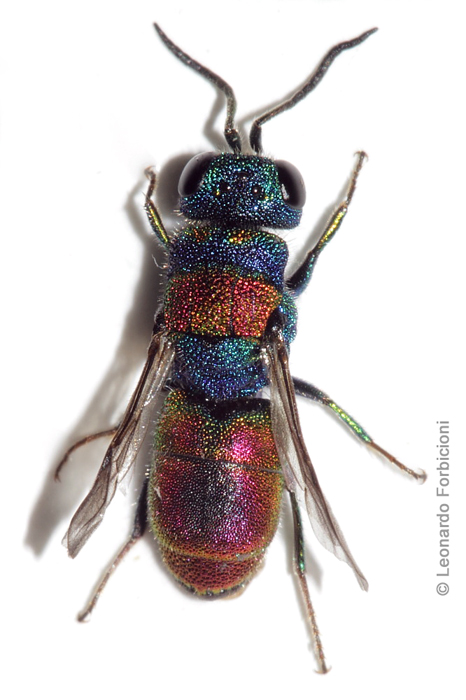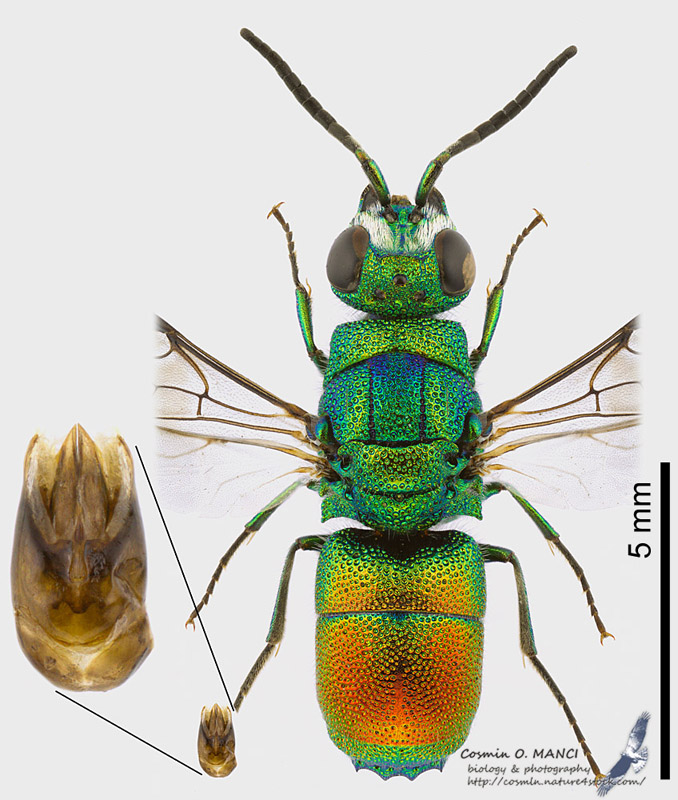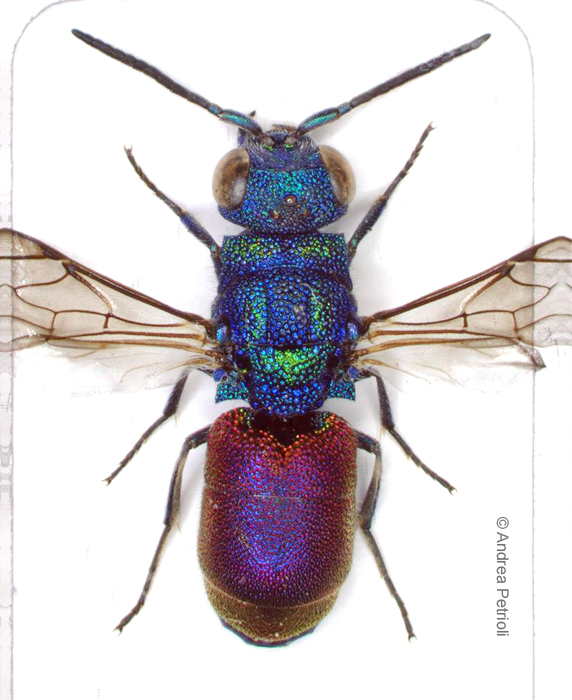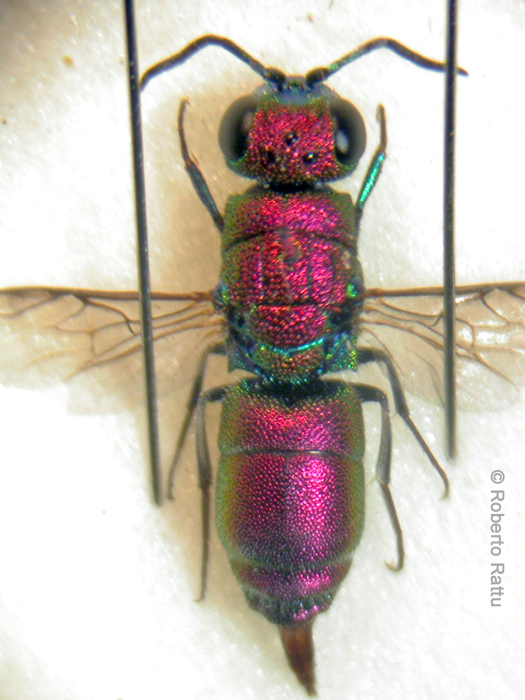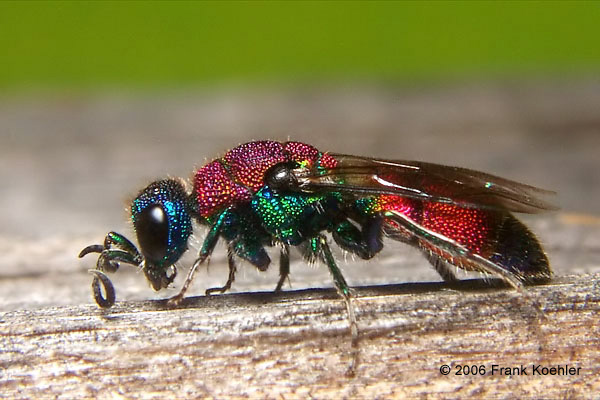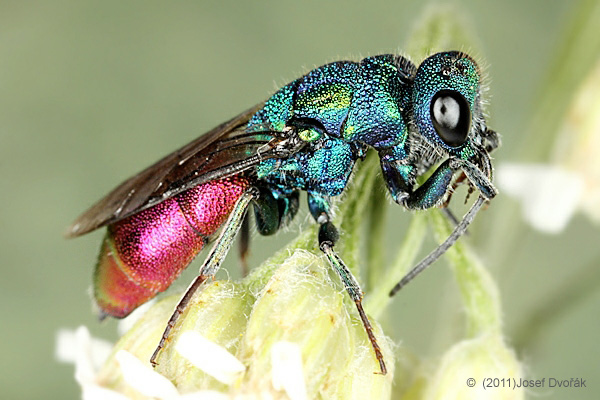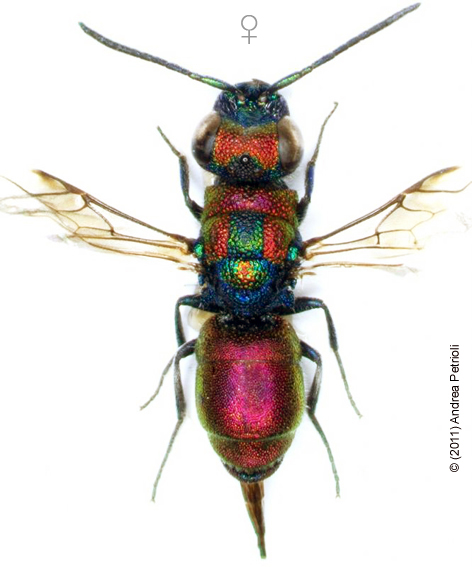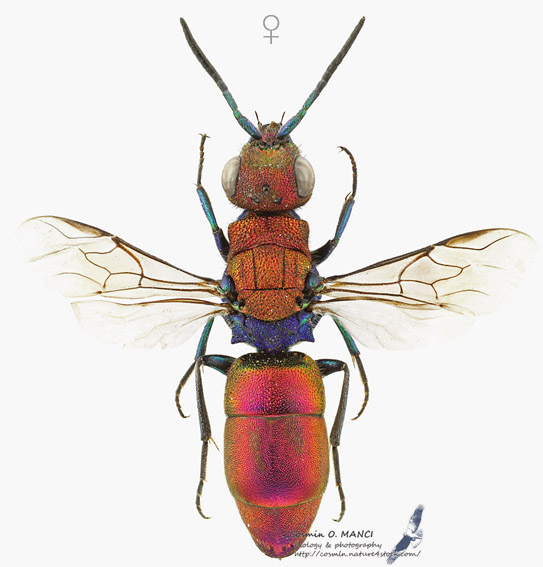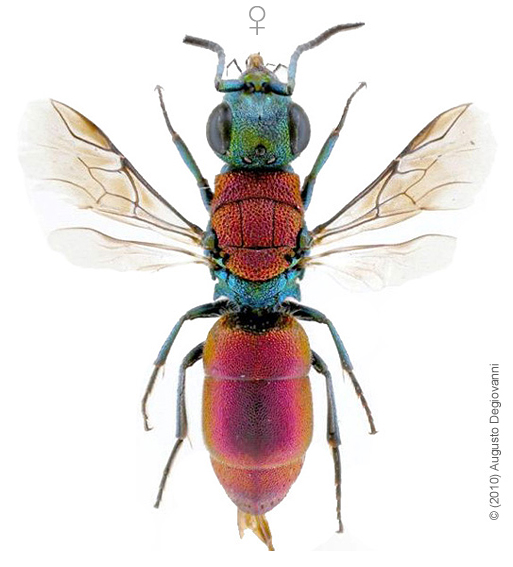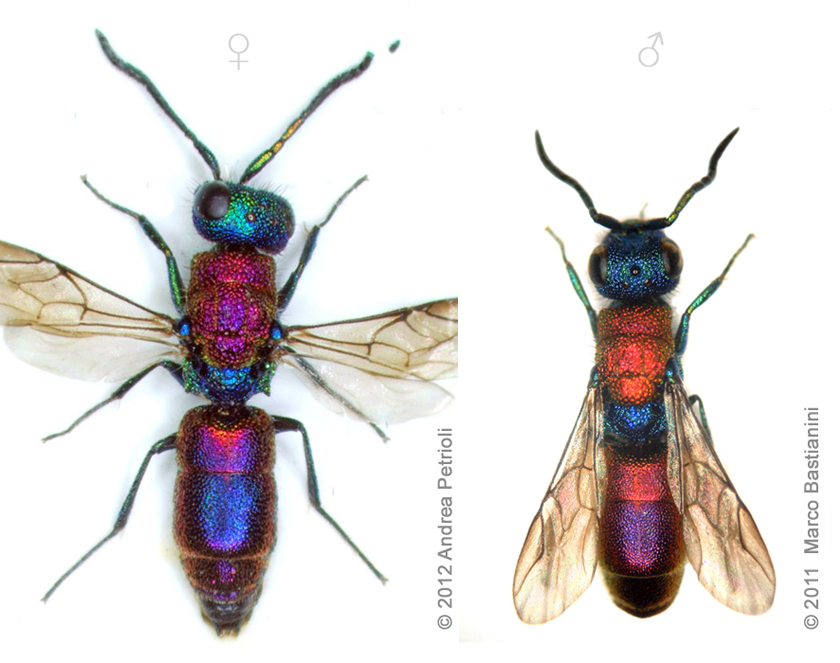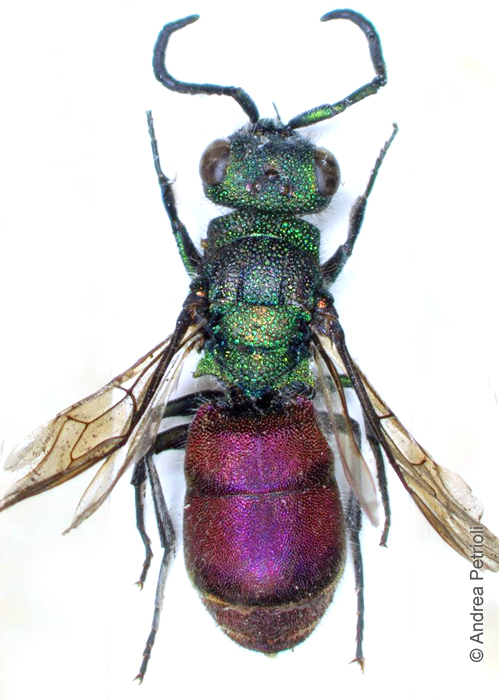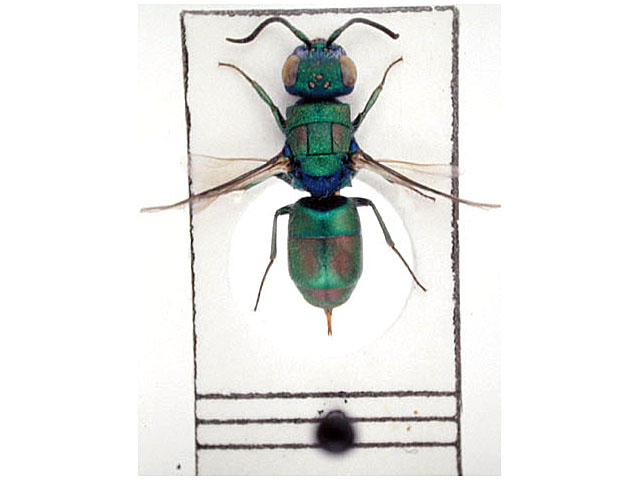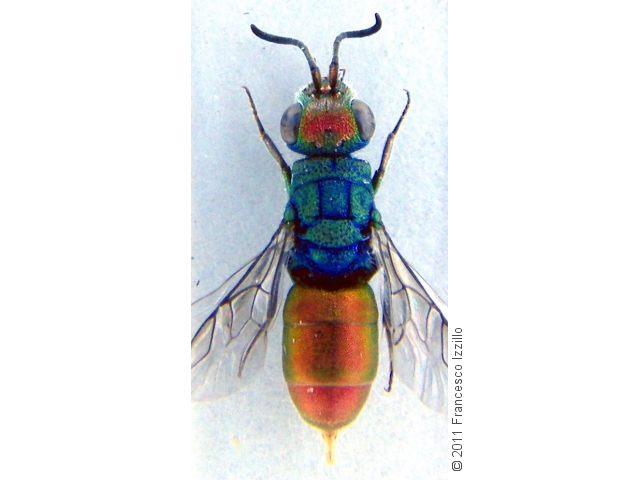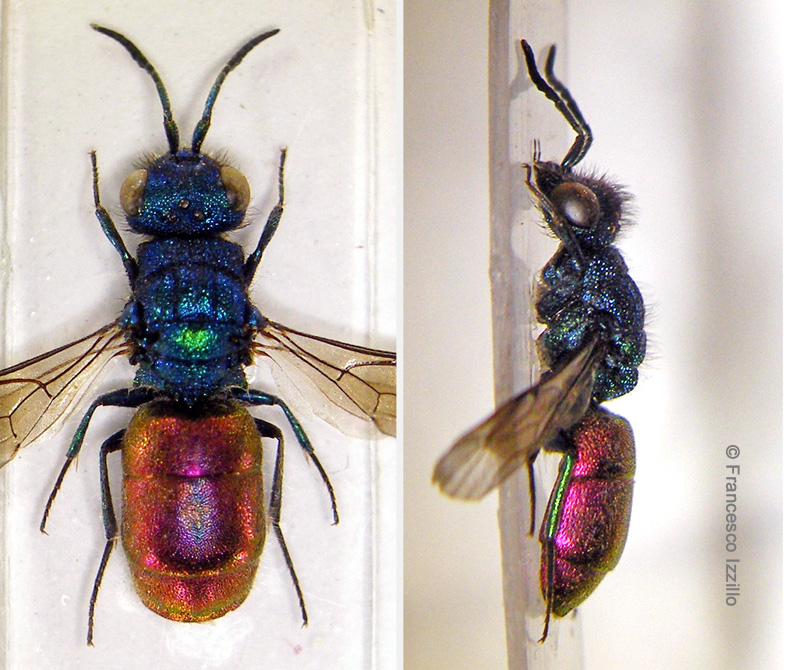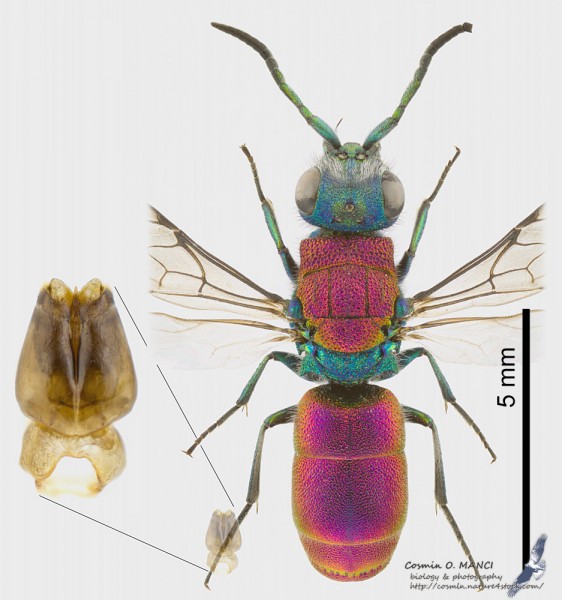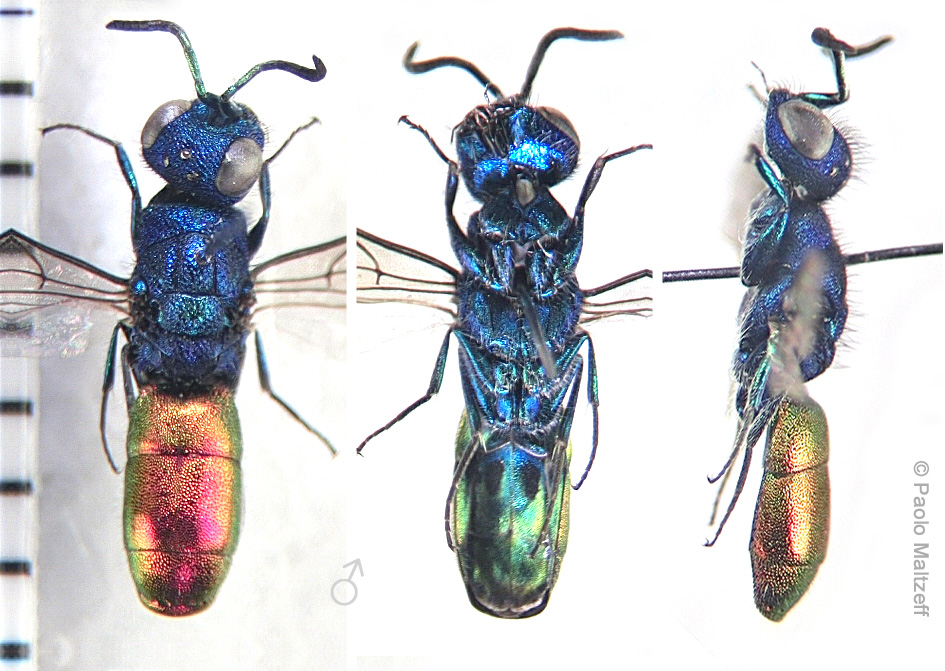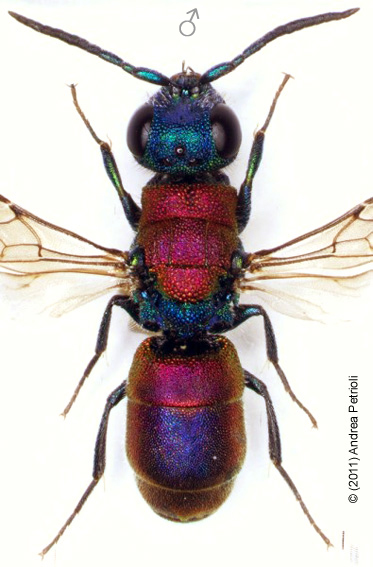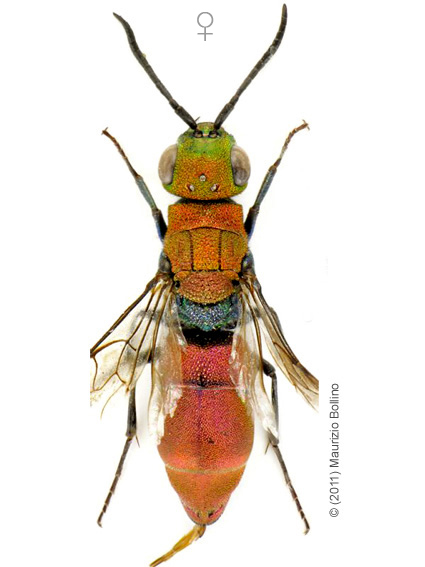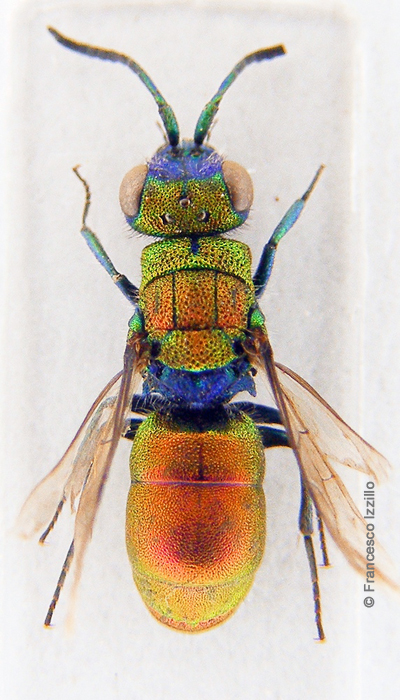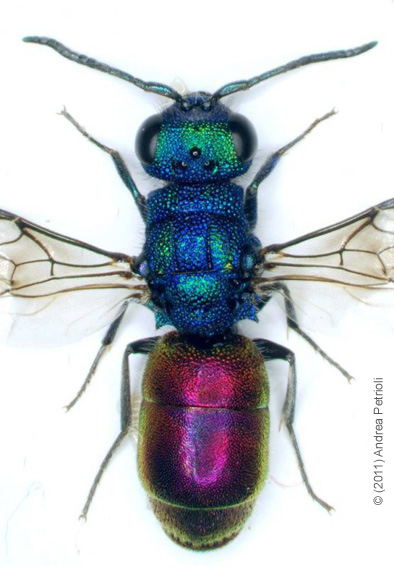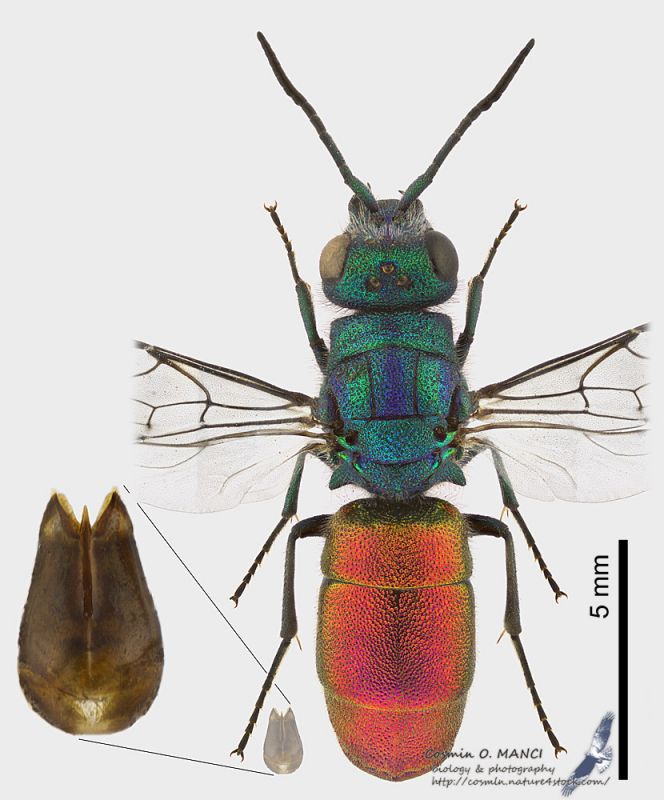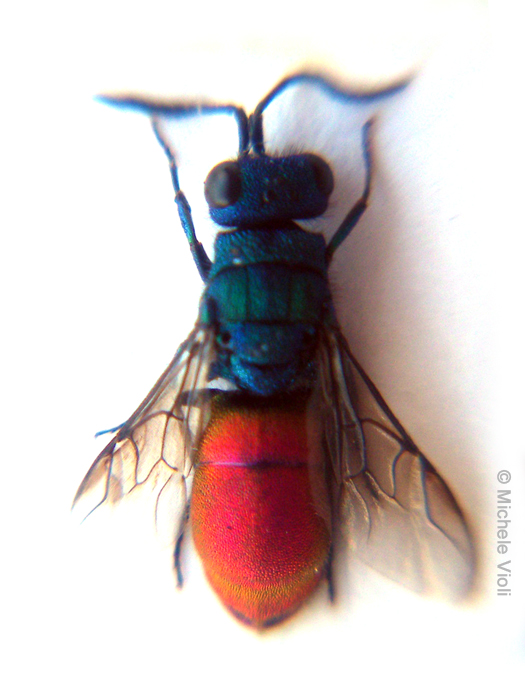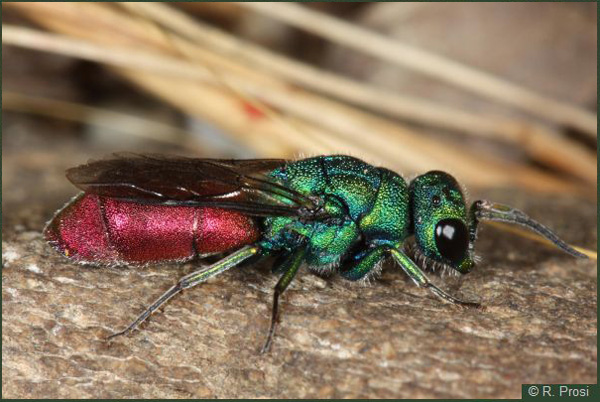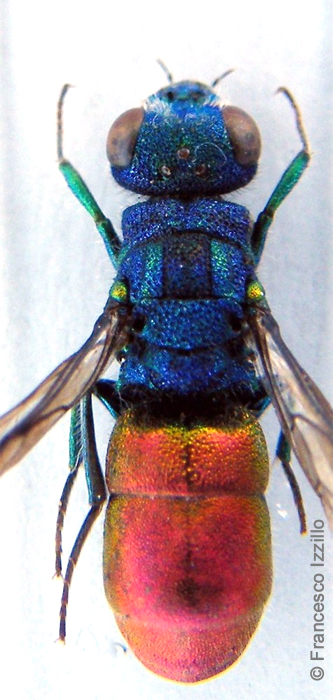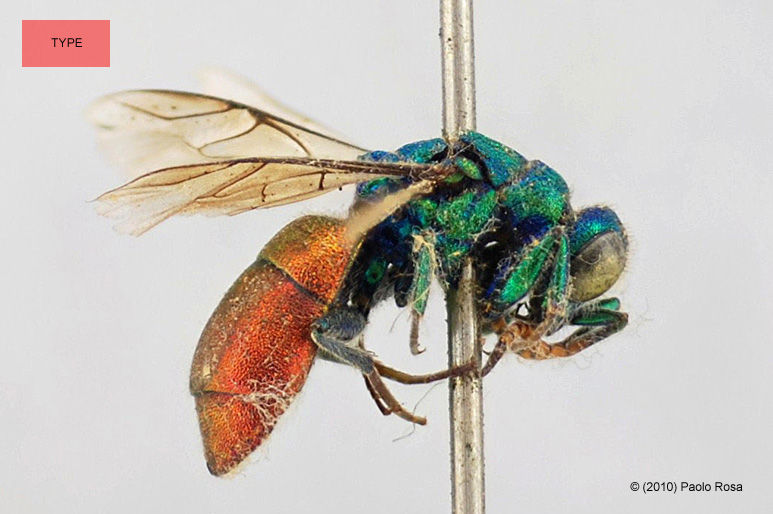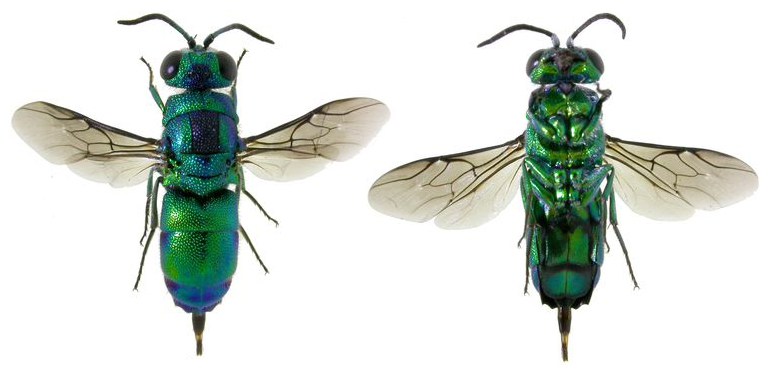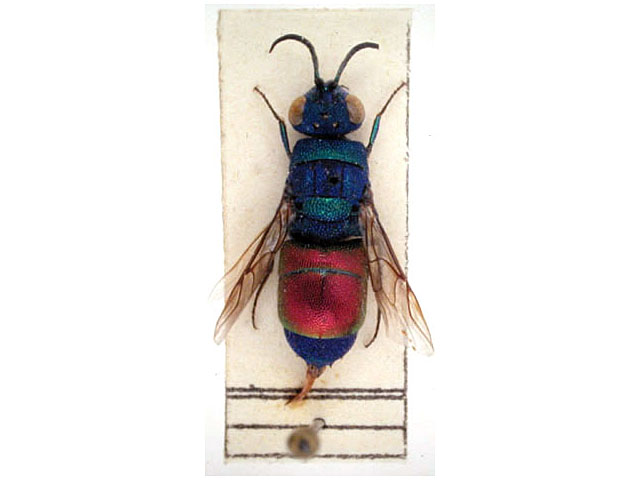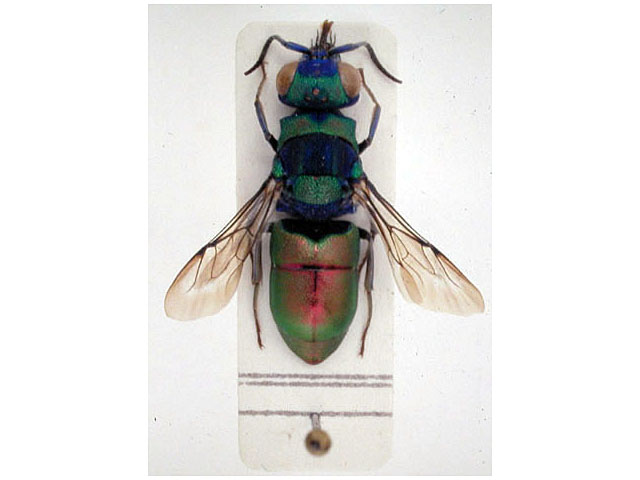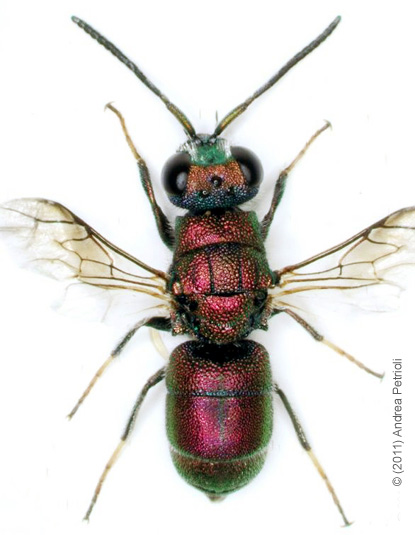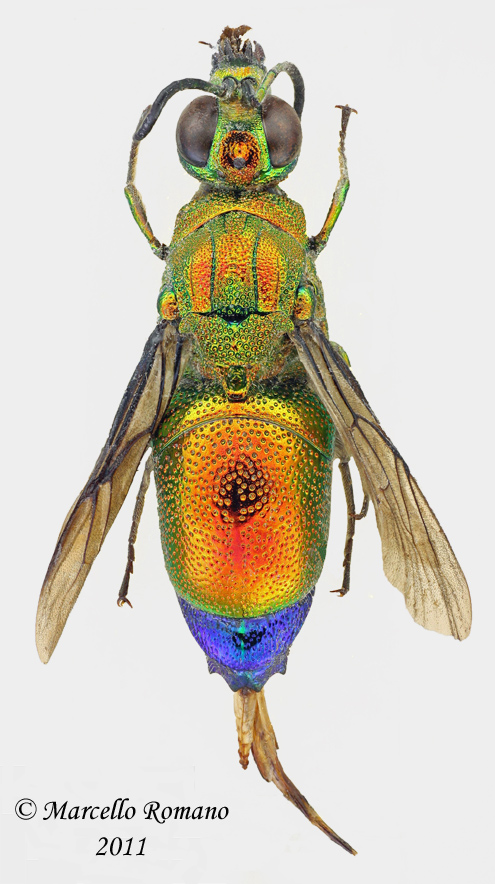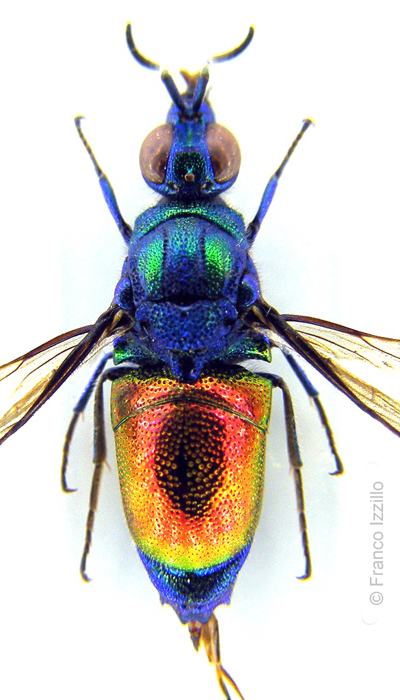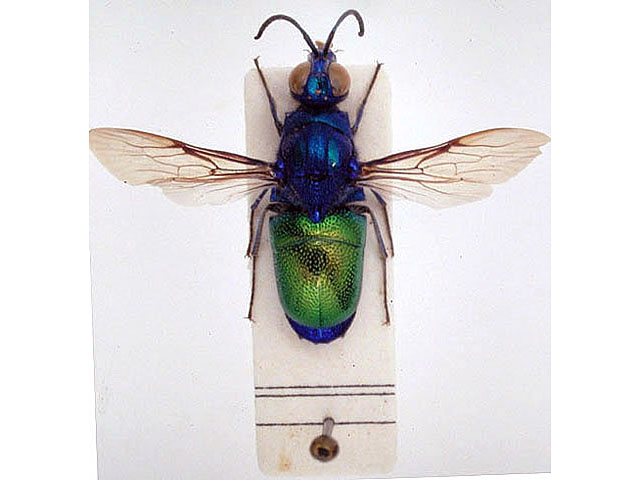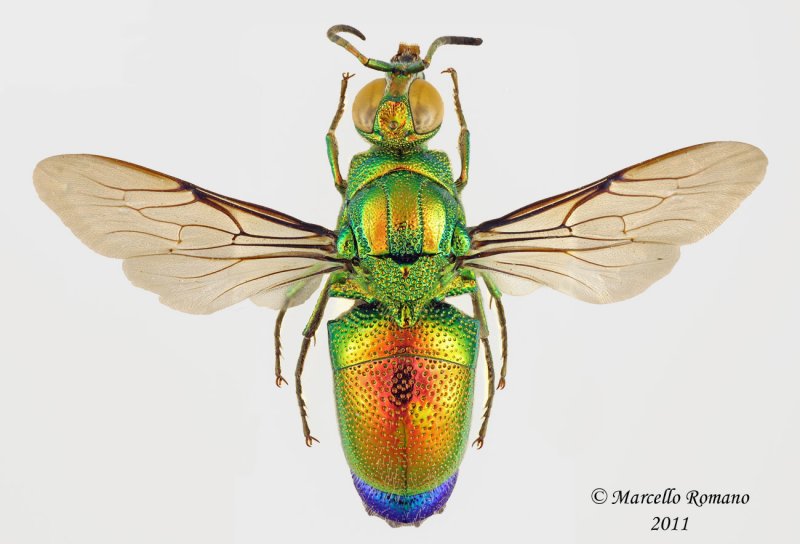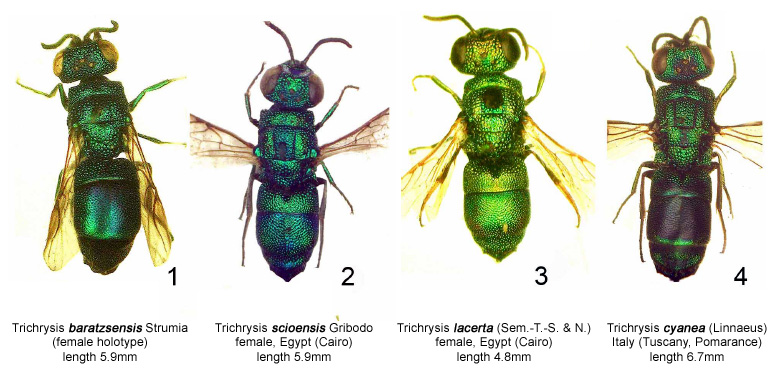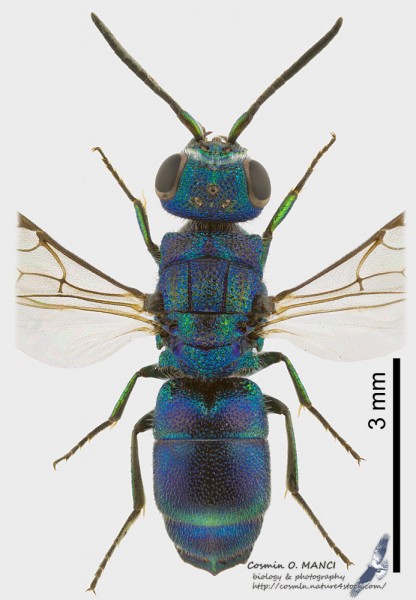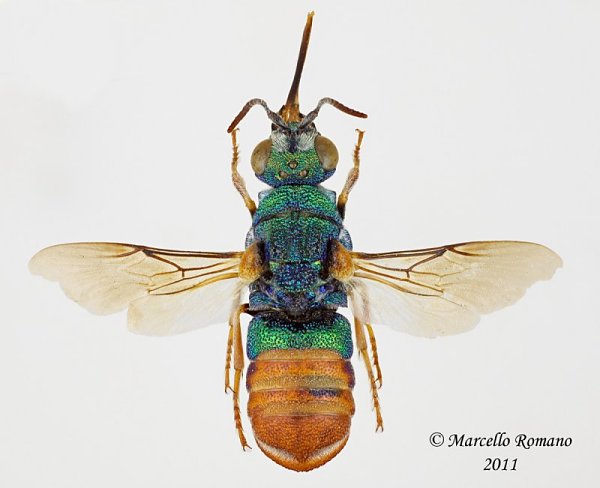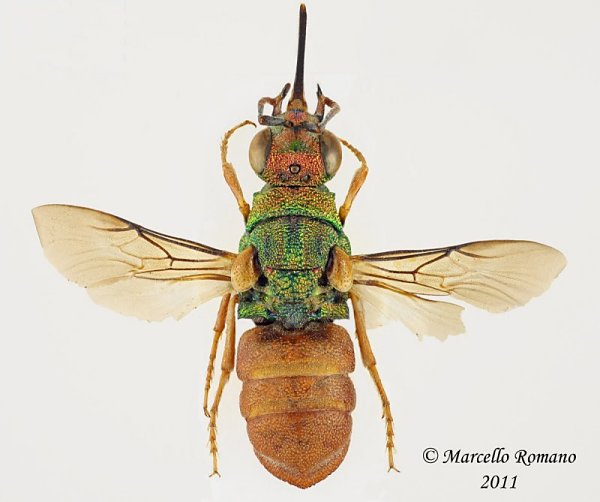Genus Hedychridium Abeille, 1878
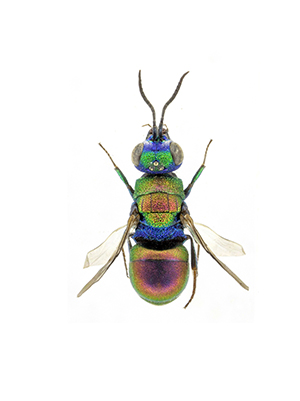 From: Kimsey L.S. & Bohart R.M., 1990 (1991) - The chrysidid wasps of the world. Oxford University Press, ix-652 pp.
From: Kimsey L.S. & Bohart R.M., 1990 (1991) - The chrysidid wasps of the world. Oxford University Press, ix-652 pp.
Synonymy
Hedychridium Abeille 1878:3. Type: Hedychrum minutum Lepeletier 1806:122 (= Chrysis ardens Coquebert 1801:59). Desig. by Ashmead 1902:227.
Buyssonia Mocsáry 1902b:536. Type: Hedychridium dybowskii Buysson 1898b:520. Monobasic.
Acrotoma Mocsáry 1902b:537. Type: Acrotoma braunsii Mocsáry 1902b:537. Monobasic. Nee Boettger 1881. N. synonymy.
Hexachridium Bischoff 1913:16. Type: Hexachridium sexdentatum Buysson 1898b:520. Monobasic. N. synonymy.
Tetrachridium Zimmermann 1952:358. Type: Tetrachridium zavattari Zimmermann 1952:359. Monobasic.
Euchridium Semenov 1954a:96. Type: Eiubridium trossitlum Semenov 1954a. Monobasic.
Cyrteuchridium Semenov 1954a:100. Type: Cyrteuchridium pusio Semenov 1954a:100. Monobasic.
Irenula Semenov and Nikol'skaya 1954:102. Type: Irenula margaritacea Semenov 1954a:102. Orig. desig. and monobasic.
Euchrum Semenov 1954a:103. Type: Chrysis carnea Rossi 1790:75. ( = Hedychridium roseum Rossi 1790). Orig. desig.
Zarudnidium Semenov 1954a:104. Type: Zarudnidium sapphirinum Semenov 1954a:104. Orig. desig.
Zarudnium Semenov 1954a:72. Type: Hedychrum ahenenm Dahlbom 1854:72. Orig. desig. and monobasic.
Cyrteuchrum Semenov 1954a:105. Type: Cyrteuchmm flos Semenov 1954a:105. Orig. desig.
Cladiola Semenov 1954a:107. Type: Cladiola rhodochlora Semenov and Nikol'skaya 1954:107. Orig. desig.
Colpopyga Semenov 1954a:137. Type: Hedychrum flavipes Eversmann 1857:552. Orig. desig.
Actineuchrum Semenov 1954a:141. Type: Actineuchrum soloriens Semenov 1954a:144. Orig. desig. and monobasic.
Homalsuchrum Semenov 1954a:141. Type: Homalsuchrum smaragdinum Semenov 1954a:143. Orig. desig. and monobasic.
Generic diagnosis
Scapal basin flat to shallowly concave, often with dense appressed silvery pubescence and rarely with transverse frontal carina; base of oral fossa somewhat elevated; malar space usually less than 1 MOD; pronotal anterior margin with sublateral carina; mesopleuron usually rounded without omaulus or scrobal carina; scutellar wing fossa without anterior lobe; mid and hind tibia rarely with pits on inner surface; tarsal claws with one submedial, perpendicular tooth; fore wing medial vein straight to strongly arched, arising at cu-a, stigma slender and apically acute; T-III usually evenly rounded, rarely with two to six apical teeth, apicomedially emarginate, or drawn out medially; digitus and cuspis present.
Hosts
Despite the large number of species in Hedychridium little is known about their biology. Part of this lack of information is probably because these wasps are nest parasites of ground-nesting Sphecidae and bees.
Distribution
This genus occurs in all zoogeographic regions except the Australian, with highest diversity in arid parts of the Holarctic and southern Africa.
Discussion
Hedychridium is the second largest genus in the Chrysididae. It contains a diverse assemblage of species and as a result is difficult to characterize. The two features shared by all species in this group are the single perpendicular tooth on the tarsal claw and the transverse pronotal carina. Otherwise Hedychridium is recognized by the general lack of the derived characteristics diagnostic for other genera. Species in this genus lack multiple teeth on the tarsal claws, prehensile tarsomeres, a scutellar tubercle projecting into the wing fossa, modified fore wing venation, female S-III with basolateral sulci, and the oral fossa with a basal tooth.
However, some features characteristic of other genera do occur in a few Hedychridium. The apical rim of T-III may have two (arnoldi, braunsi, dybowskyi, discrepans), four (zavattari), or six (sexdentatum) teeth or angles. Species in the sulcatum group have the propodeal angle apically truncate and deeply emarginate posteriorly, much like the condition in Spintharina. Members of the attentiatum group have mid and hind tibial pits similar to those of Hedychrum. A few Old World species, including dybowskyi, have a TFC like many Chrysidini. Although most Hedychridium are entirely iridescent a few, including semirufum and roseum, have the abdomen largely or entirely, non-metallic red.
In addition to the modifications given above, species distinctions are based on coloration, particularly of T-II, S-II and -III, and the tegula, facial dimensions, relative dimensions of F-I—III and -V, shape of the fore femur and propodeal tooth, and sculpture of the mesopleuron. The majority of species have dense appressed silvery setae in the scapal basin, but there are many exceptions to this, including species related to dimidiatum and monochroum. In chadense and margaritaceum the integument is red with a peculiar silvery blue or green sheen. The fore wing medial vein is usually slightly curved, but in attenuatum, dimidiatum, flavipes, roseum, and sapphirinum it is strongly angled. The male flagellum is considerably broadened in aristinum. The fore femur has a strong sub-basal angle in olene, and species related to sericifrons also have a sharp dorsal and ventral carina. Most species have an acute, triangular, propodeal angle. However a variety of species including sulcatum, have an apically truncate angle, which is deeply emarginate posteriorly, and dybowskyi, ciliatum, and some species in the sericifrons groups, have a small tooth below the propodeal angle.
Hedychridium has been divided into a number of genera by Semenov (1954a, b), and species groups by Linsenmaier (1959a) and Bohart and Kimsey (1978). The majority of the Semenov genera more accurately represent species groupings than genera. Although species groups are far from precise they do make the genus easier to deal with.
We had considered giving species groups for Hedychridium to provide more information about this difficult genus. However, we have only been able to study types or reliably identified specimens of fewer than half the species. We have not been able to locate the repositories of a number of species described by Buysson and Abeille, or most types supposedly placed in the collection at Krakow. To further complicate matters, we have been unable to study any of the large number of types described by Linsenmaier and deposited in his collection. Further, this genus is poorly known and quite a few species are known only from the type. As a result, we feel it would be unrealistic and premature to attempt to formulate species groupings with so little information. Some idea of related species can be gleaned from the above works of Linsenmaier, Semenov, and Bohart and Kimsey.
The ardens group of Linsenmaier (1959a) is characterized by the indistinct brow, scapal basin with a lateral patch of small punctures and some silvery setae, F-I 1.8-2.0 times as long as broad, medial vein strongly curved at least basally, and mesopleuron not obviously carinate. This is a large group of Palearctic species, including: ardens, brevifronte, buyssoni, bytinskii, coriaceum, cupratum, discordum, ehgantulum, etnaense, femoratum, hybridtim, ibericum, interrogatum, israelicum, jordanense, jucundum, krajniki, linsenmaieri, marteni, modestum, perscitum, purpurascens, reticulatum, scintilla, sevillanum, turanicum, verhoeffi, viridisulcatum, and wolfi. Three species, attenuatum, nevadae, and planifrons, bear a superficial resemblance to Hedychrum. They have mid and hind tibial pits, an ecarinate mesopleuron, edentate mandible, large flat pronotum, and an arched medial vein. A number of Old World species have a tooth or angle below the propodeal angle. The Afrotropical species are congoense, kilifiense, laterals, and bidens, and the Palearctic ones are ciliatum and karatavicum. The Nearctic dimidiatum group of Bohart and Kimsey (1982) is characterized by F-I twice as long as broad, and a strongly arched medial vein. This group should probably be merged with the ardens group. Acrotoma was erected for Afrotropical species with two submedial teeth or angles on the apex of T-III. Three of these, arnoldi, braunsii, and dybowskyi, also have a TFC, propodeal angle subtended by a posterior tooth or angle, T-II and -III with strong medial and transverse subapical ridges, F-I less than twice as long as broad, and the tegula and S-II-III green. None of these characteristics are sufficiently unusual to justify the establishment of a separate genus. The other species placed in Acrotoma are discrepant and heymonsi. They have two obtuse apical teeth on T-III but lack the tergal ridges and TFC of the dybowskyi group. The flavipes group of Linsenmaier (1959a) is homologous with the crassum group of Bohart and Kimsey (1982), and includes: auriventris, crassum, elongatum, flavipes, incisum, and purum. They have the medial vein strongly arched, T-III rolled under apically and indented apicomedially, T-II thickened apically, F-I cylindrical and twice as long as broad, or longer, and tegula yellowish. Two unusual North American species, cornutum and frugale, have the integument microreticulate between punctures. In addition, F-I is short, the medial vein straight, and both species are less than 3 mm long. They constitute the frugale group of Bohart and Kimsey (1982). Similar to the frugale group but lacking microreticulation is the Nearctic gemmatum group, which comprises antennatum, argenteum, arietinum, frontis, gemmatum, leucostigma, milleri, and paulum. Three Afrotropical species, capense, maculum, and rhodesiacum, the maculum group, have unusual facial sculpturing. The face is laterally reticulate-punctate and the scapal basin is medially coarsely rugose. Semenov's Irenula constitutes the margaritaceum group, which includes chadense and margaritaceum. The most distinctive feature of this group is the unusual coloration. The body is non-metallic red, with an odd overlying silver sheen. Also, Rs is less than half as long as M, the pronotum deeply indented laterally, T-III rolled under laterally and produced apically, and the propodeal angle broadly digitate. The monochroum group of Linsenmaier (1959a) includes part of the species in the amabile group of Bohart and Kimsey (1982). In these the brow is large and bulging, scapal basin is very short and cross-ridged with large lateral punctures, flagellum long, slender, and tapering apically, F-I is long, medial vein straight, and T-III somewhat rolled under laterally. Included are: adventicum, atratum, breviceps, carmelitanum, dismor-phum, fulvago, minutissimum, monochroum, parkanense, rasile, senegaleme, and solierellae. The Afrotropical obscuratum group includes africanum, eardteyi, erythema, and obscuratum. They have a broadly triangular propodeal angle, blue tegula and S-II, long clypeus (more than 1.5 MOD), T-III swollen subapically and without rim, F-I short, and malar space at least 0.5 MOD. Linsenmaier's roseum group includes 12 Palearctic species: chloropygum, hofferi, houskai, luteum, pseudoroseum, rhodojanthinum, roseum, semiluteum, subroseum, susterae, and tsuneki. In these F-I is about 3 times as long as broad, mesopleuron and fore femur carinate, medial vein strongly arched, and scapal basin coarsely sculptured. H. clarum and sapphirinum form a group characterized by the bulging brow, strongly carinate mesopleuron, carinate and angulate fore femur, arched medial vein, F-I twice as long as broad, and T-III subapically thickened. The Palearctic and Afrotropical sericifrons group is one of the most distinctive. Diagnostic features are: brow sharply defined (often with a TFC), scapal basin with tiny punctures and dense silvery setae, fore femur angulate with a lateral and ventral carina and the outer surface between flat, T-III with a wide transparent rim, and mesopleuron carinate. The fore femur is uniquely modified in these species. Included are: bidens, facialis, flos, garianum, prunifrons, semirufum, sericifrons, sexdentatum, smaragdinum, soloriens, tyro, xanthum, zavattari, zimmermanni, and znoikoi. This peculiar group also includes species with a multidentate T-III. Finally, the Afrotropical sulcatum group can be immediately identified by the flag-like propodeal angle. Instead of being triangular the angle is truncate apically and deeply emarginate or notched posteriorly. Other features include a well developed brow, scapal basin with abruptly fine punctation, T-III thickened and coarsely punctate before rim, S-II and -III green in males, but only S-II in females, and the hind tibia somewhat broadened with a dark convex inner surface. This group includes: angulatum, biquetrum, chrysochlorum, coloratum, gessi, namibianum, robustum, sinuatum, ultimum, uncinatum, and vulgare.
Unidentified material from arid parts of the Palearctic and Nearctic Regions and southern Africa indicates that a large number of species remain to be described from these areas. Hedychridium are not as commonly collected as the other large chrysidine genera, apparently because most Hedychridium are tiny (less than 4 mm long). Also, they tend to stay close to the ground, particularly in the vicinity of small shrubs or other plants that offer food or cover. Even when startled they will often run rather than fly. All of which makes Hedychridium a difficult group to collect.
Due to this large diversity there has been relatively little synonymy in Hedychridium, except in a few of the commonest European species like ardens, flavipes, and roseum. We have been unable to provide much new synonymy in this genus partly because of the relatively few types that we have seen.
Species distinctions are based on both structural features and coloration. General body colour is used as well as the colour of the wing veins, flagellum, tegula, and tarsomeres. The colour of S-II and-III is particularly important. Facial dimensions, the length to breadth ratios of F-I-II and-V, and the shape of the fore femur, mesopleuron, propodeal angle, and T-III are all valuable diagnostic characteristics.
Hedychridium has never been revised on a world basis, only in a series of regional treatments including: Bohart and Kimsey (1978, 1982) for the Americas, Linsenmaier (1951, 1959a, b, 1987) for Europe, and Edney (1940) for southern Africa.
European species
- Hedychridium adventicium Zimmermann, 1961
- Hedychridium aereolum Buysson, 1893
- Hedychridium aheneum (Dahlbom, 1854)
- Hedychridium albanicum Trautmann, 1922
- Hedychridium anale (Dahlbom, 1854)
- Hedychridium andalusicum Trautmann, 1920
- Hedychridium ardens (Coquebert, 1801)
- Hedychridium ardens homeopathicum Abeille, 1878
- Hedychridium aroanium Arens, 2004
- Hedychridium atratum Linsenmaier, 1968
- Hedychridium auriventris Mercet, 1904
- Hedychridium buyssoni Abeille, 1887
- Hedychridium buyssoni interrogatum Linsenmaier, 1959
- Hedychridium bytinskii Linsenmaier, 1959
- Hedychridium canarianum Linsenmaier, 1987
- Hedychridium canariense Linsenmaier, 1968
- Hedychridium caputaureum Trautmann & Trautmann, 1919
- Hedychridium carmelitanum Mercet, 1915
- Hedychridium caucasium irregulare Linsenmaier, 1959
- Hedychridium chloropygum Buysson, 1888
- Hedychridium chloropygum densum Linsenmaier, 1959
- Hedychridium chloropygum spatium Linsenmaier, 1959
- Hedychridium coriaceum (Dahlbom, 1854)
- Hedychridium creetense Linsenmaier, 1959
- Hedychridium cupratum (Dahlbom, 1854)
- Hedychridium cupreum (Dahlbom, 1845)
- Hedychridium cupritibiale Linsenmaier, 1987
- Hedychridium dismorphum Linsenmaier, 1959
- Hedychridium dubium Mercet, 1904
- Hedychridium elegantulum Buysson, 1887
- Hedychridium elegantulum peloponnense Linsenmaier, 1968
- Hedychridium etnaense Linsenmaier, 1968
- Hedychridium etruscum Strumia, 2003
- Hedychridium extraneum Linsenmaier, 1993
- Hedychridium femoratum (Dahlbom, 1854)
- Hedychridium foveofaciale Arens, 2010
- Hedychridium franciscanum Linsenmaier, 1987
- Hedychridium gratiosum Abeille, 1878
- Hedychridium heliophium Buysson, 1887
- Hedychridium homeopathicum Abeille, 1879
- Hedychridium hungaricum Móczár, 1964
- Hedychridium hyalitarse Perraudin, 1978
- Hedychridium hybridum Linsenmaier, 1959
- Hedychridium ibericum Linsenmaier, 1959
- Hedychridium incrassatum (Dahlbom, 1854)
- Hedychridium incrassatum mavromoustakisi Enslin, 1950
- Hedychridium infans Abeille, 1879
- Hedychridium infans santschii Trautmann, 1927
- Hedychridium infantum Linsenmaier, 1987
- Hedychridium insequosum Linsenmaier, 1959
- Hedychridium insulare Balthasar, 1952
- Hedychridium irregulare Linsenmaier, 1959
- Hedychridium jazygicum Móczár, 1964
- Hedychridium jucundum Mocsáry, 1889
- Hedychridium krajniki Balthasar, 1946
- Hedychridium lampas Christ, 1790
- Hedychridium lampas austeritatum Linsenmaier, 1997
- Hedychridium lampas cypriacum Balthasar, 1953
- Hedychridium maculisternum Arens, 2011
- Hedychridium maculiventre Linsenmaier, 1959
- Hedychridium marteni Linsenmaier, 1951
- Hedychridium mediocrum Linsenmaier, 1987
- Hedychridium minutissimum Mercet, 1915
- Hedychridium monochroum Buysson, 1888
- Hedychridium moricei Buysson, 1904
- Hedychridium moricei davydovi Semenov, 1967
- Hedychridium mosadunense Lefeber, 1986
- Hedychridium palestinense Balthasar, 1953
- Hedychridium parkanense Balthasar, 1946
- Hedychridium perpunctatum Balthasar, 1953
- Hedychridium perraudini Linsenmaier, 1968
- Hedychridium perscitum Linsenmaier, 1959
- Hedychridium placare Linsenmaier, 1968
- Hedychridium plagiatum (Mocsáry, 1883)
- Hedychridium pseudoroseum Linsenmaier, 1959
- Hedychridium purpurascens (Dahlbom, 1854)
- Hedychridium reticulatum Abeille, 1879
- Hedychridium rhodojanthinum Enslin, 1939
- Hedychridium roseum (Rossi, 1790)
- Hedychridium roseum caputaureum Trautmann, 1919
- Hedychridium roseum nanum Chevrier, 1870
- Hedychridium rossicum Semenov-Tian-Shanskij
- Hedychridium sardinum Linsenmaier, 1997
- Hedychridium sculpturatissimum Linsenmaier, 1959
- Hedychridium sculpturatum (Abeille, 1877)
- Hedychridium scutellare (Tournier, 1878)
- Hedychridium scutellare sardiniense Linsenmaier, 1959
- Hedychridium semiluteum Linsenmaier, 1959
- Hedychridium sevillanum Linsenmaier, 1968
- Hedychridium subroseum Linsenmaier, 1959
- Hedychridium subroseum prochloropygum Linsenmaier, 1959
- Hedychridium tenerifense Linsenmaier, 1968
- Hedychridium tricavatum Linsenmaier, 1993
- Hedychridium tyrrhenicum Strumia, 2003
- Hedychridium urfanum Linsenmaier, 1968
- Hedychridium vachali Mercet, 1915
- Hedychridium valesianum Linsenmaier, 1959
- Hedychridium verhoeffi Linsenmaier, 1959
- Hedychridium verhoeffi yermasoiense Linsenmaier, 1959
- Hedychridium viridicupreum Linsenmaier, 1993
- Hedychridium viridiscutellare Arens, 2004
- Hedychridium viridisulcatum Linsenmaier, 1968
- Hedychridium wahisi Niehuis, 1998
- Hedychridium wolfi Linsenmaier, 1959
- Hedychridium zelleri (Dahlbom, 1845)
Copyright, Authorship, and Ownership statements
All text and images of this page are copyright ©️ Chrysis.net unless otherwise stated - please see individual cases for authorship and copyright details. The specimens pictured are from the authors' or other collaborators' personal collections and from the collections of various museums. Unless otherwise specified, the whole content of this web site is for personal, non-commercial, scientific, and educational purposes given proper accreditation to the page from which they were derived are provided, and under Chrysis.net Terms and Conditions.
For citation purposes
Agnoli G.L. & Rosa P. (2024) Search Results , in: Chrysis.net website. Interim version 04 May 2024, URL: https://www.chrysis.net/page/10/?s=cash%2525252Baccounting%25252525E4%25252525BB%2525252580%25252525E9%25252525BA%25252525BC%25252525E6%2525252584%252525258F%25252525E6%2525252580%252525259D-%25252525E3%2525252580%2525252590%25252525E2%252525259C%2525252594%25252525EF%25252525B8%252525258F%25252525E6%252525258E%25252525A8%25252525E8%2525252596%25252525A6BB87%25252525C2%25252525B7CC%25252525E2%252525259C%2525252594%25252525EF%25252525B8%252525258F%25252525E3%2525252580%2525252591-%25252525E5%2525252582%25252525AC%25252525E7%252525259C%25252525A0%25252525E7%252525259C%25252525BC%25252525E9%252525258F%25252525A11%7E28%25252525E5%2525252585%25252525A8%25252525E7%25252525B3%25252525BB%25252525E5%2525252588%2525252597%25252525E4%25252525B8%252525258B%25252525E8%25252525BC%2525252589-cash%2525252Baccounting%25252525E4%25252525BB%2525252580%25252525E9%25252525BA%25252525BC%25252525E6%2525252584%252525258F%25252525E6%2525252580%252525259D547c2-%25252525E3%2525252580%2525252590%25252525E2%252525259C%2525252594%25252525EF%25252525B8%252525258F%25252525E6%252525258E%25252525A8%25252525E8%2525252596%25252525A6BB87%25252525C2%25252525B7CC%25252525E2%252525259C%2525252594%25252525EF%25252525B8%252525258F%25252525E3%2525252580%2525252591-%25252525E5%2525252582%25252525AC%25252525E7%252525259C%25252525A0%25252525E7%252525259C%25252525BC%25252525E9%252525258F%25252525A11%7E28%25252525E5%2525252585%25252525A8%25252525E7%25252525B3%25252525BB%25252525E5%2525252588%2525252597%25252525E4%25252525B8%252525258B%25252525E8%25252525BC%25252525893hnw-cash%2525252Baccounting%25252525E4%25252525BB%2525252580%25252525E9%25252525BA%25252525BC%25252525E6%2525252584%252525258F%25252525E6%2525252580%252525259Dta73d-%25252525E5%2525252582%25252525AC%25252525E7%252525259C%25252525A0%25252525E7%252525259C%25252525BC%25252525E9%252525258F%25252525A11%7E28%25252525E5%2525252585%25252525A8%25252525E7%25252525B3%25252525BB%25252525E5%2525252588%2525252597%25252525E4%25252525B8%252525258B%25252525E8%25252525BC%2525252589m10y%2Fpage%2F5%2Fin%2520internet%2Fpage%2F27%2Ftaxon.htm.

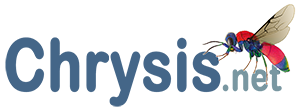



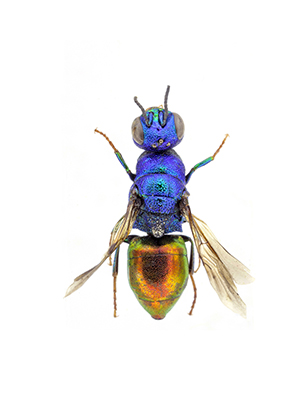 From: Kimsey L.S. & Bohart R.M., 1990 (1991) - The chrysidid wasps of the world. Oxford University Press, ix-652 pp.
From: Kimsey L.S. & Bohart R.M., 1990 (1991) - The chrysidid wasps of the world. Oxford University Press, ix-652 pp.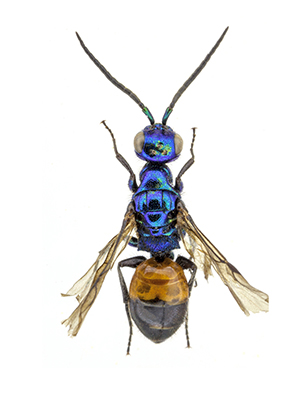 From: Kimsey L.S. & Bohart R.M., 1990 (1991) - The chrysidid wasps of the world. Oxford University Press, ix-652 pp.
From: Kimsey L.S. & Bohart R.M., 1990 (1991) - The chrysidid wasps of the world. Oxford University Press, ix-652 pp.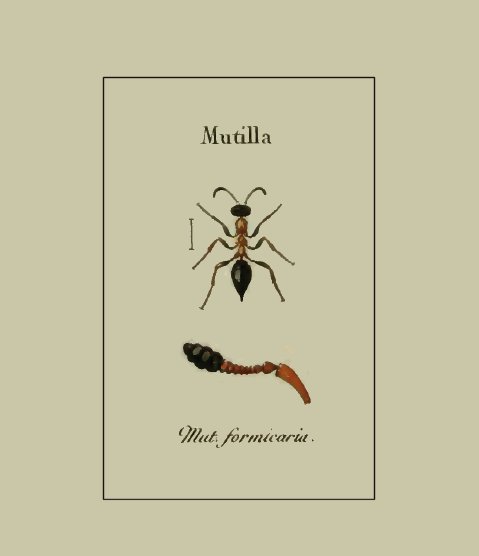
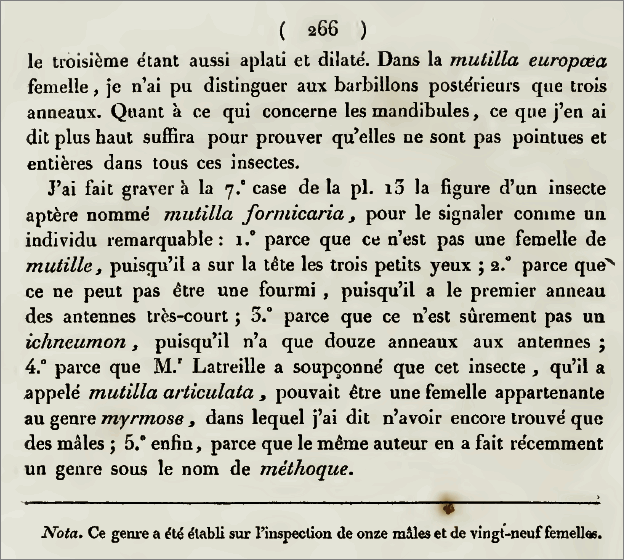
![“Methoca [sic] ichneumonides” by J. Curtis, 1824 – British Entomology](https://www.chrysis.net/wp-content/uploads/2020/01/Curtis_big-637x1024.jpg)
![“Methoca [sic] ichneumonides” by J. Curtis, 1824 – British Entomology](https://www.chrysis.net/wp-content/uploads/2020/01/Curtis_text-578x1024.gif)
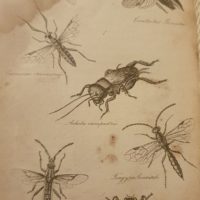
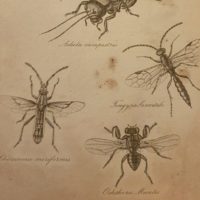
![“Methoca [sic] ichneumonides” by J. Curtis, 1824 – British Entomology “Methoca [sic] ichneumonides” by J. Curtis, 1824 – British Entomology](https://www.chrysis.net/wp-content/uploads/2020/01/Curtis_big-200x200.jpg)
![“Methoca [sic] ichneumonides” by J. Curtis, 1824 – British Entomology “Methoca [sic] ichneumonides” by J. Curtis, 1824 – British Entomology](https://www.chrysis.net/wp-content/uploads/2020/01/Curtis_text-200x200.gif)
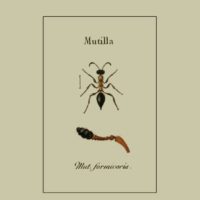
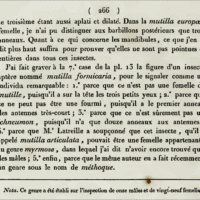
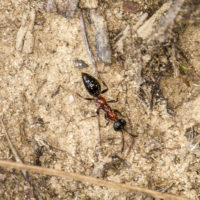
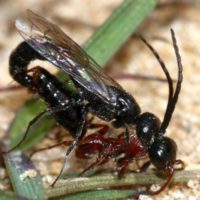
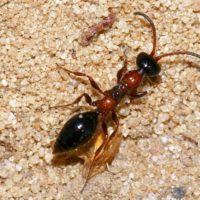
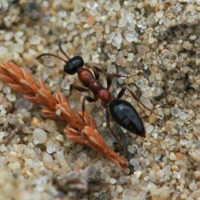
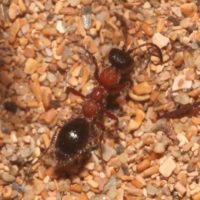
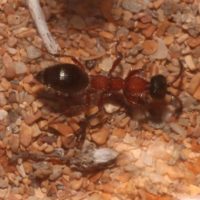
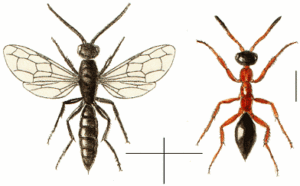
 Taxonomy
Taxonomy Methocha females prey on ant-eating cicindelid larvae, which are commonly found in burrows along sandy soils. Initially, the wasp enters the burrow of the tiger beetle larva and is quickly caught in the predator's deadly mandibles. But, thanks to its thin body that mimics an ant, it is able to escape the predator's mandibles and to sting the larva in order to paralyze it. During the fight, the beetle larva can leave its burrow, but after the sting the Methocha wasp is able to drag the larva back into its own burrow. Once there, the wasp lays and glues an egg on the paralyzed tiger beetle larval body, then seals the entrance to the burrow with soil particles. The Methocha larva develops within 2-3 weeks and eats the paralyzed larva.
Methocha females prey on ant-eating cicindelid larvae, which are commonly found in burrows along sandy soils. Initially, the wasp enters the burrow of the tiger beetle larva and is quickly caught in the predator's deadly mandibles. But, thanks to its thin body that mimics an ant, it is able to escape the predator's mandibles and to sting the larva in order to paralyze it. During the fight, the beetle larva can leave its burrow, but after the sting the Methocha wasp is able to drag the larva back into its own burrow. Once there, the wasp lays and glues an egg on the paralyzed tiger beetle larval body, then seals the entrance to the burrow with soil particles. The Methocha larva develops within 2-3 weeks and eats the paralyzed larva.